Download Duke Nukem 3D: Blast Radius (last update: 03/04/2024; v. 5.0.2)
After assessing a first glimpse at the European progression of the apparent invasion in Pula, Croatia, Duke Nukem borrows one more bus towards, this time, Parisian enlightenment. Level 7 out of 14 in Blast Radius: "Lights, Camera, Revolution" plays on the illuminated set that is a Build engine recreation of the Museum of Modern Arts of the French capital: Palais de Tokyo and its surroundings... Until Duke discovers his first entryway to below ground and its surprises, including some fresh alien guts for him to exhibit.
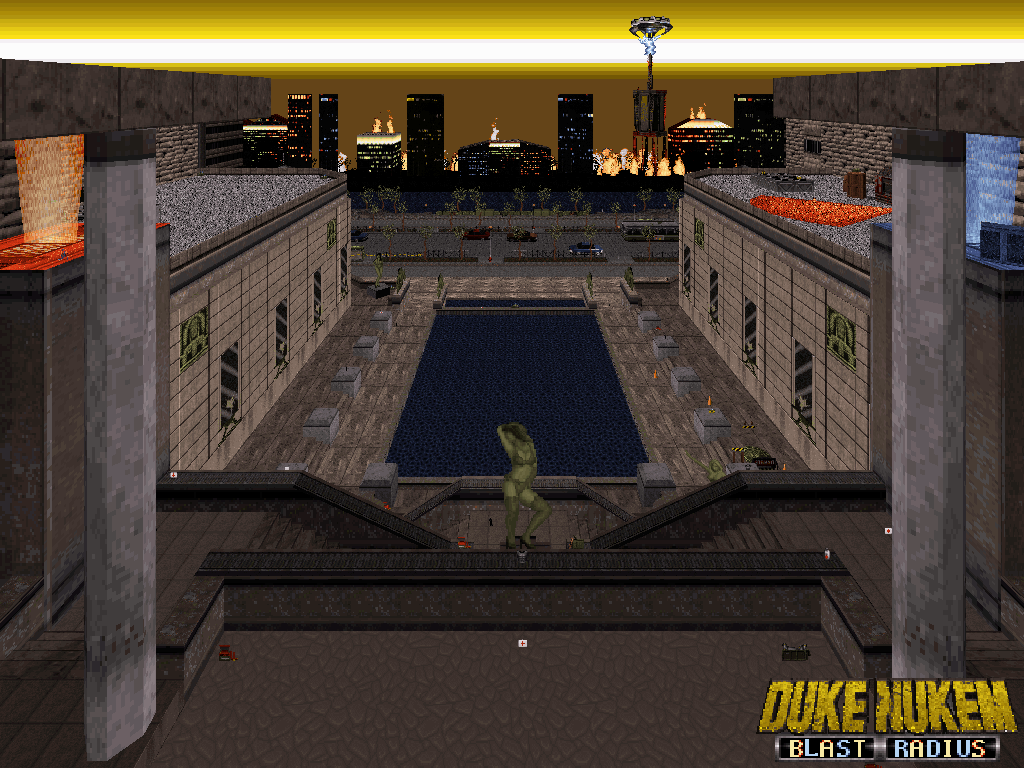

History: "Lights, Camera, Revolution" was the second map made for Blast Radius, chronologically, started right after level 3 "Big Apple Smoke Toke" was completed and preceding level 9 "Nakano Nightmare" which was the third. It was started on December 16th, 2019 but most of the construction occurred throughout April and May of 2020 after a three-month break from the project. It was completed on May 22nd.
(Casual reminder: anyone interested in the thorough history of Blast Radius can easily retrace it via the Duke4.net forums and most particularly this dedicated dev thread.)
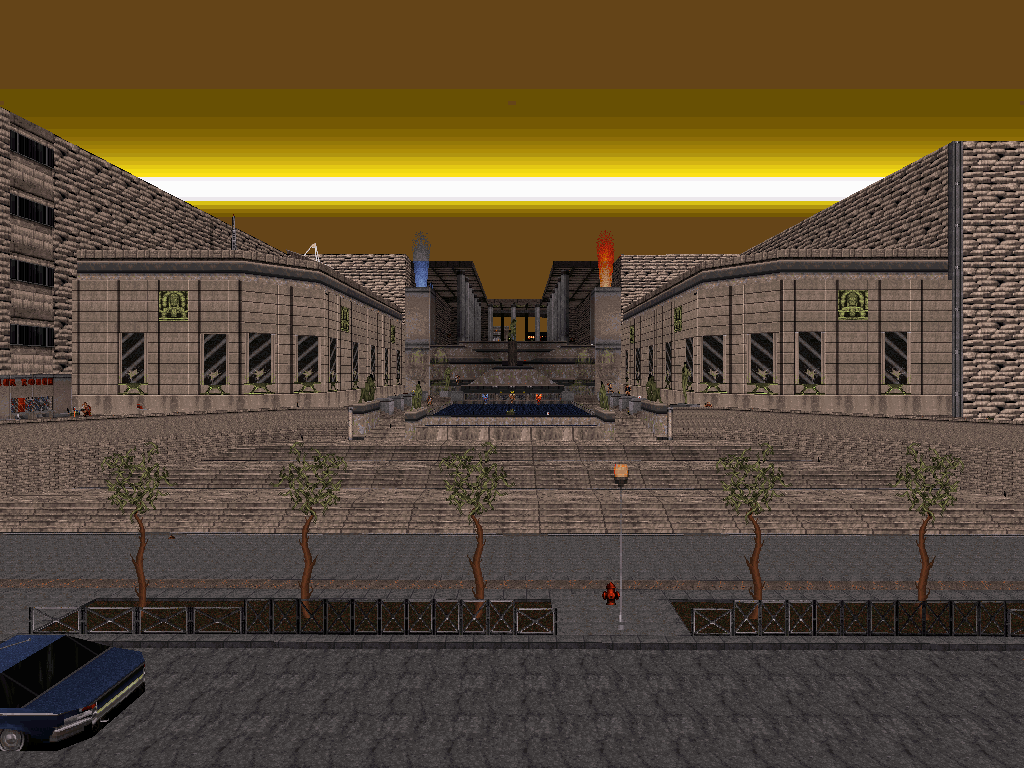
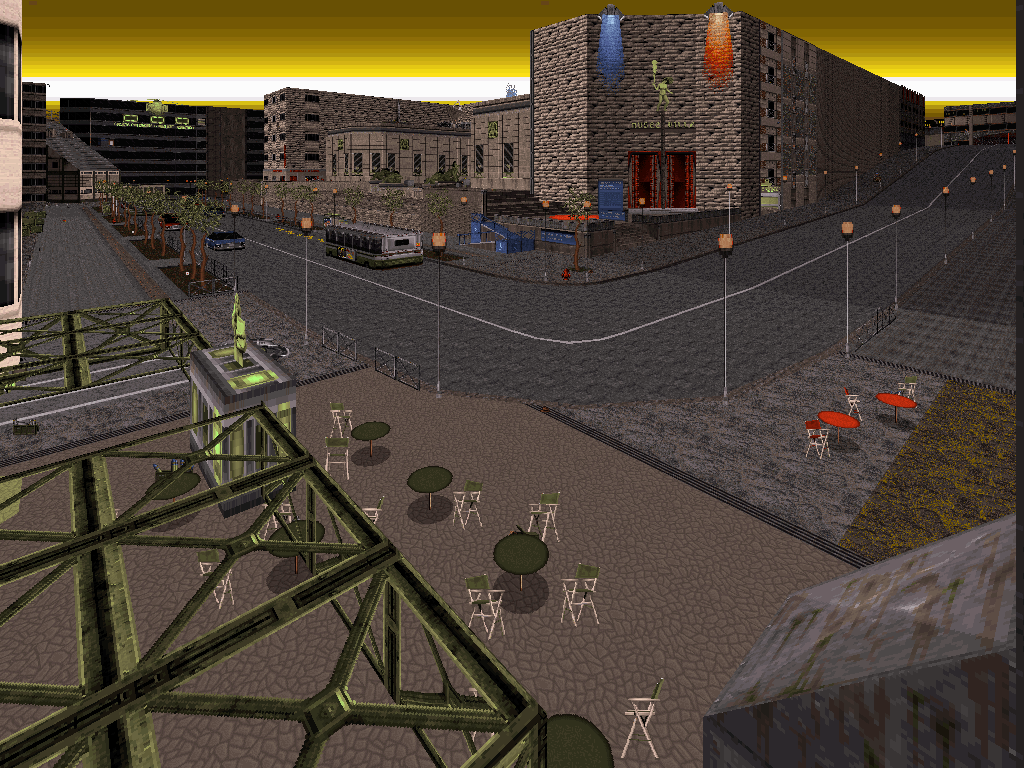
Its title shamelessly borrows from the eponymous Suicidal Tendencies album, all of its three mentioned notions commonly being associated with France and Paris in particular, but the music heard throughout is the .mid version of a classic 1966 hit song by Michel Polnareff.
See: the Soundtrack subsection, below, for extended commentary on that choice (it's not just a JoJo reference).
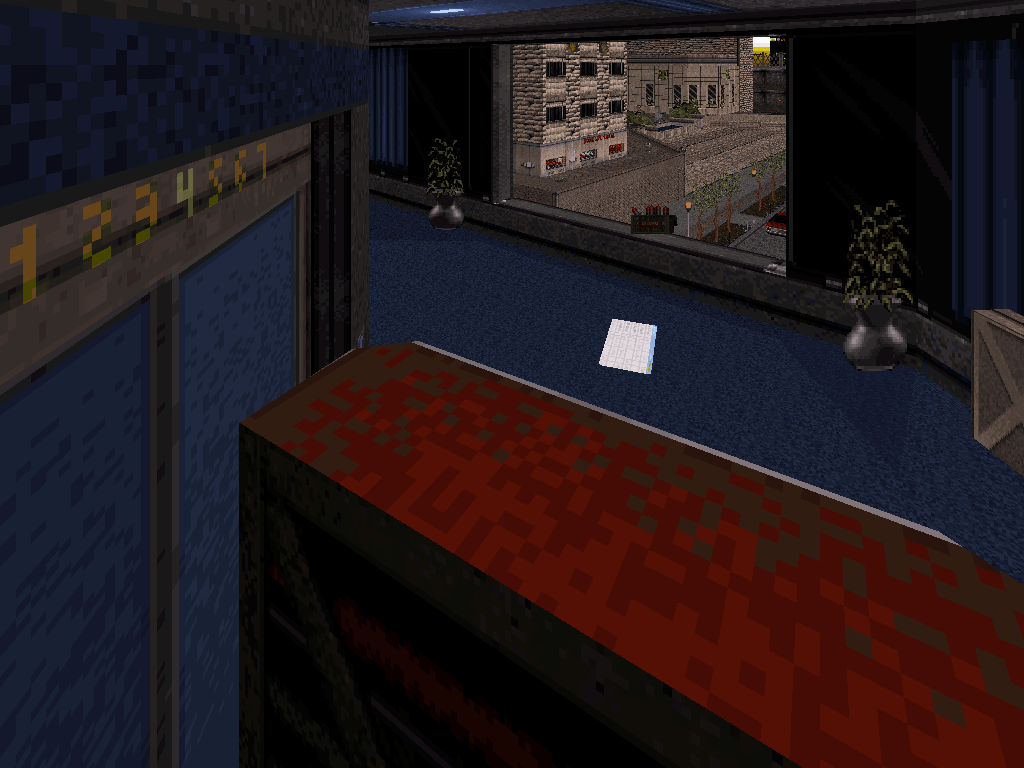
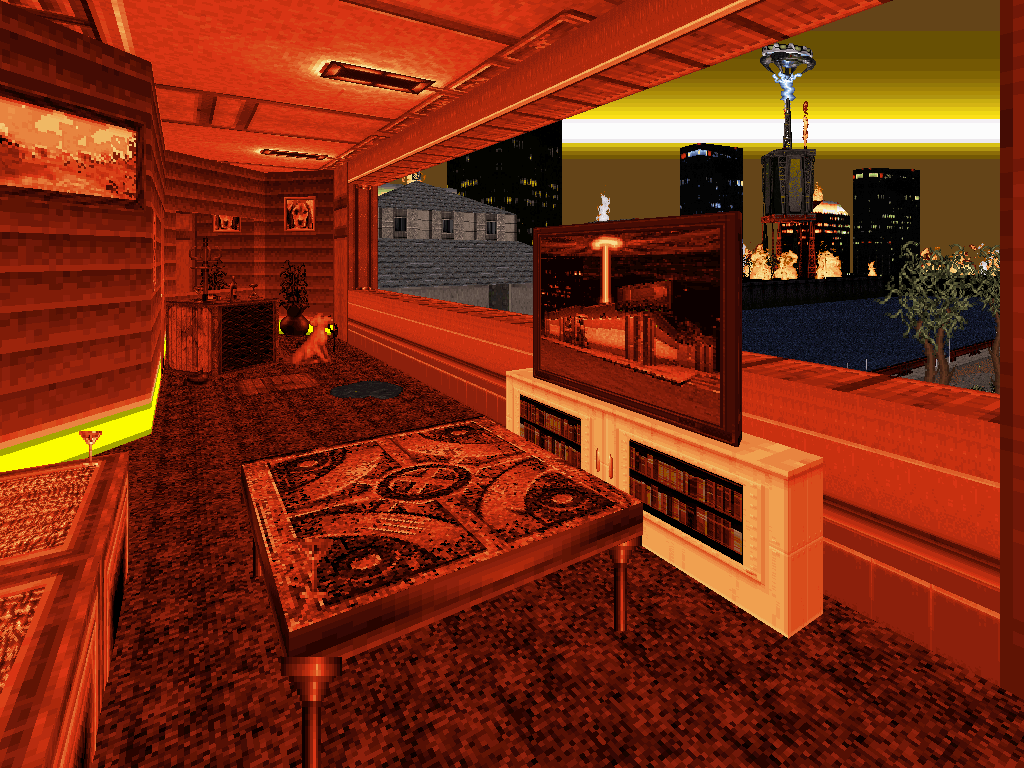
"Lights, Camera, Revolution" shares with "Big Apple Smoke Toke" the trait that having been one of the project's earliest made maps, all the while already sticking to an increasingly clear central theme, story and design style for a coherent direction throughout the episode, it dares experiment in rather exotic ways as far as progression is concerned, all the while brimming with the most Easter eggs (not necessarily in secret places) and cultural references.
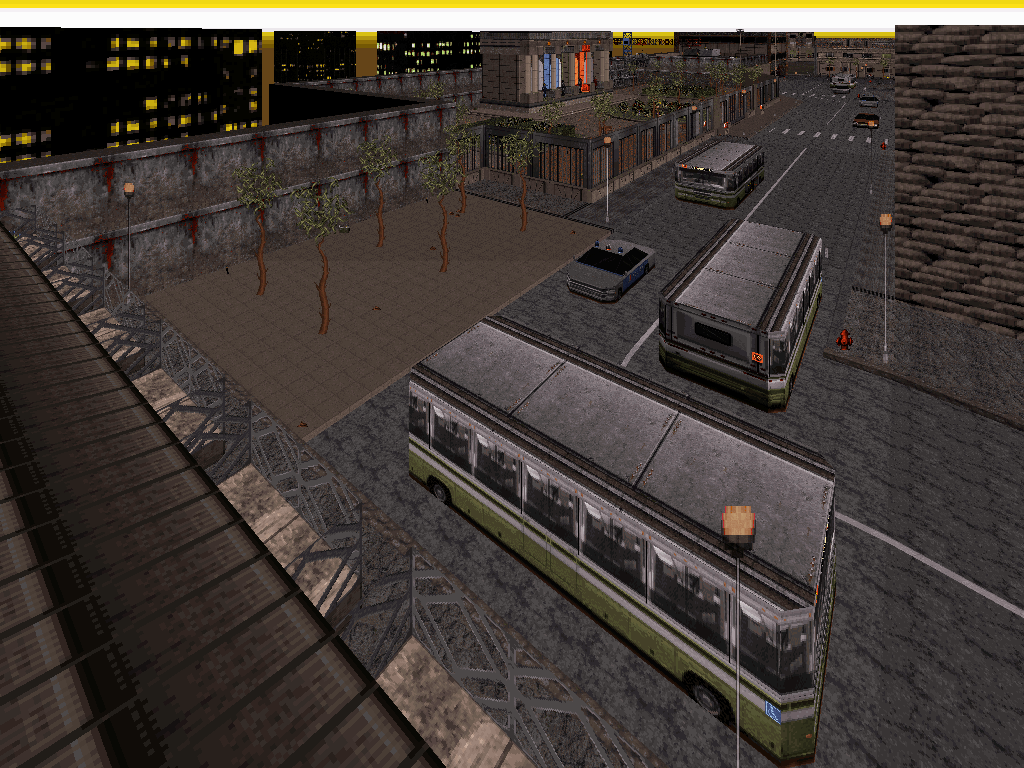
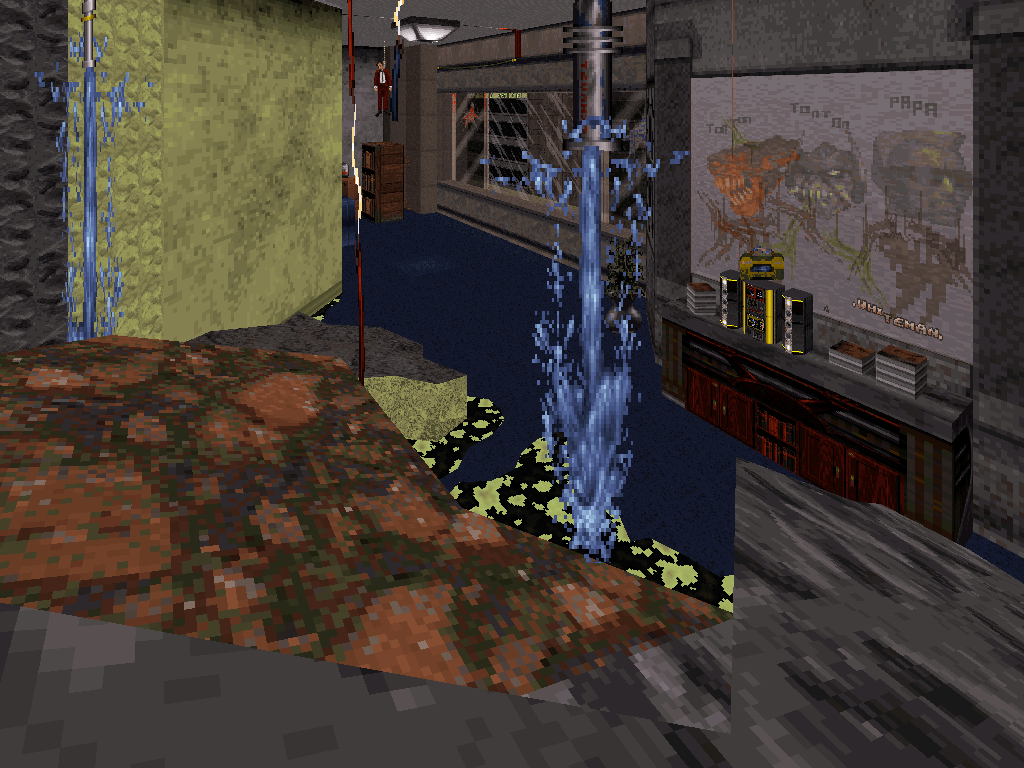
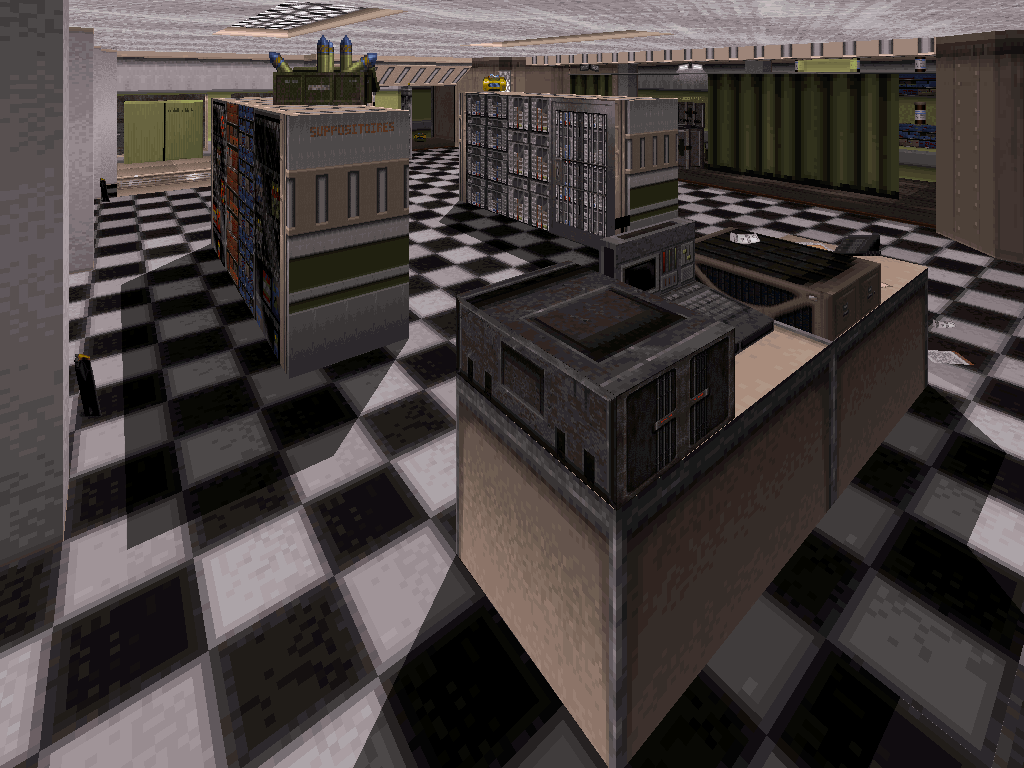
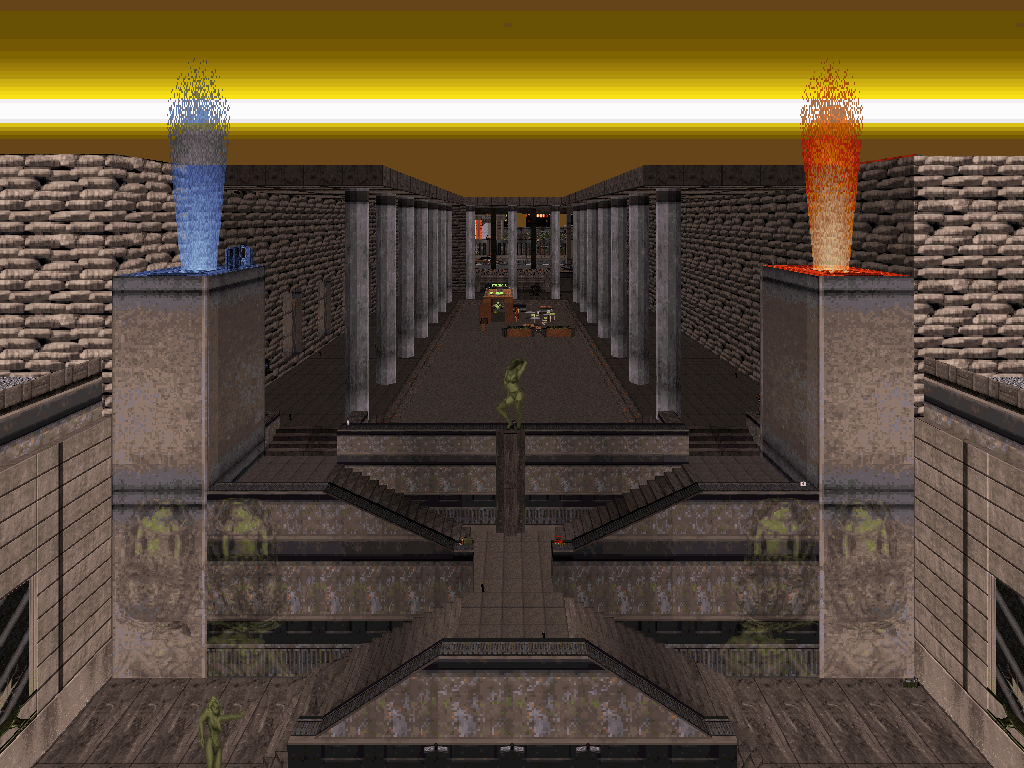
It also relies on a strict, omnipresent tricolor palette that directly references the identity of the French flag and echoes in tone with the local landmark-inspired architectural designs, suggesting an effort at realism which suddenly gets trumped with the introduction of the more conceptual sections that are the contemporary art museum and its exhibitions, and the catacombs.
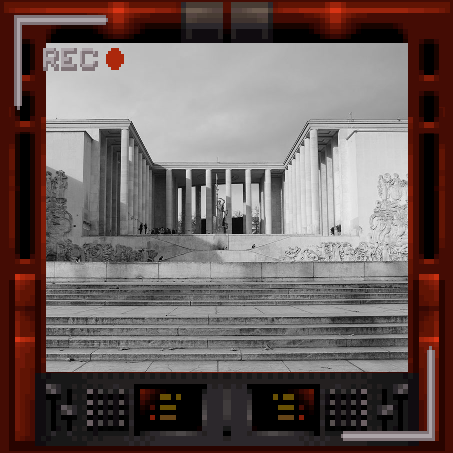
Page from the manual.
With that painted grotesque background (comprising a surreal 'lit' sky) and especially when combined with enemy actor theatrics and some meta art thematics, "Lights, Camera, Revolution" toys with the line of feeling like an interactive stage play. For more on that, see: Particularities, below.
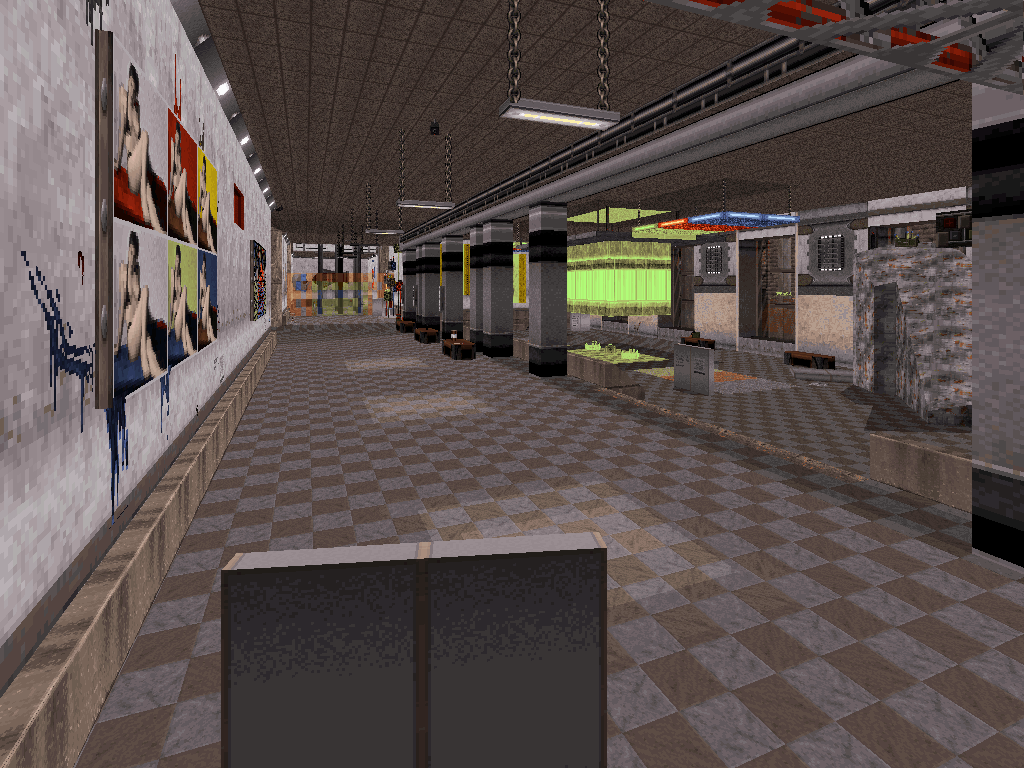
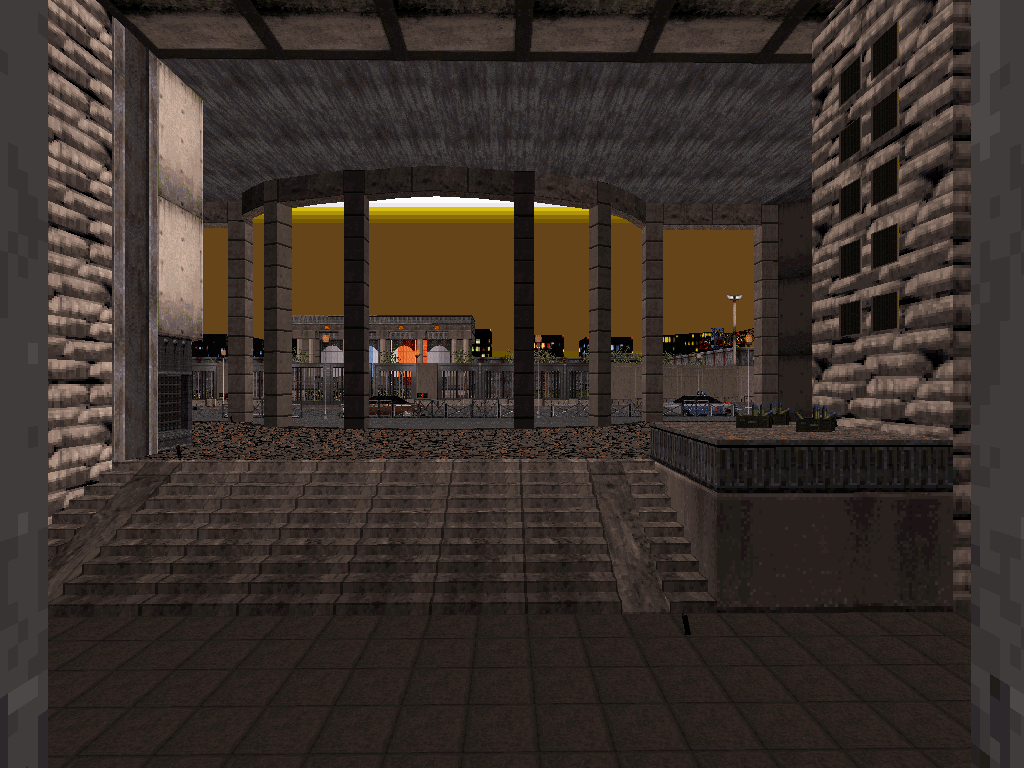
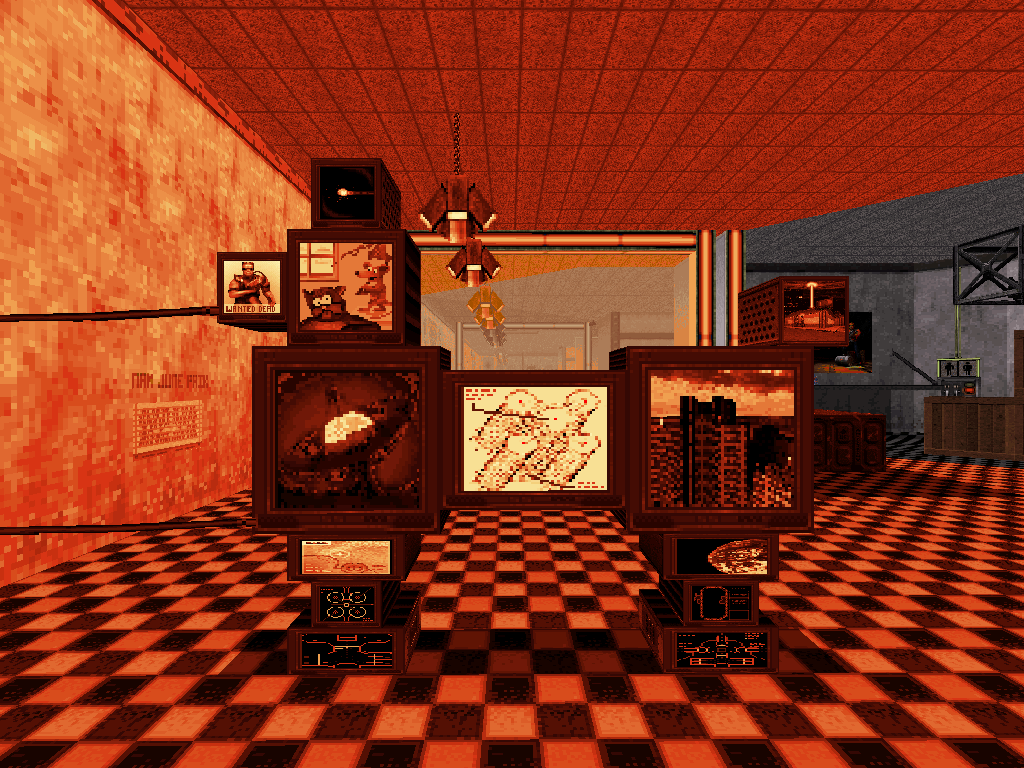

Walkthrough:
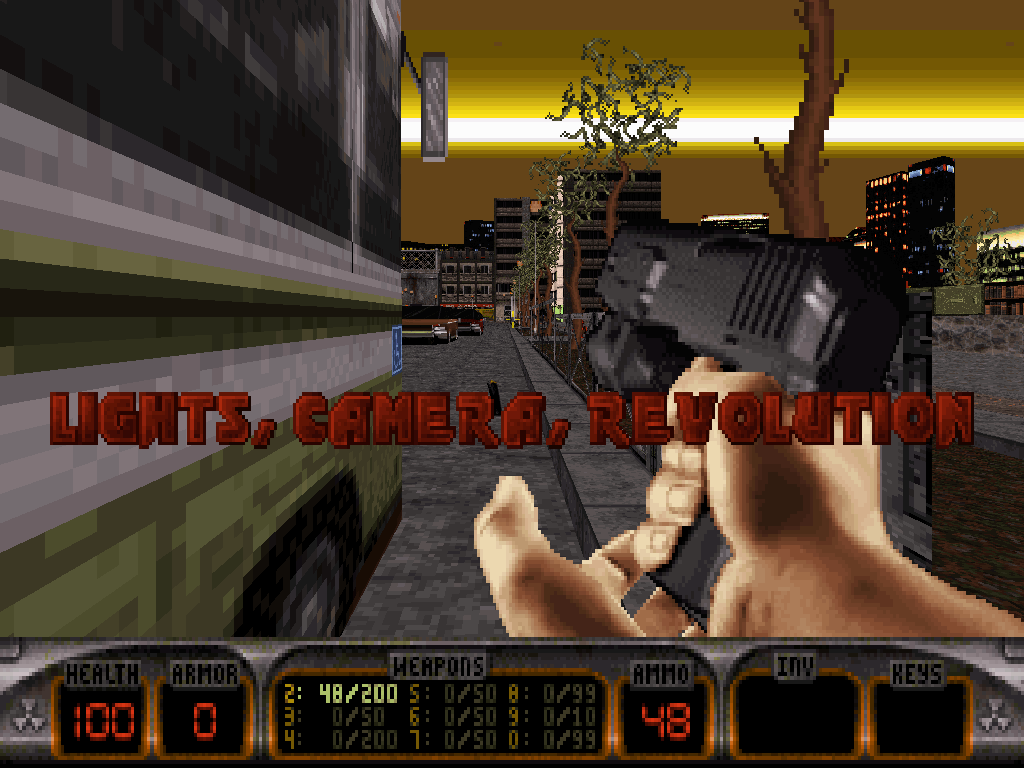
"Do I look French to you?" - baffled to be in such a vibrant-looking environment, Duke cocks his gun nonetheless as he prepares to leave the meager cover provided by the bus. Similarly to the start of "Embarco's Most Blasted", half of Duke's view is blocked until he advances for a couple of steps, thus revealing the true sights and scope of the situation. It might seem easier to control this time around, though - the available terrain looking reassuringly reasonable at first glance.
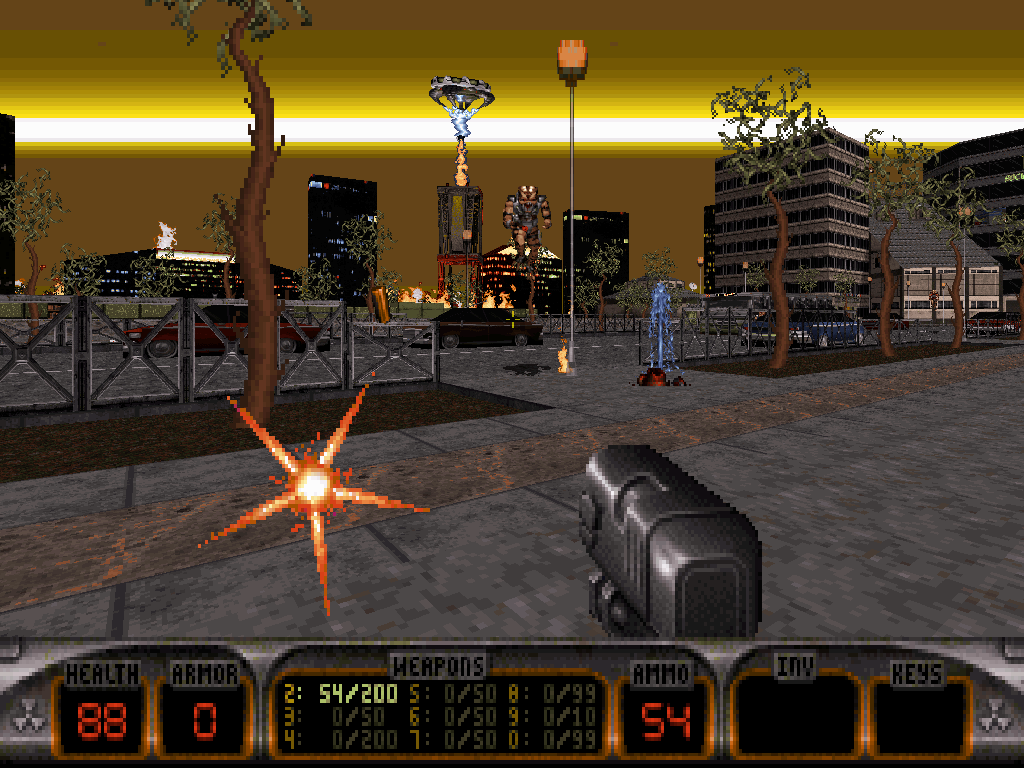
Emerging from behind the bus, Duke shall most likely catch the attention of a nearby group of Assault Trooper variants, including a new, light grey-vested one: the Assault Assaulter, an enhanced version of the Assault Trooper with the exact same health and behavior but the ability to shoot miniature gamma ray bursts; those powerful projectiles travel fast, rebound off every nearby wall before finally bursting into flames, and will cause strong damage to Duke if hit - especially without an armor - in addition to possibly setting him on fire for a moment.
Just like the mortar-throwing Assault Taxi Drivers, Duke shall learn to prioritize disposing of that scum as soon as on sight, or things might promptly get red hot for all parties involved.
From this point on, a lot depends on how equipped Duke is coming into the level.
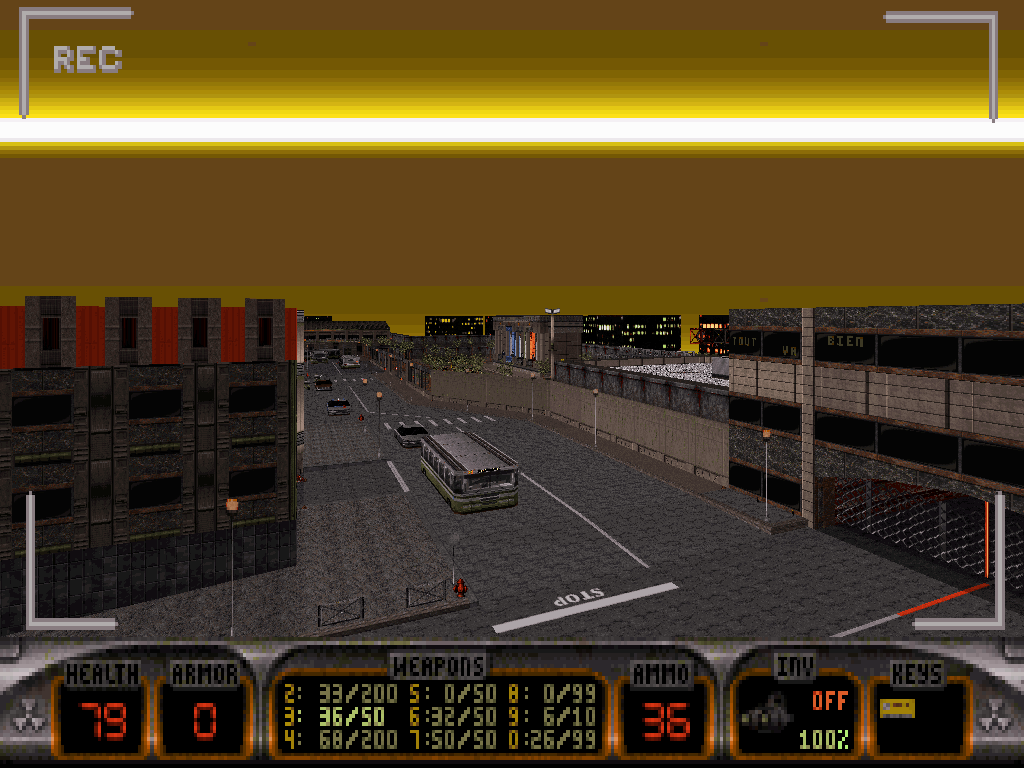
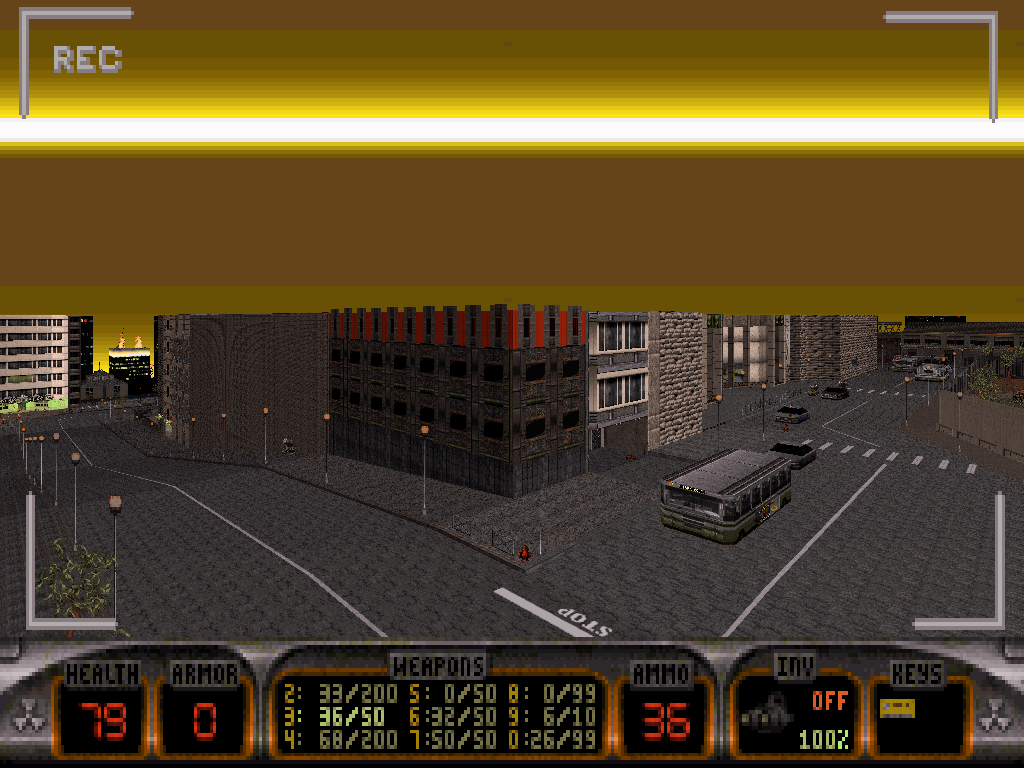
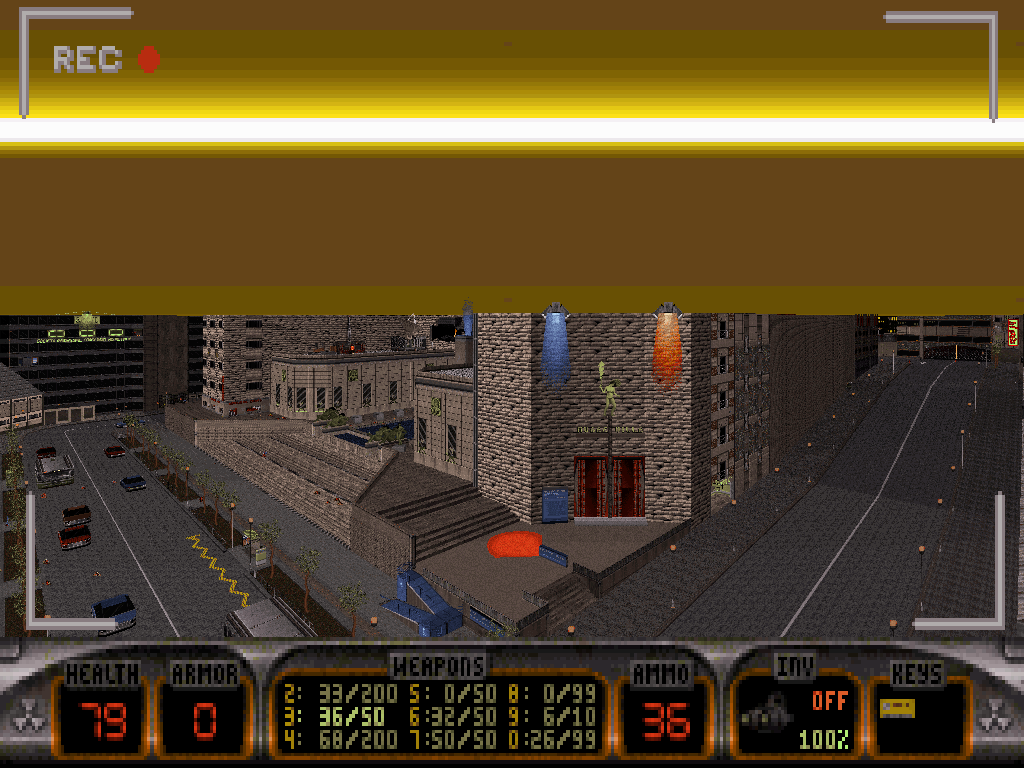
If good on weaponry, then the path up to the north of the map, either through the central plaza or one of the side streets (all options featuring different enemy types), shall take Duke to the entrance of the museum (as well as a glimpse at the red key door across the street) which will open as he gets close - with a distant Sunburnt Battlelord inviting him in from inside, by the means of a Sentry Drone delivery and Microwave Expander ray spam.
The museum should be Duke's first destination - unless his jetpack leftovers and natural impulses to explore drive him to navigate the heights of the entire block already, which might precipitate his encounter with supposedly further findings.
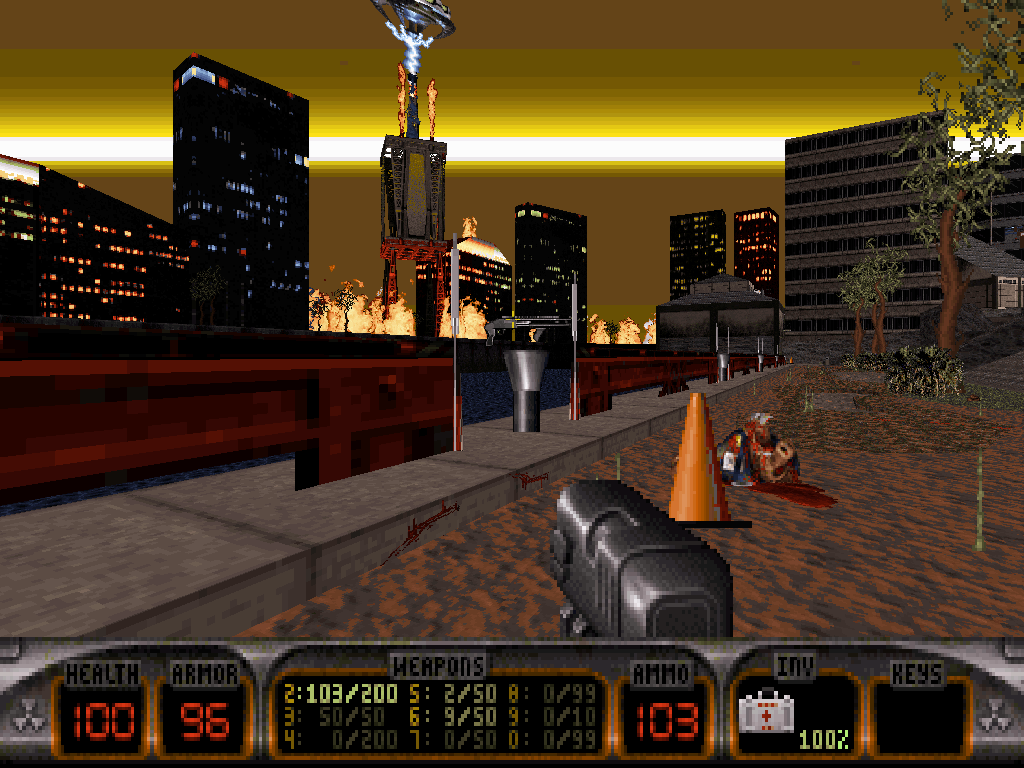
If too lightly armed, Duke can choose to devote a chunky moment to exploring around the street he starts in. Going further south of the map and walking down and along the Seine will have Duke meet more enemies but also fetch some goodies, including a bodied Pig Cop's shotgun.
Coming back up from the Seine around the southeastern corner of the block is a Starbucks Coffee joint where wi-fi is as free as nine euros and some ammunition at the mere cost of cleaning up behind the Ice Cold Commander on the terrace. Some weapons are close by, too.
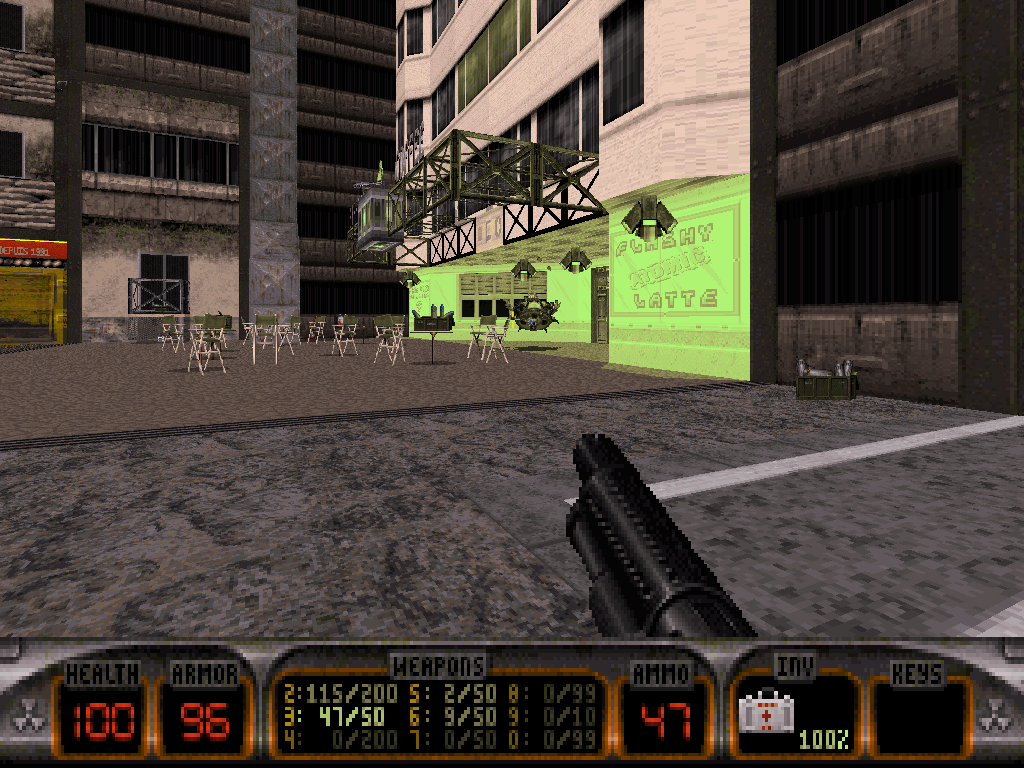
Pushing the zeal as far as sanitizing the entire street corner shall allow Duke enough peace and quiet to start platforming on top of the various props around in order to, eventually, reach the overhanging signage of the coffee joint where the Shrinker is sitting. (Some further exploration from there might or might not reward Duke with some secret rockets.)
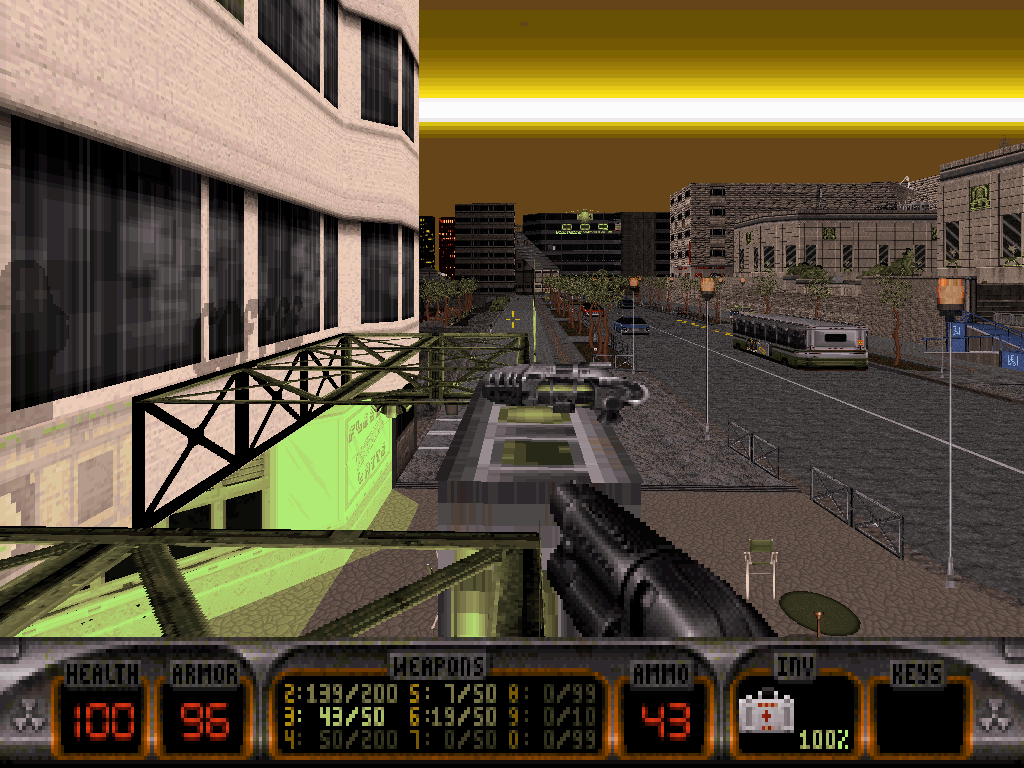
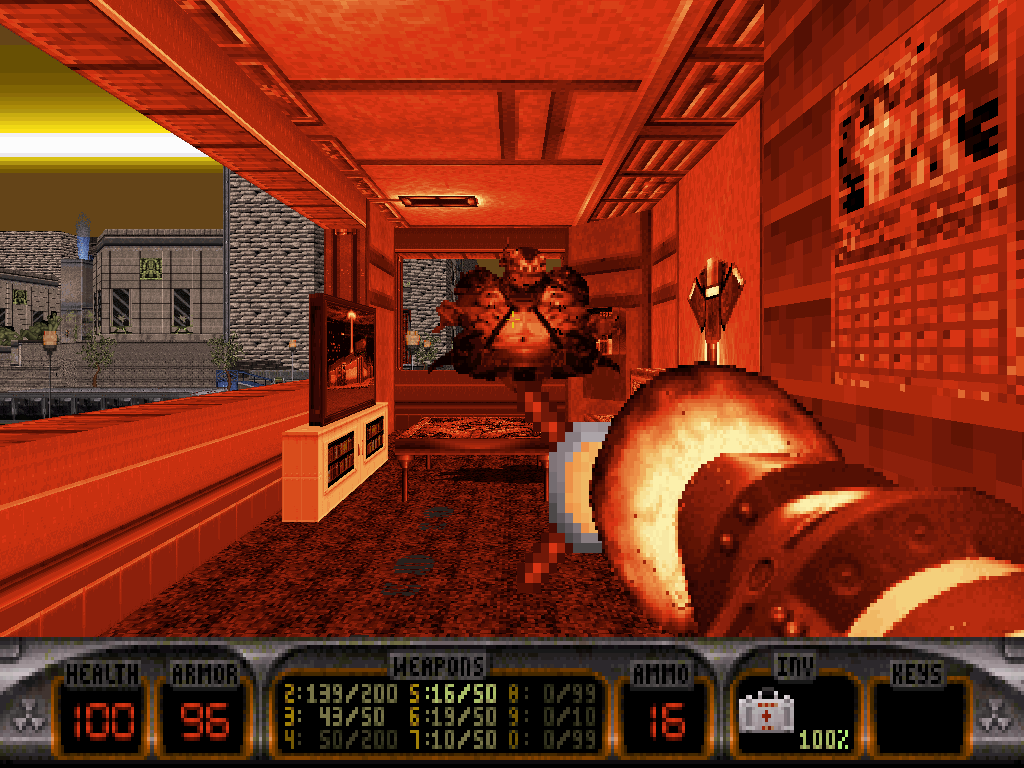
Now as the proud owner of the Shrinker, it may be worthwhile for Duke to visit the bakery (boulangerie pâtisserie) for a local bite, a look into the mirror and also to reveal the private door there (privé).
Getting shrunk in the boulangerie can serve several purposes: somewhere, a secret ventilation shaft probably exists to conceal items but, more crucially, an intricate path through the nearby rooftops, then adjacent office building shall lead Duke to the Devastator (and instant enemy response); that is, under the condition that he first explodes a crack into the door of the privé floor to then shrink himself through.
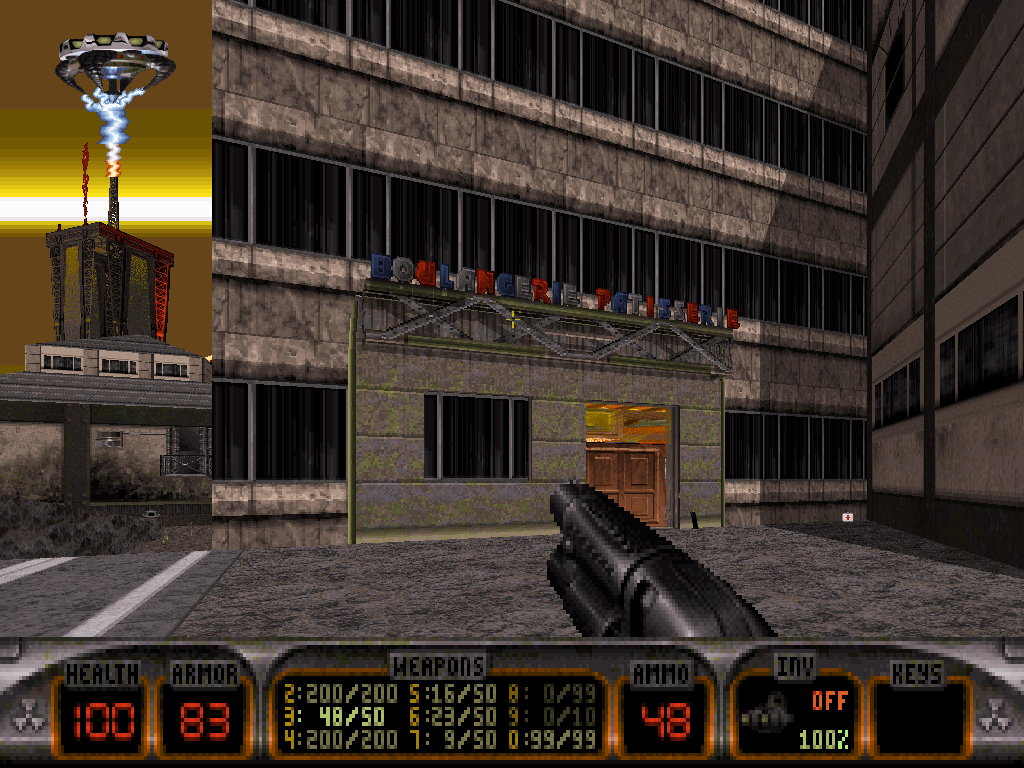
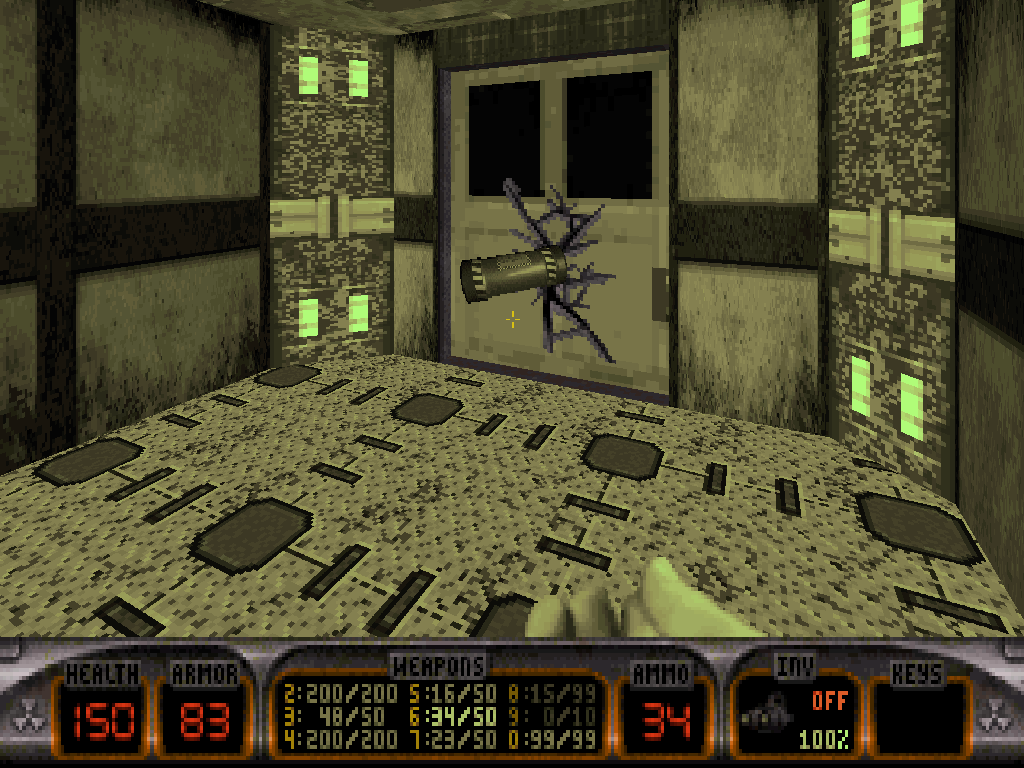
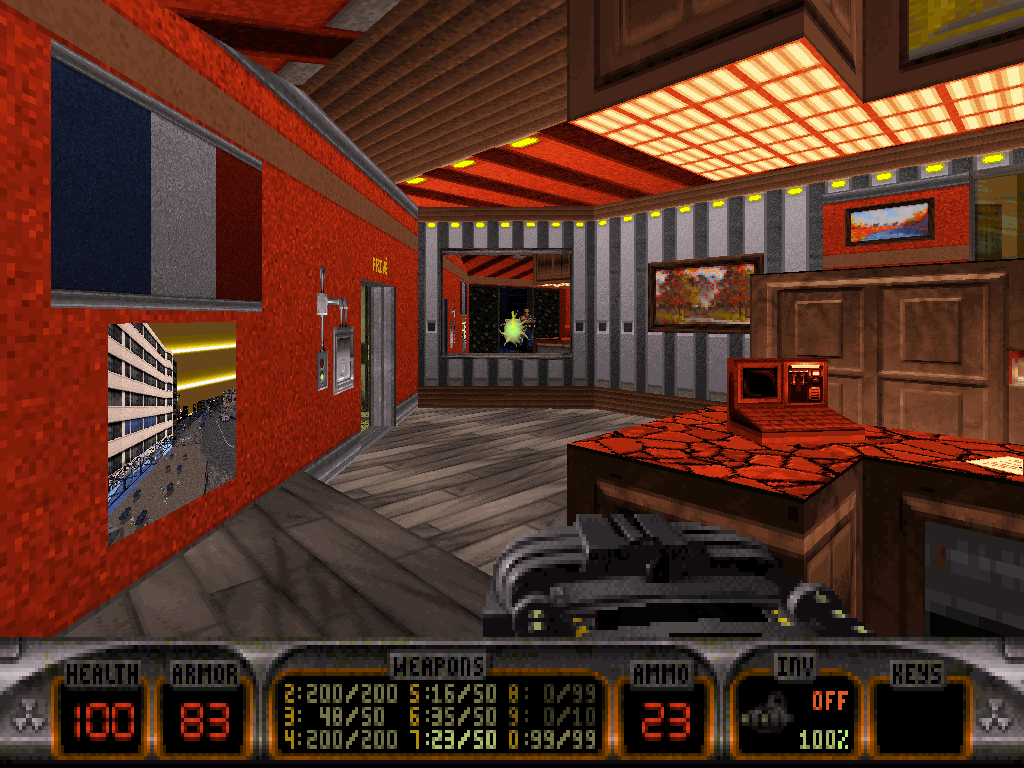
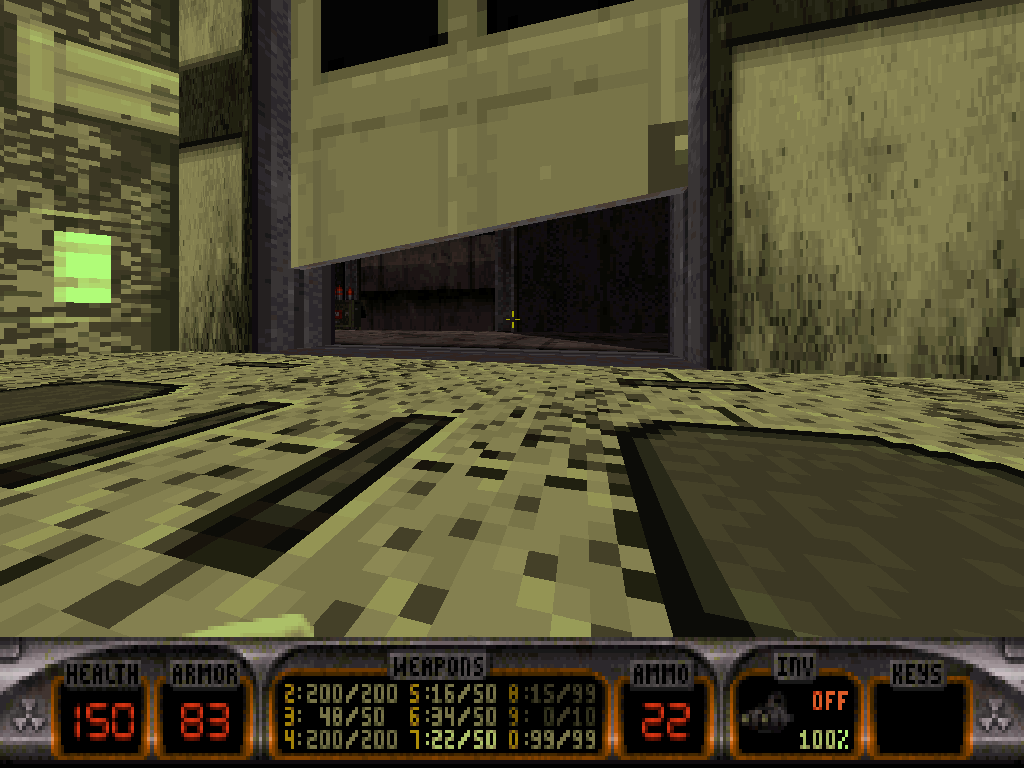
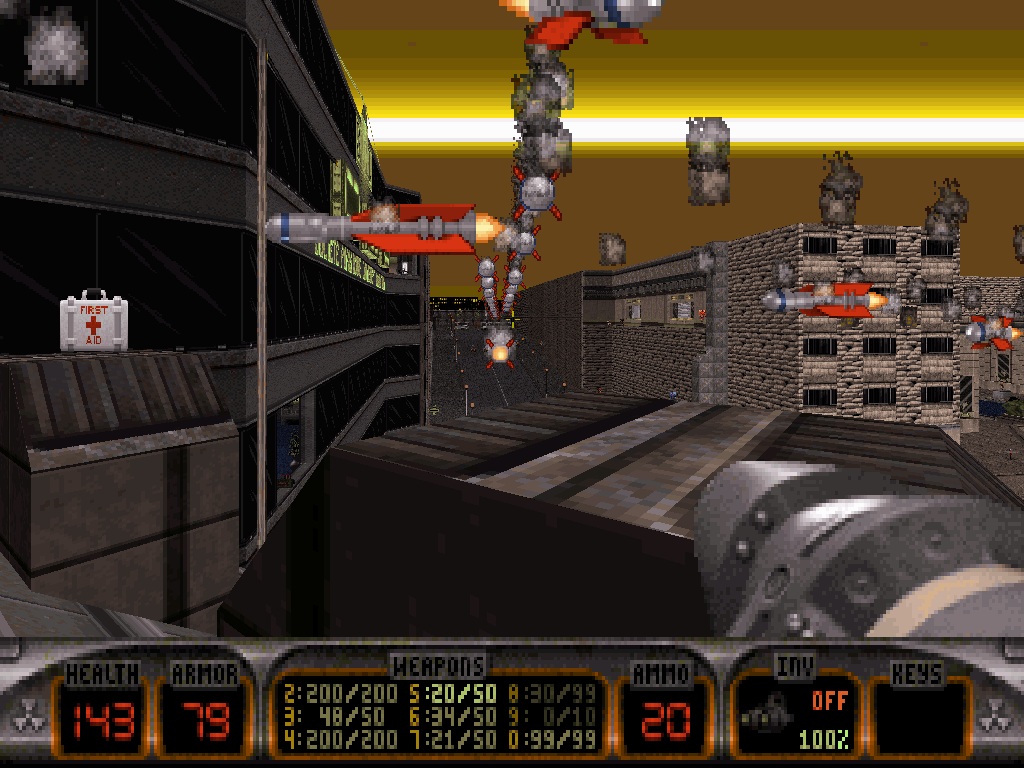
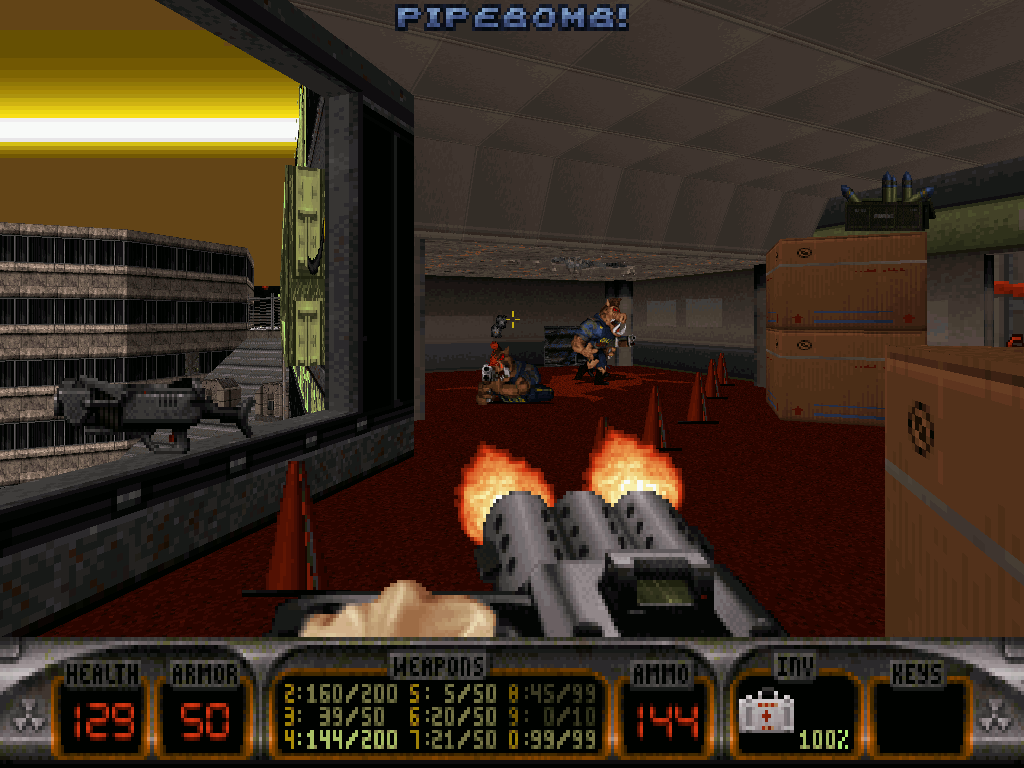
The two side streets which run along both sides of the central plaza are well-guarded, but Duke can disregard that detail and opt for a visit any time he's prepared, which will reveal the existences of two pharmacies. The westernmost one is a secondary pharmarcie de garde and appears to be closed, but still makes for a viable health stash if Duke insists at the door.
The main pharmacy Duke can enter, however, is situated on the easternmost street; the moment he approaches, he might alert some Assault Captains and Generals and their urges to defend the space by sniping Duke from inside.
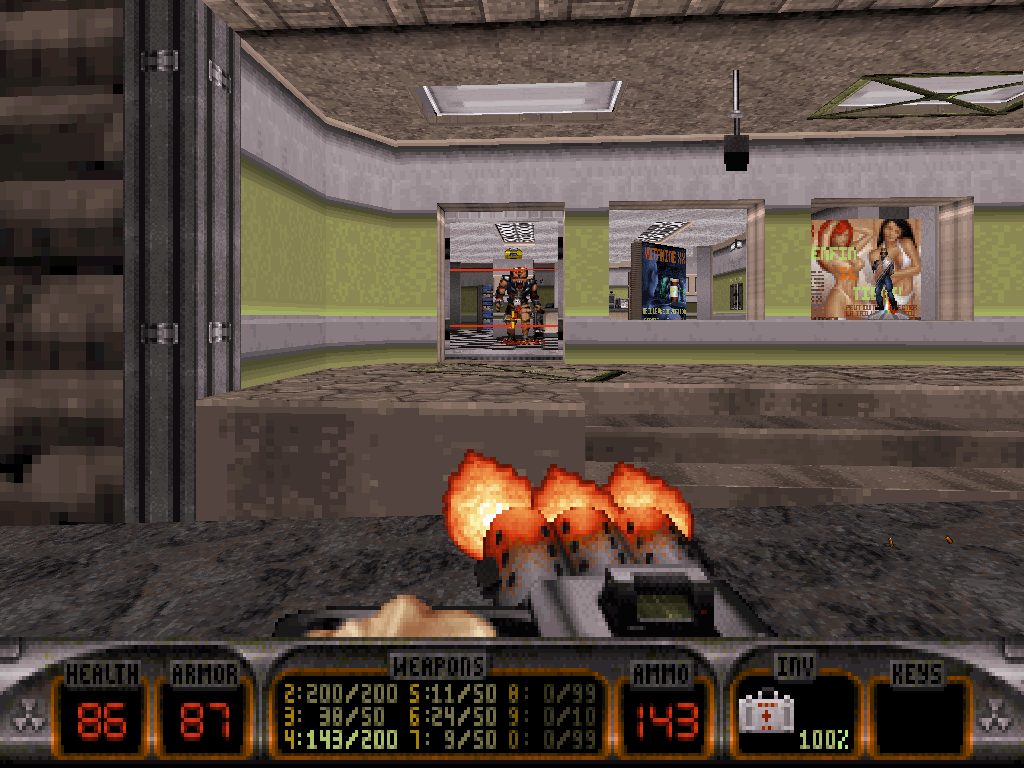
Going up the stairs or the wheelchair ramp just left of the building shall reward Duke with the chaingun there if he ever were to need supplies or feel like completing his collection.
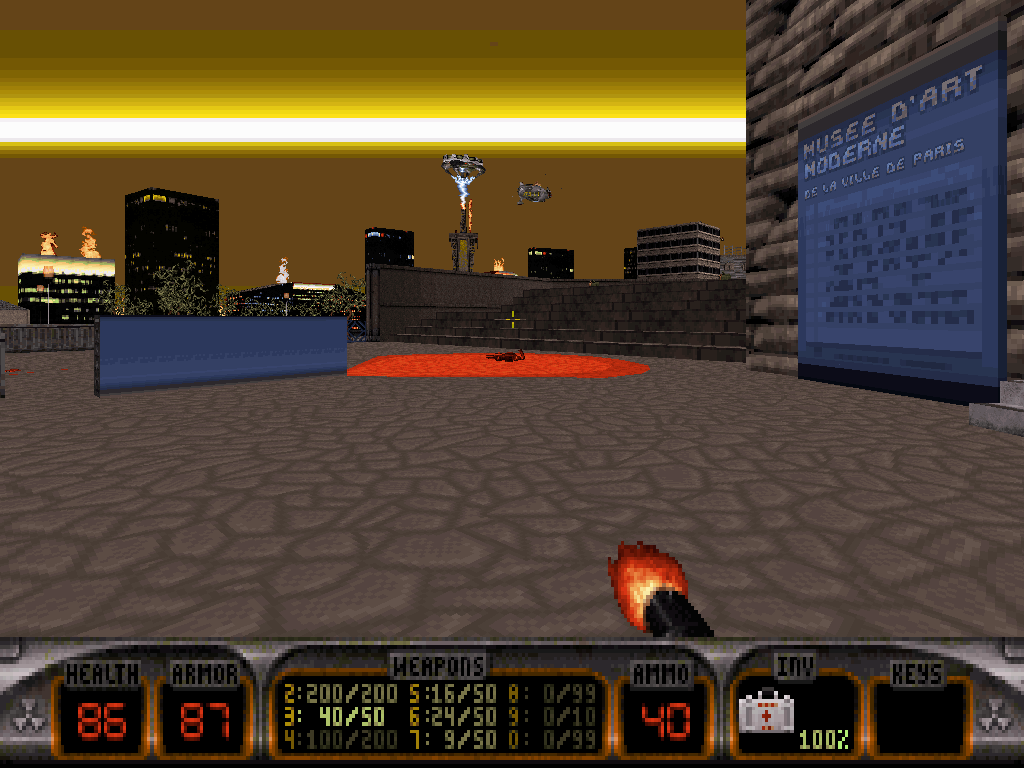
Inside the pharmacy, exploring the back rooms and riding the back elevator up will uncover some interesting findings, including doors which for now remain locked and also the Microwave Expander gun in what seems like a dead-end.
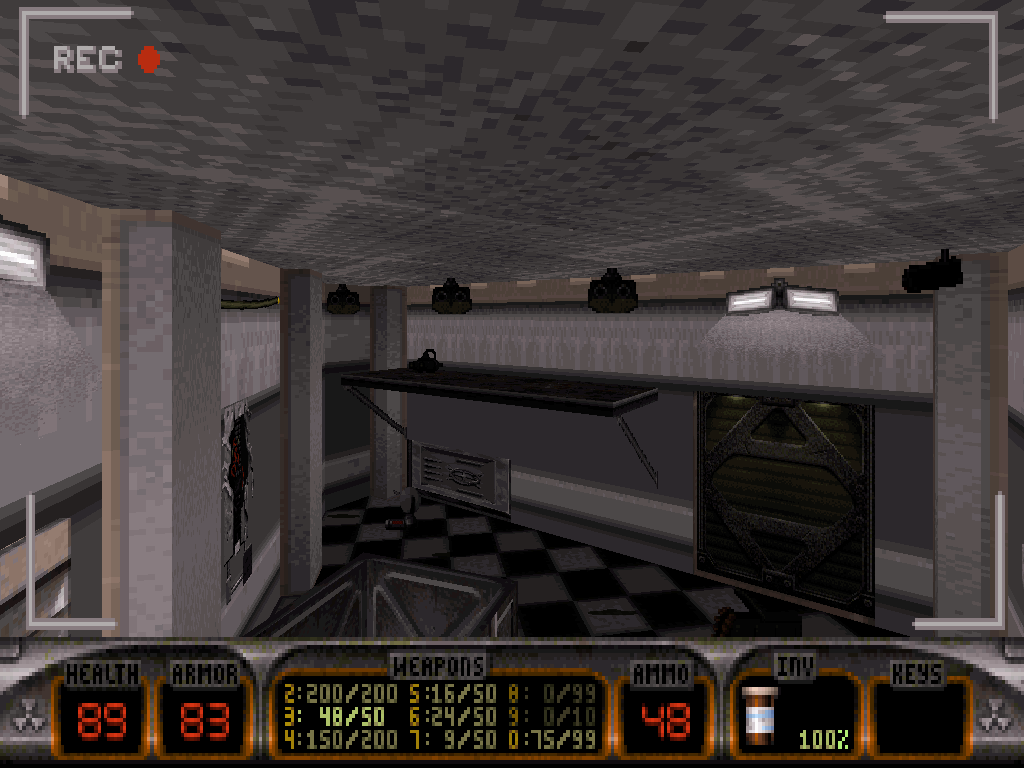
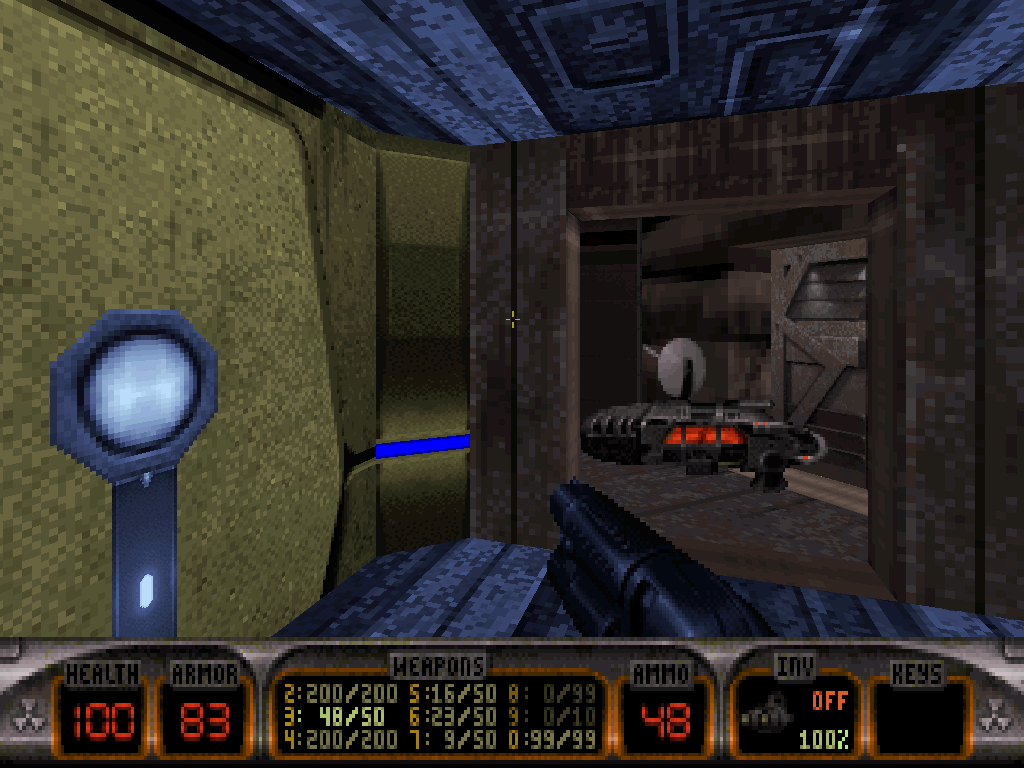
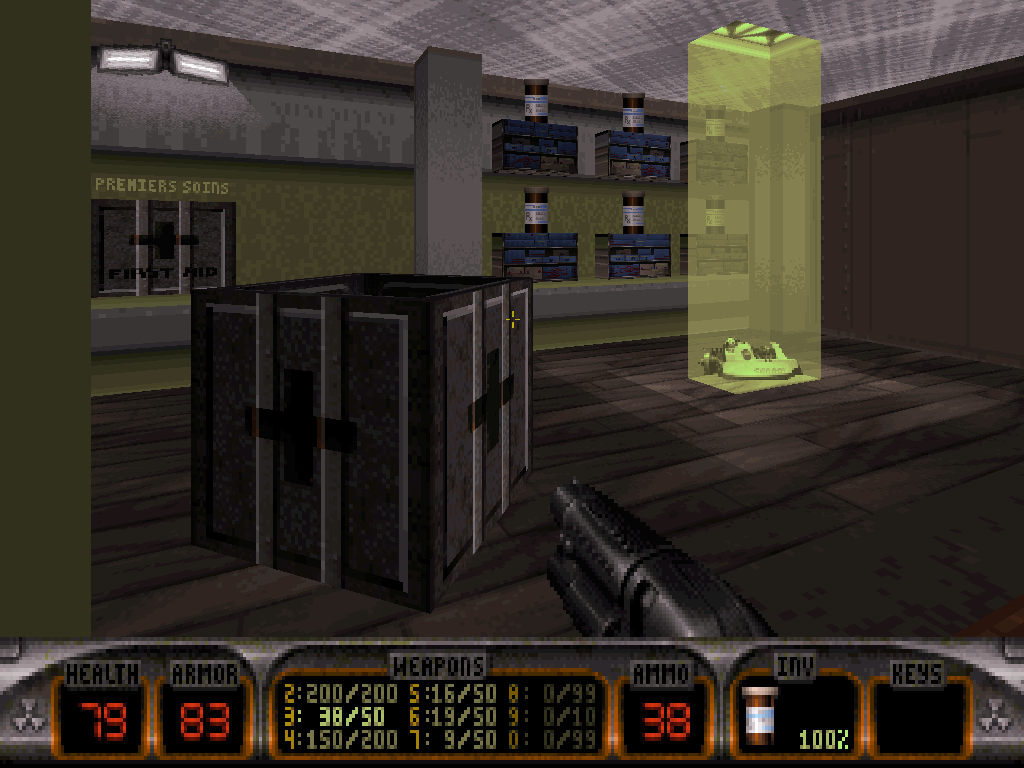
After he's snagged it, Duke is free to get back out on the streets with a clean conscience; as long as he doesn't forget to grab some crucial steroids on his way out, that is; not to mention a Freezethrower just casually chilling downstairs. If Duke happens to shun the latter though, then another one is available from the fountain on the central plaza.
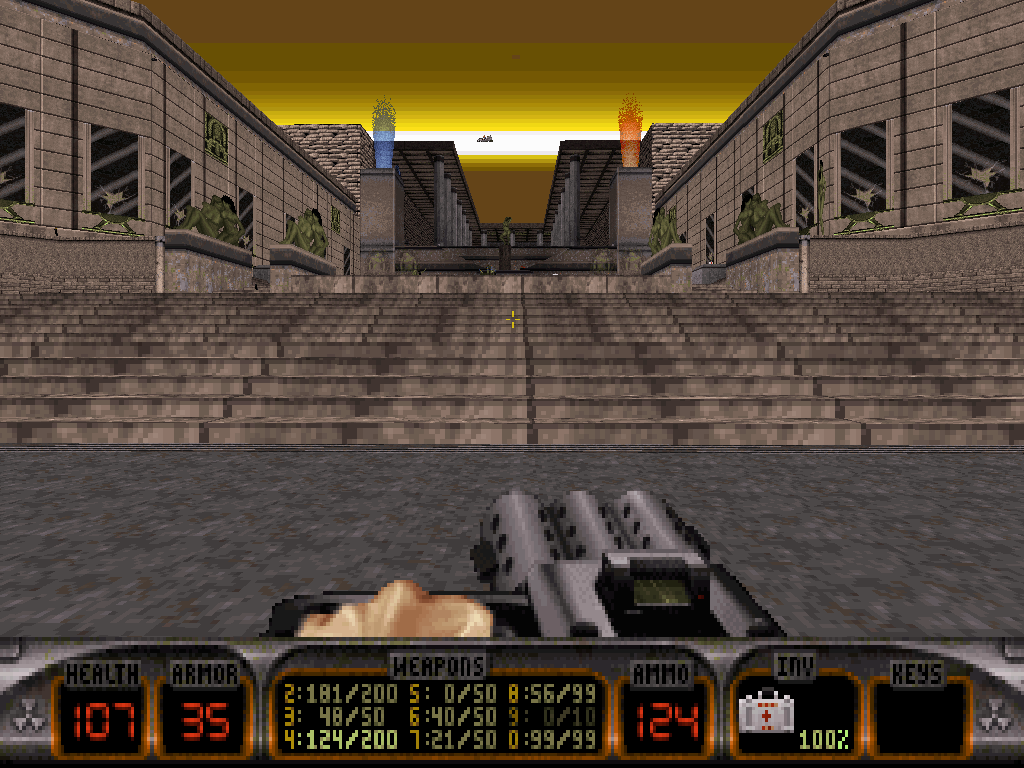
In order to reach the upper, northern section of the block, instead of venturing through the side streets, Duke may also opt for traversing the aforementioned central plaza.
By doing so (on the Come Get Some difficulty setting), he shall meet the Mad Dog 357 Plutonium No.9 Octabrain, a crimson, deadly variant with psychic mastery absolute enough to shoot raw qi blasts (also nicknamed 'balls of awesome' by beta tester The Watchtower; and called FAJIN in the code, making them akin to hadokens in nature).
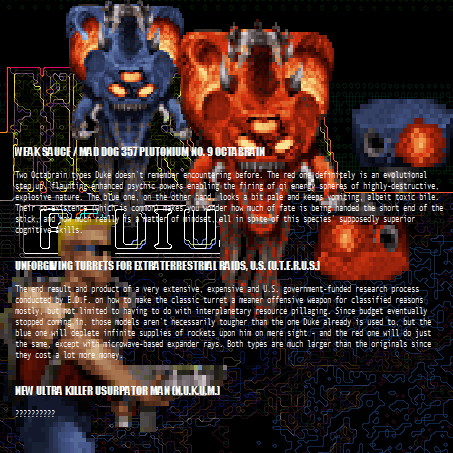
Page from the manual.
Those projectiles travel fast, will rebound off any nearby walls and then disintegrate most foes on contact; its impact being only survivable if armored Duke runs on Atomic Health, it is the strongest and most dreadful projectile in Blast Radius.
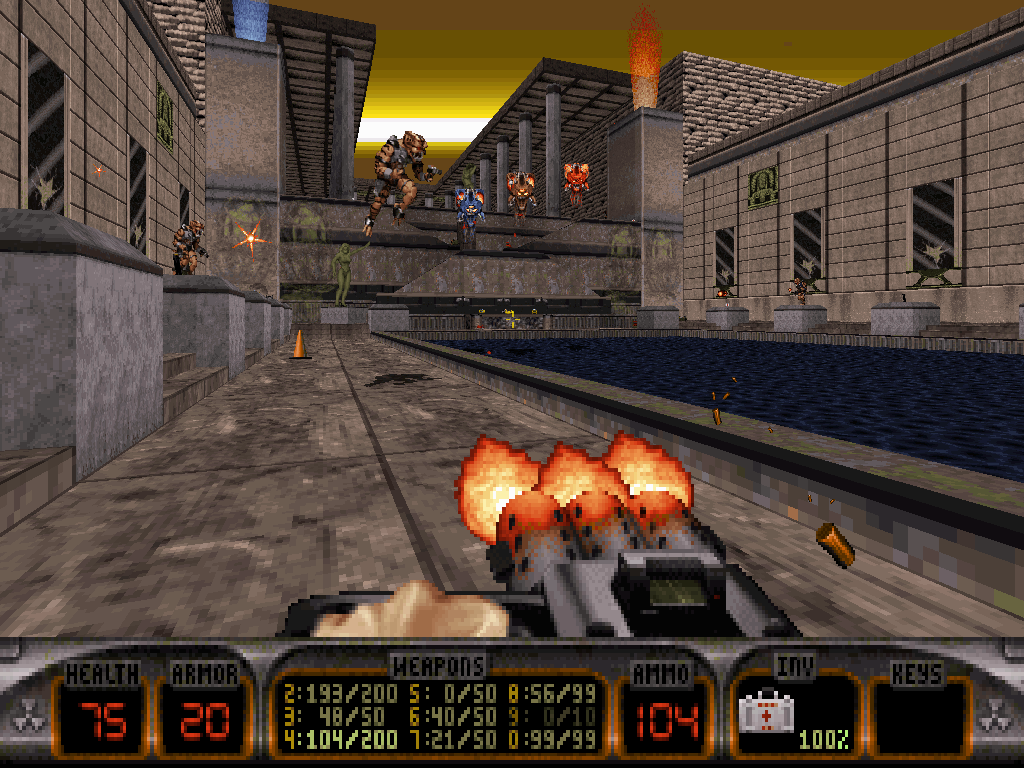
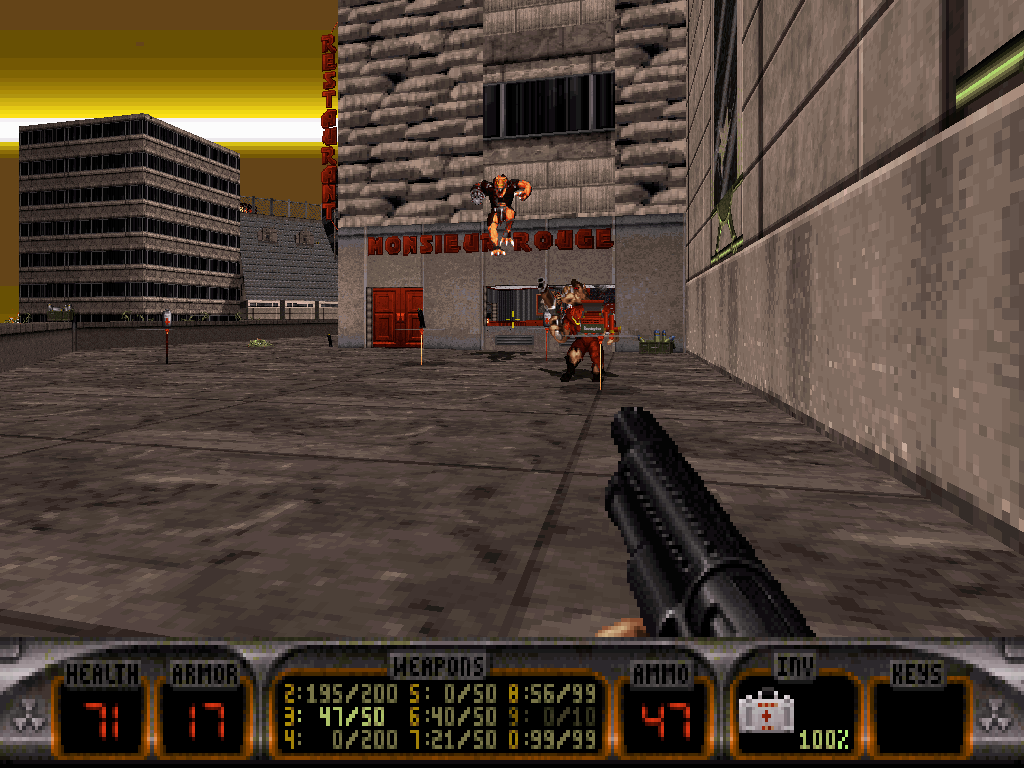
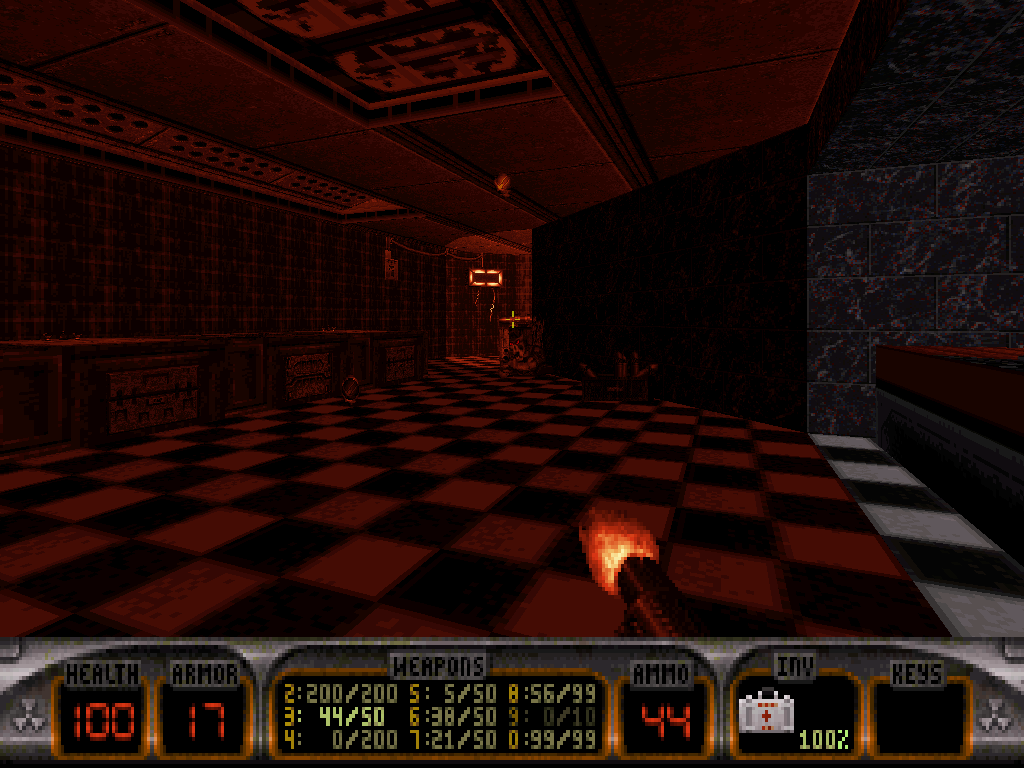
Those new threats are best dealt with rockets fired from either the Devastator or the RPG. If Duke is out of the former, he can retrieve the latter (if he hasn't found any secret one yet) from the Monsieur Rouge restaurant (which mimics the real world on-location lounge, Monsieur Bleu) - as long as he's mindful that it's crowded with red-colored enemies, including a couple of Bomb Squad Pig Cops on dinner break.
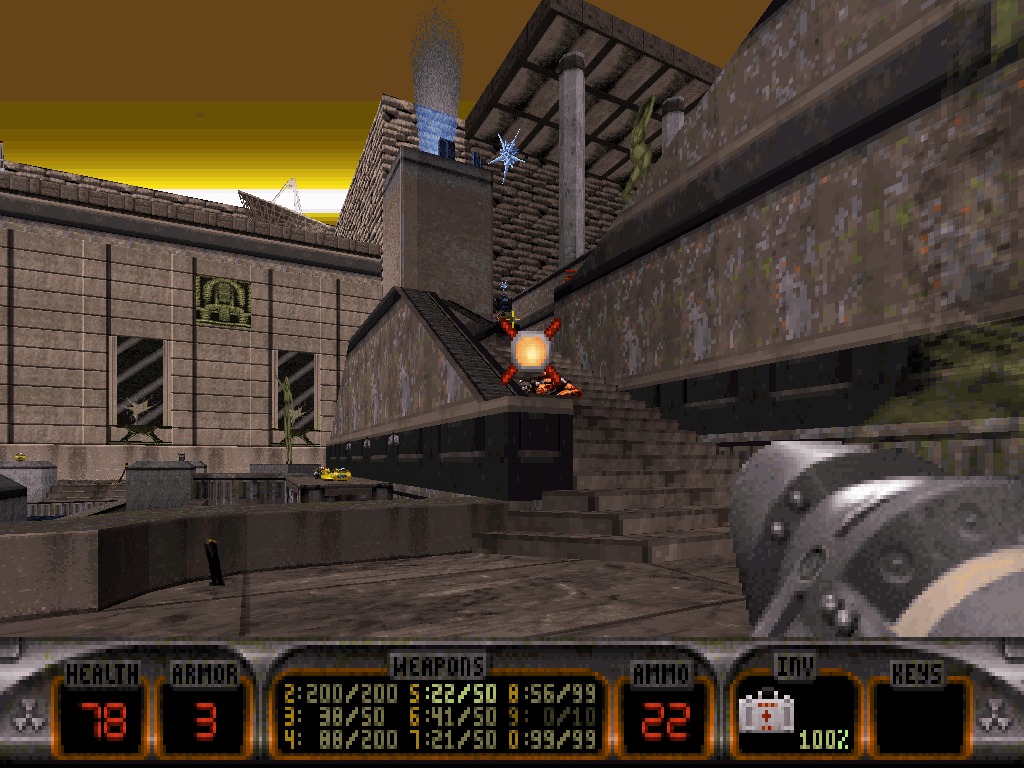
After he's made his way up all the stairs in the middle, Duke shall reach the upper level of the central plaza, thereby dominating over a lot of the level and also meeting some more hardcore resistance.
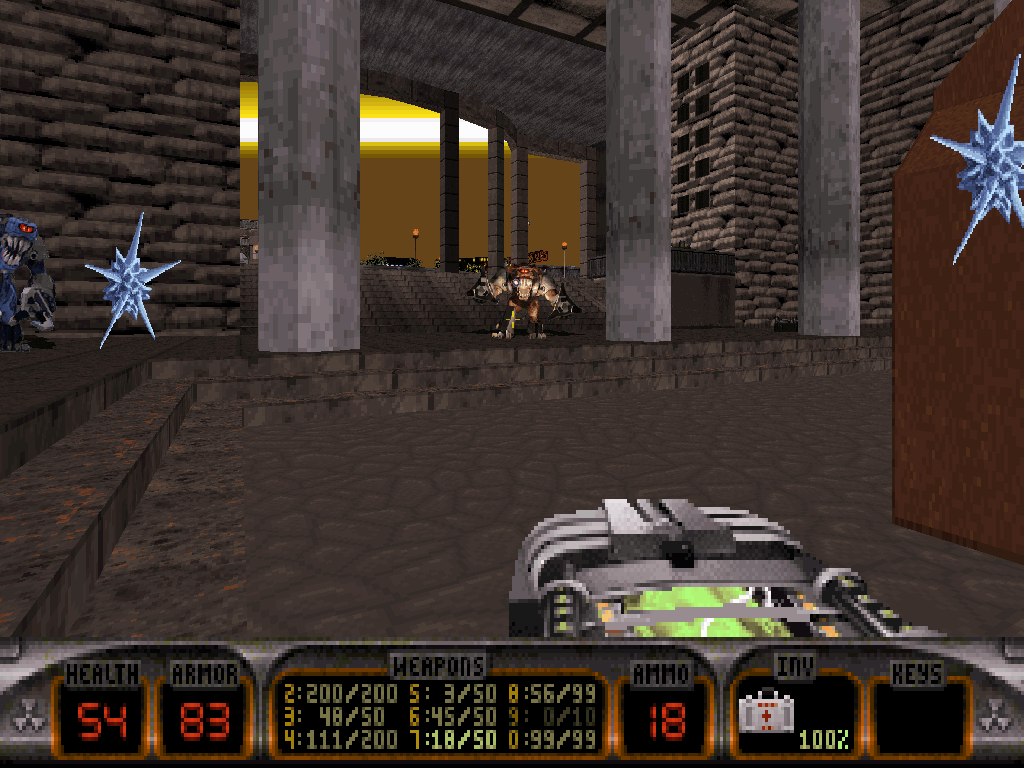
From that point on, he can enter the western wing of the Palais de Tokyo museum, dedicated to contemporary art exhibitions, two ways; either through the regular entrance or through one of the tall side windows, provided that one of those ever blows up (which is likely when your name is Duke Nukem).
This offers Duke alternative strategies for approaching the Sunburnt Battlelord inside if ever so desired, but either way will culminate with the realization that for now, the bathrooms are locked.
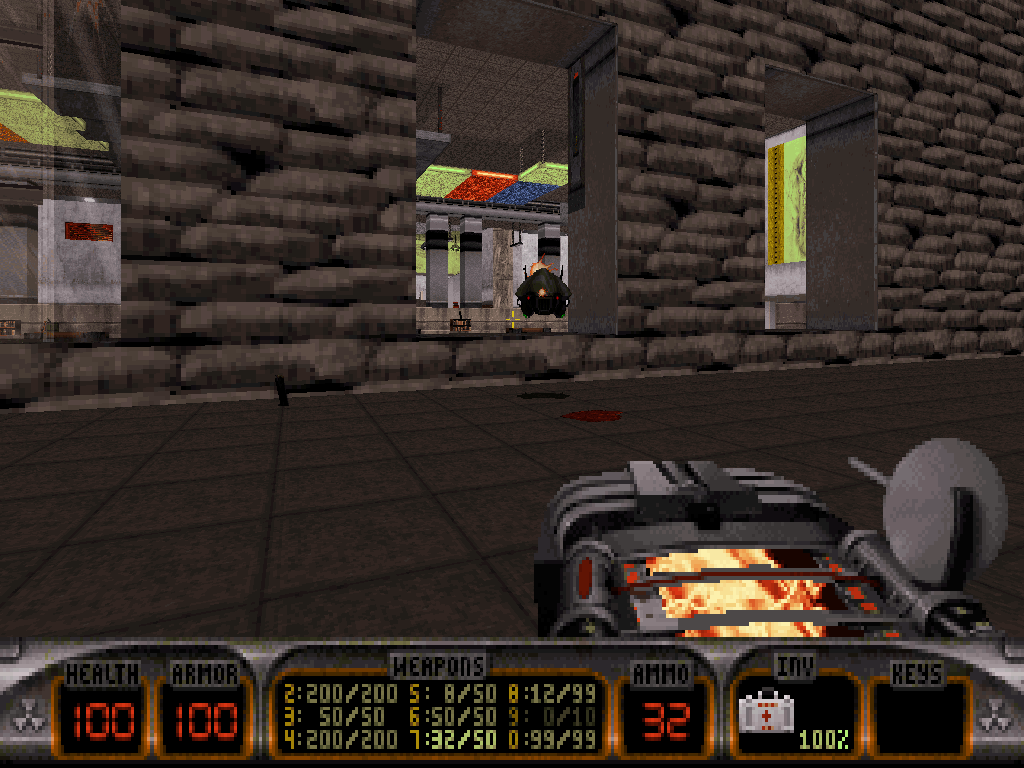
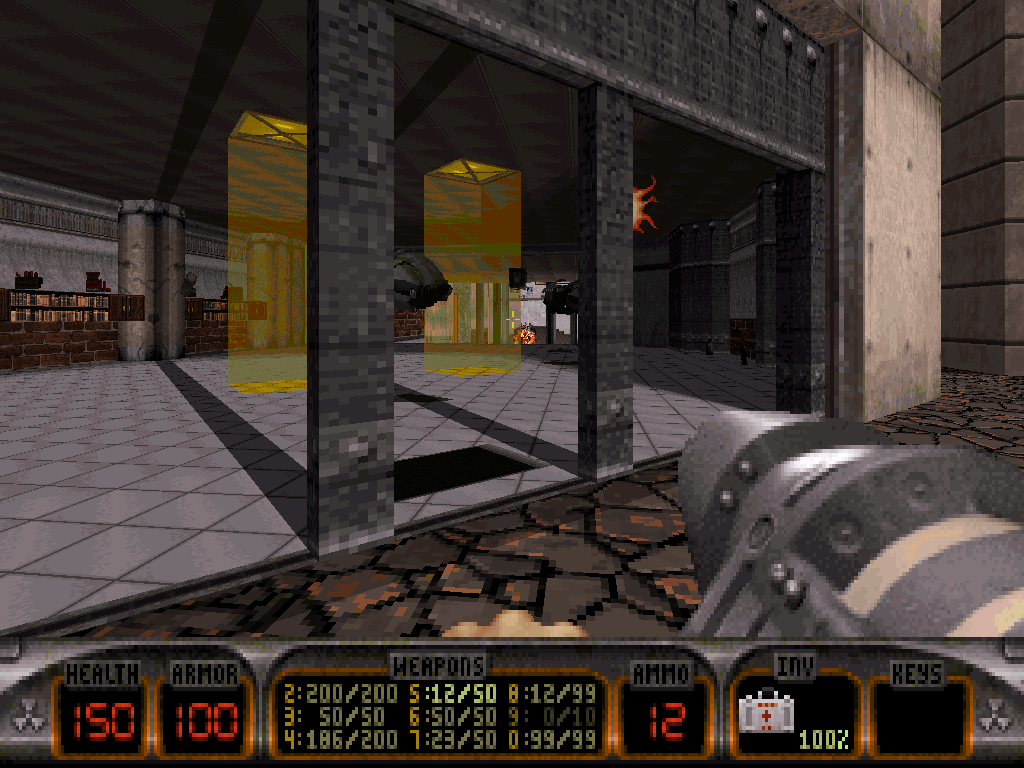
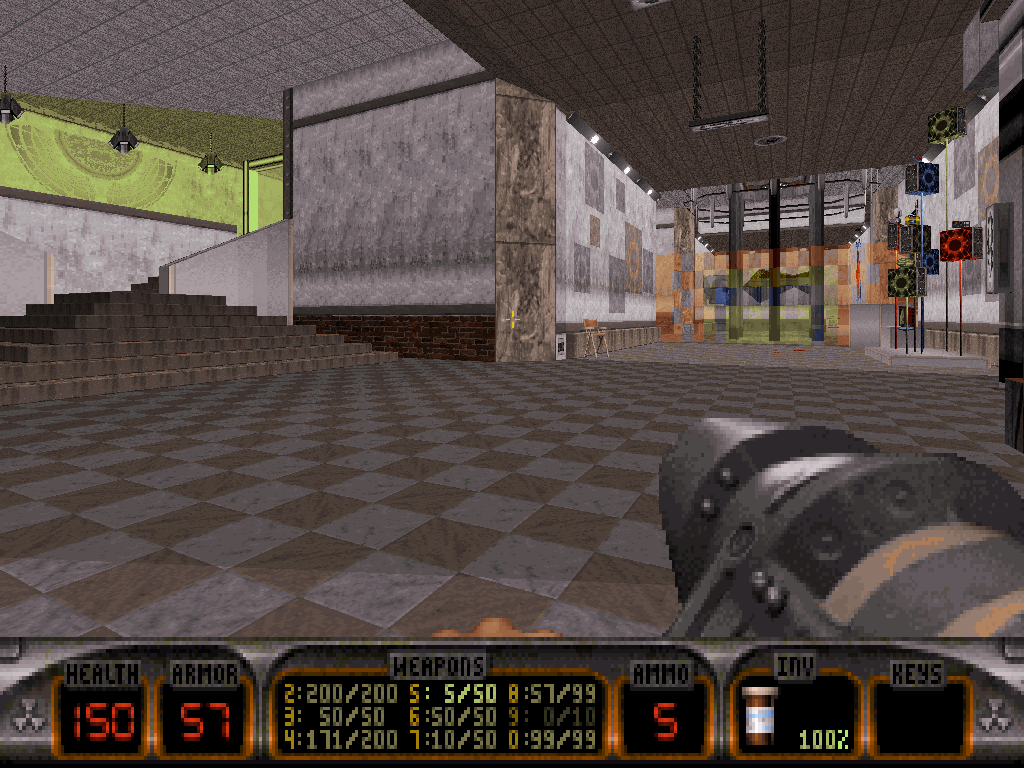
Sick and tired of all this crap, Duke really ought to visit them; peeping into the security camera screens and/or exploring the exhibitions on the upper floor of the museum will unveil the existence of two forcefields blocking the individual exhibition spaces there.
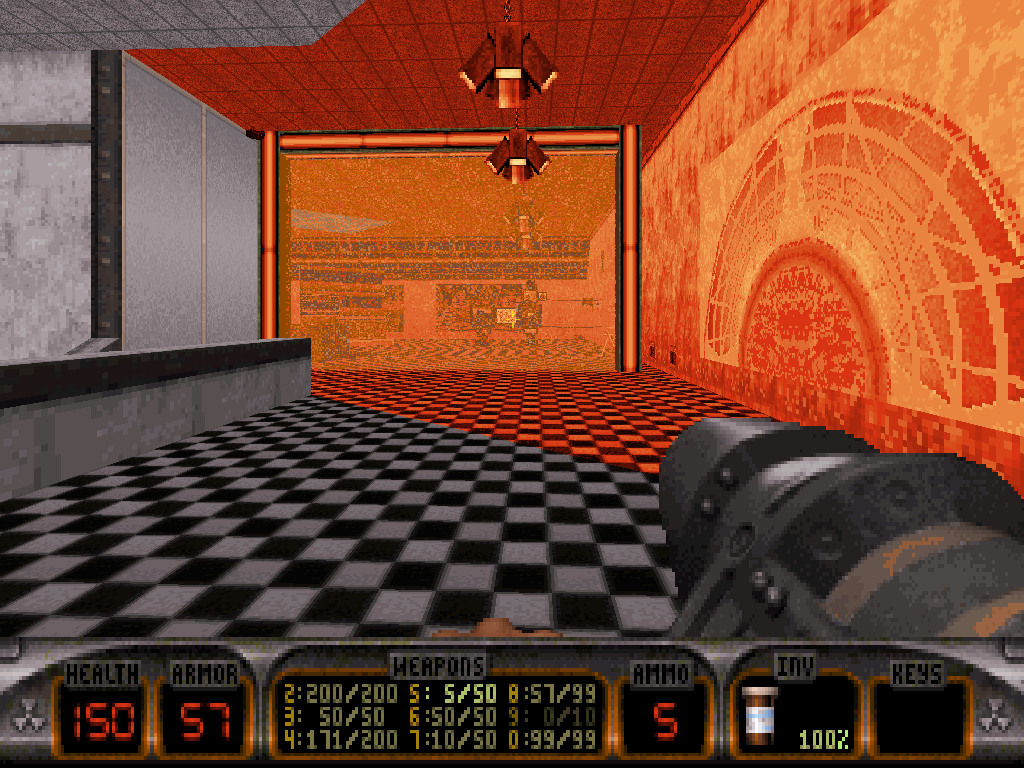
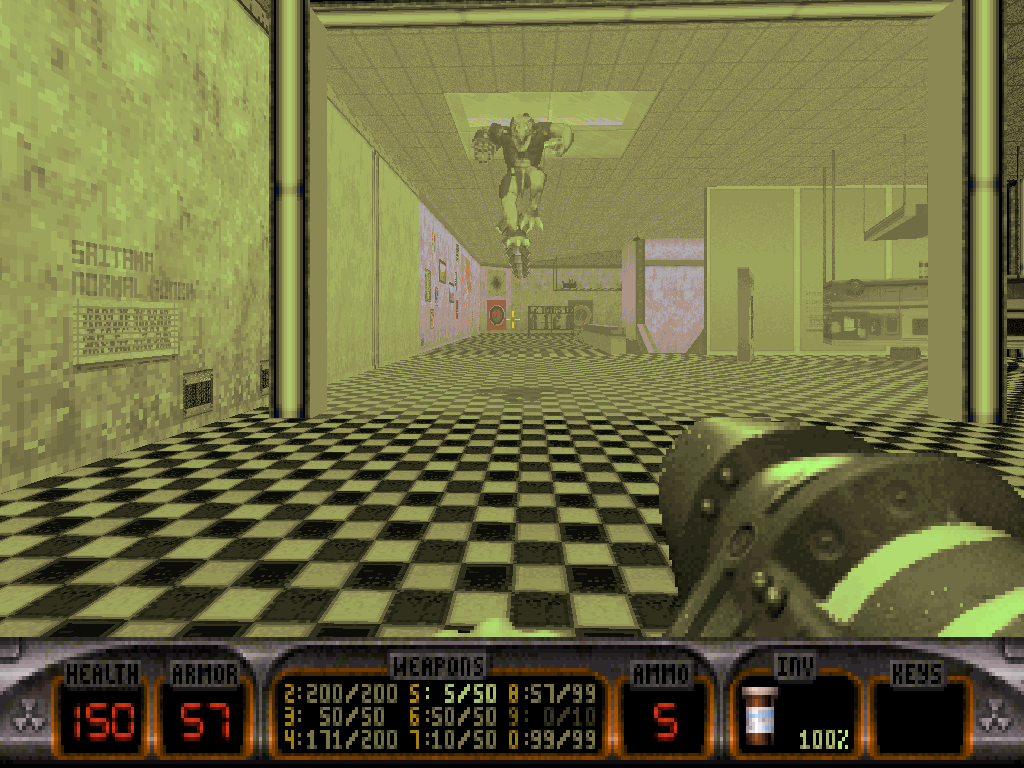
In the northernmost exhibition space there, above Nam June Paik's "Static Earth (Live Broadcast)" is a switch Duke can use to deactivate the red forcefield, then access the opposite segment the bathrooms can finally be unlocked from (which also will turn off the green forcefield).
Our hero should be on his guard however, as doing so will unleash the fury of a group of Fat Commanders, outside, now suddenly taking it out on the museum as though to directly demonstrate their frustration of not being able to defecate but homing rockets; in Duke's words, they really should "eat shit and die", especially in order not to become even more of a nuisance later - when back out on the streets.
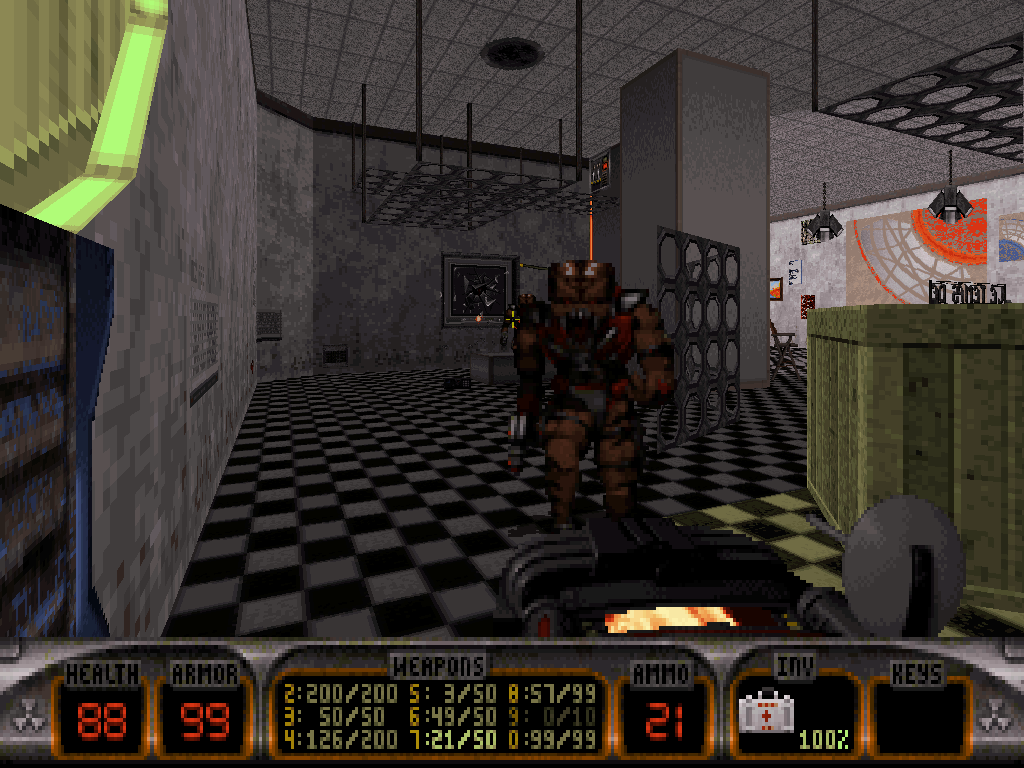
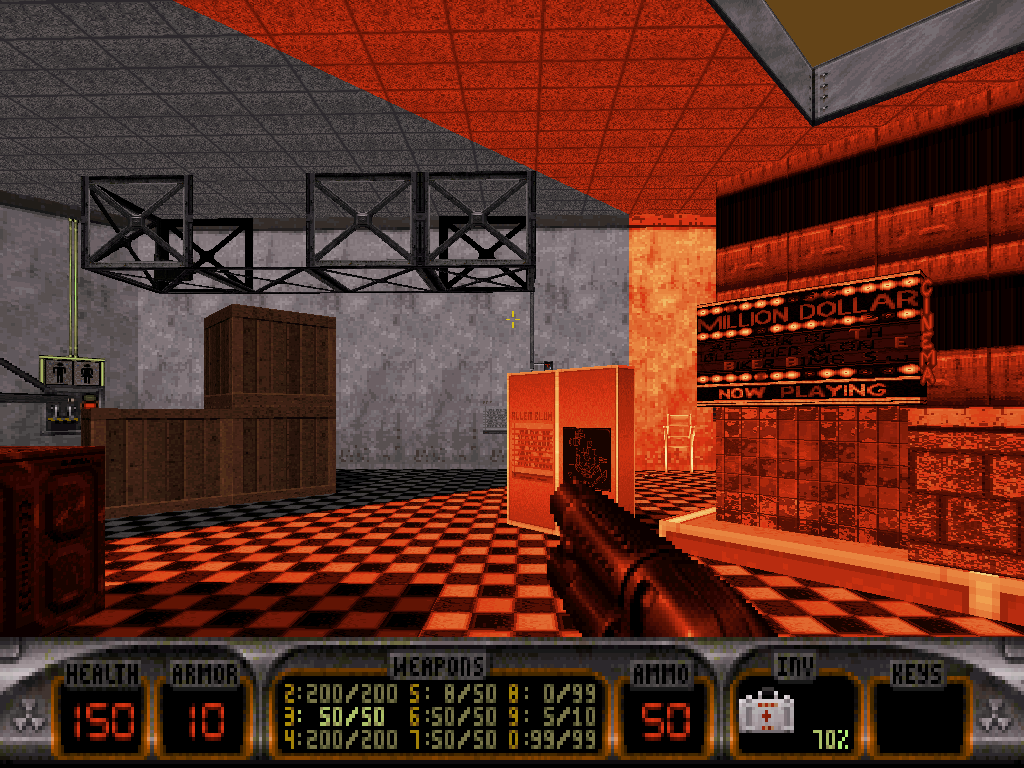

Exploring the bathrooms will uncover secret doors (amidst more cheeky business) into a hidden floor of the building, complete with a front desk for surveillance, a security room and residents.
The next hallway is visible but, again, blocked by a forcefield.
The switch to turn it off, logically, is in the security room, but it's partially blocked from the inside by a barricade of furniture; Duke can retrieve pipebombs from the trashcan, however, and throw one into the surveillance room to blow everything up and make way; or he may choose any manner to get an explosion going in there really, including shooting the fire extinguisher on the next wall with his pistol if his shot can reach it.
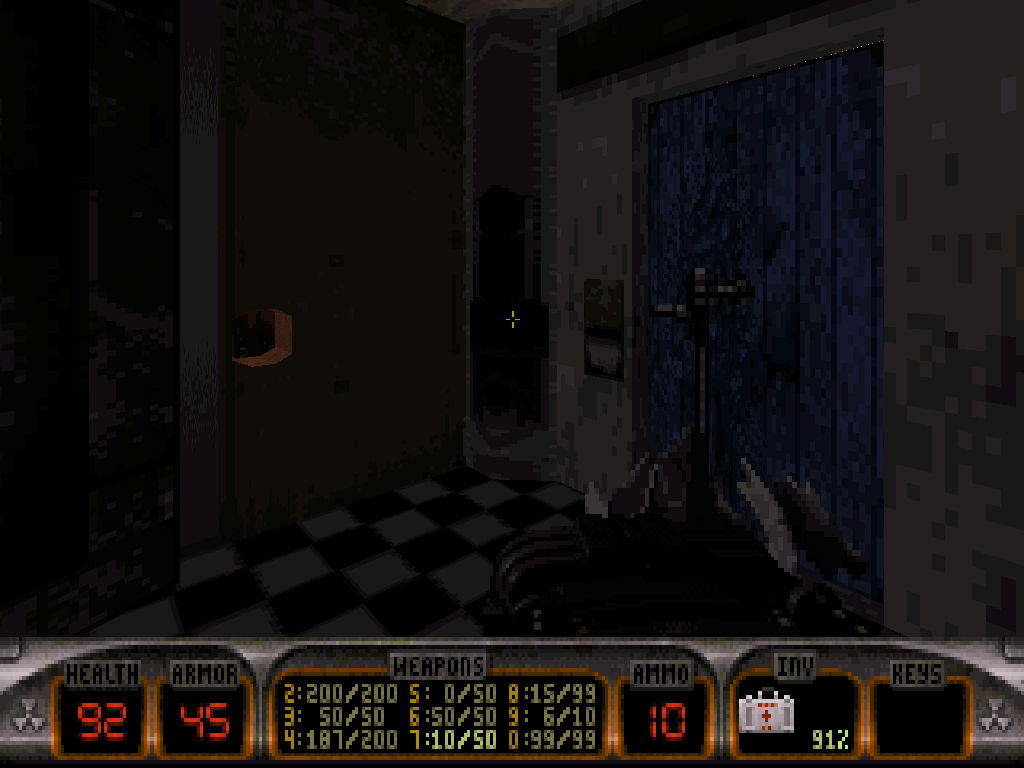
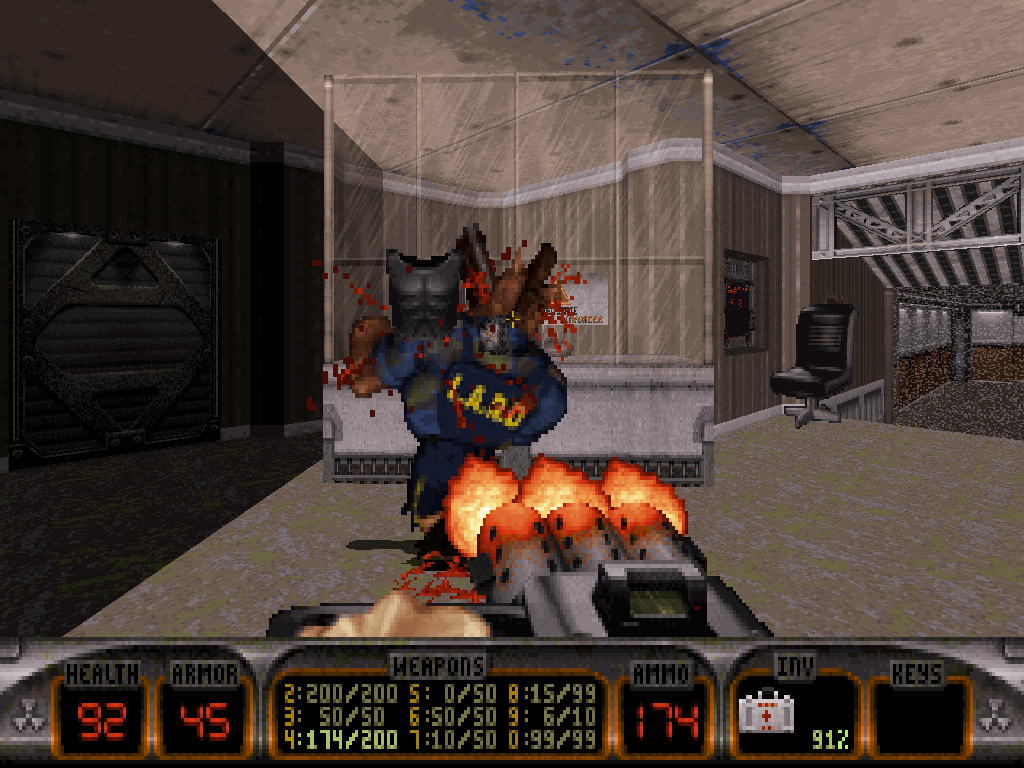
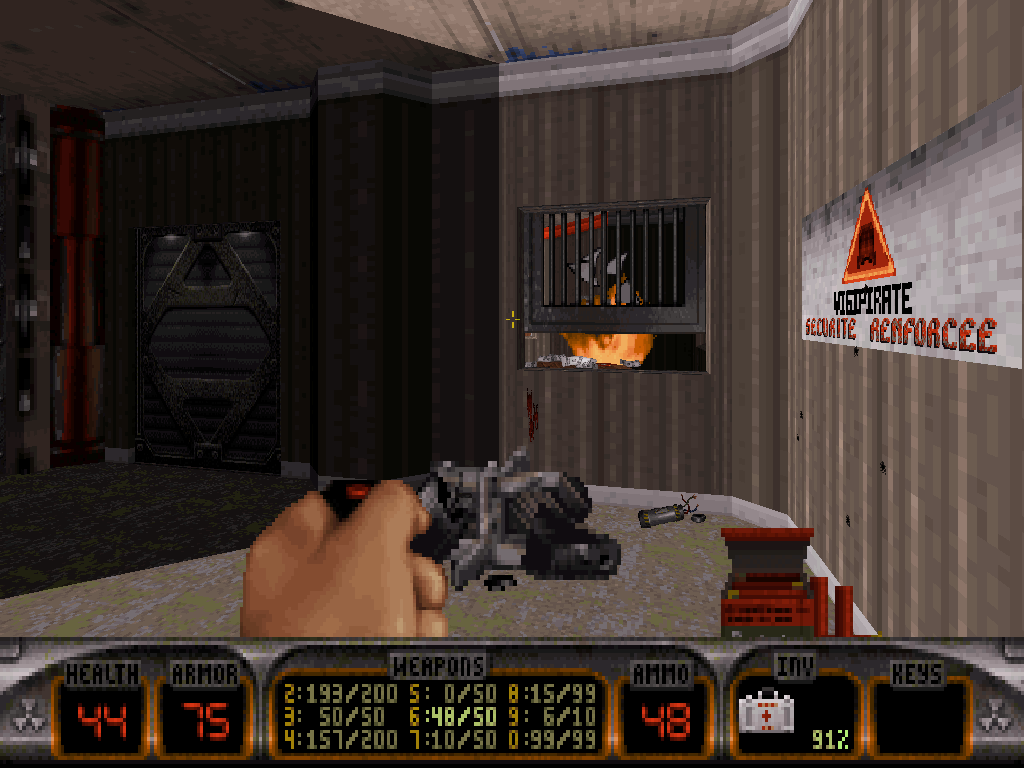
Beyond the forcefield is revealed to be no less than a French porn studio.
The movie sets are on Duke's current floor, whereas the direction as well as the printing and shipping operations run the next, upper floor. By using the elevator the Assault Assaulter took to try and ambush him, Duke shall find his way there all the while naturally scoring nonchalance points with his trademark mannerisms.
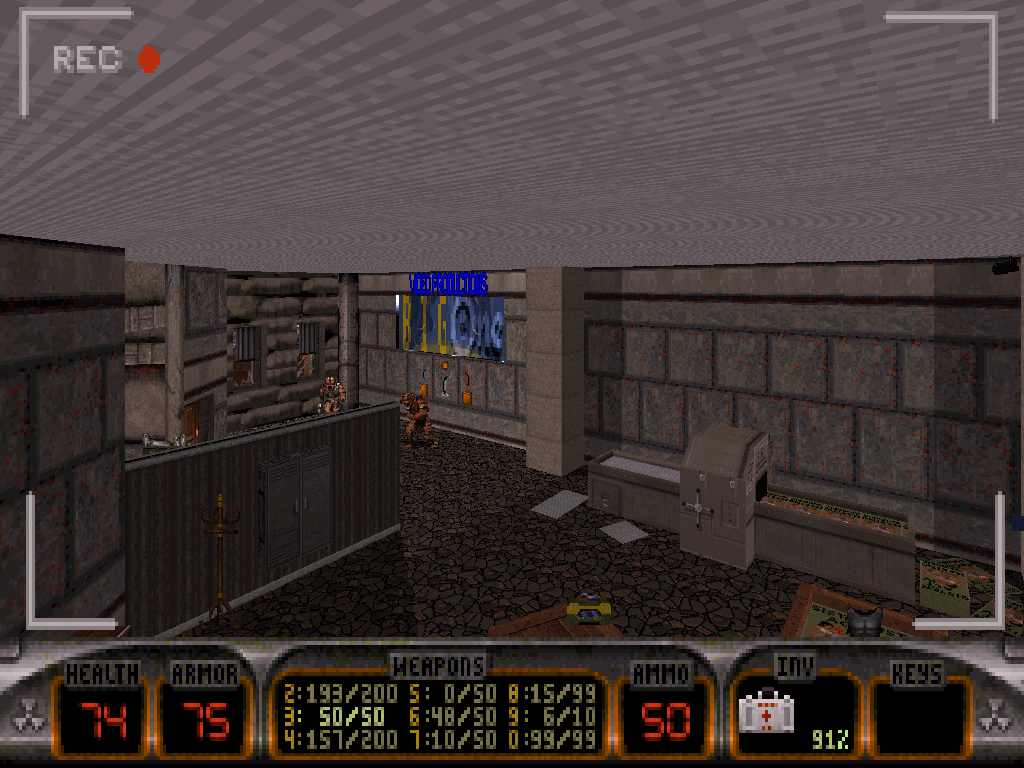
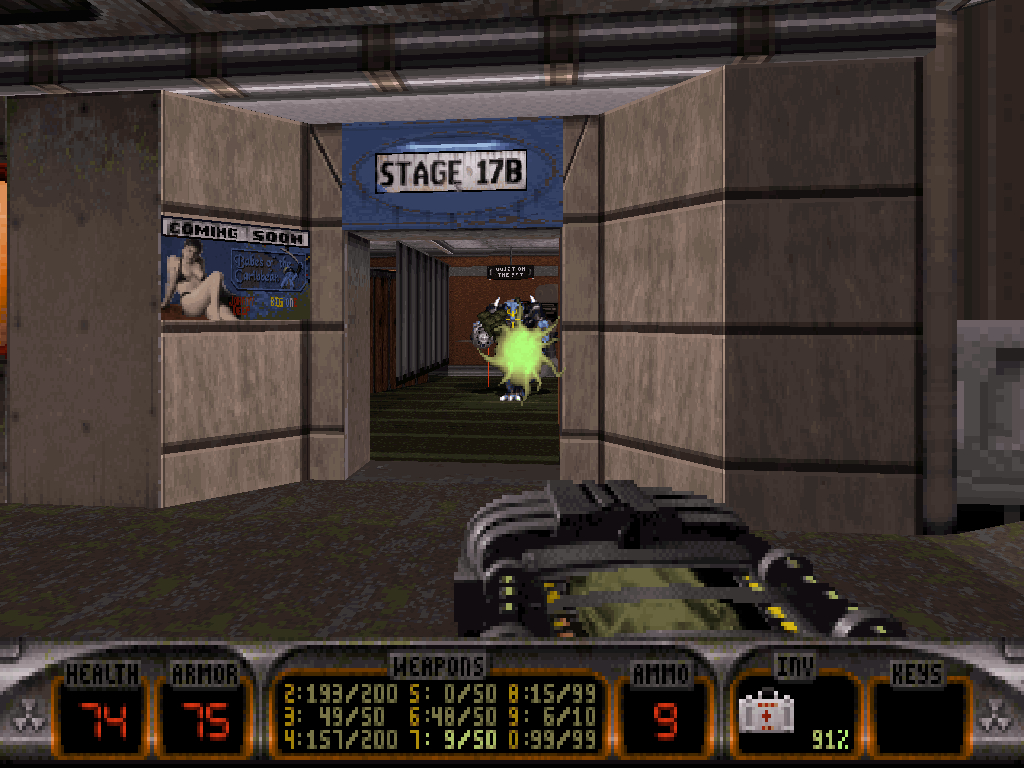
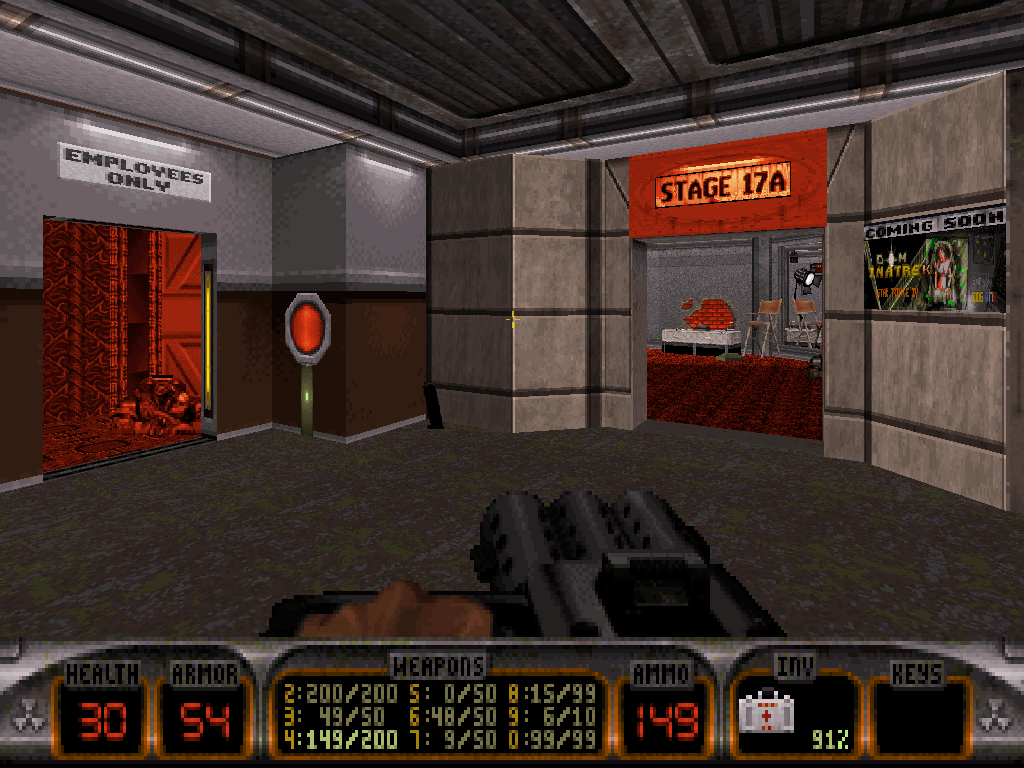
Once physically there, two choices will present themselves to Duke under the form of a basic branching pathways, left-or-right type of dilemma.
Left will take him to the blue key pad and so, if he's missing the blue key, Duke would be best advised to explore the other side first, where leaving the building out of the large window will land him on a high ledge which runs alongside the building. (Some impromptu Fat Commander constipation will take care of smashing the window glass from the streets the moment Duke comes too close either way.)
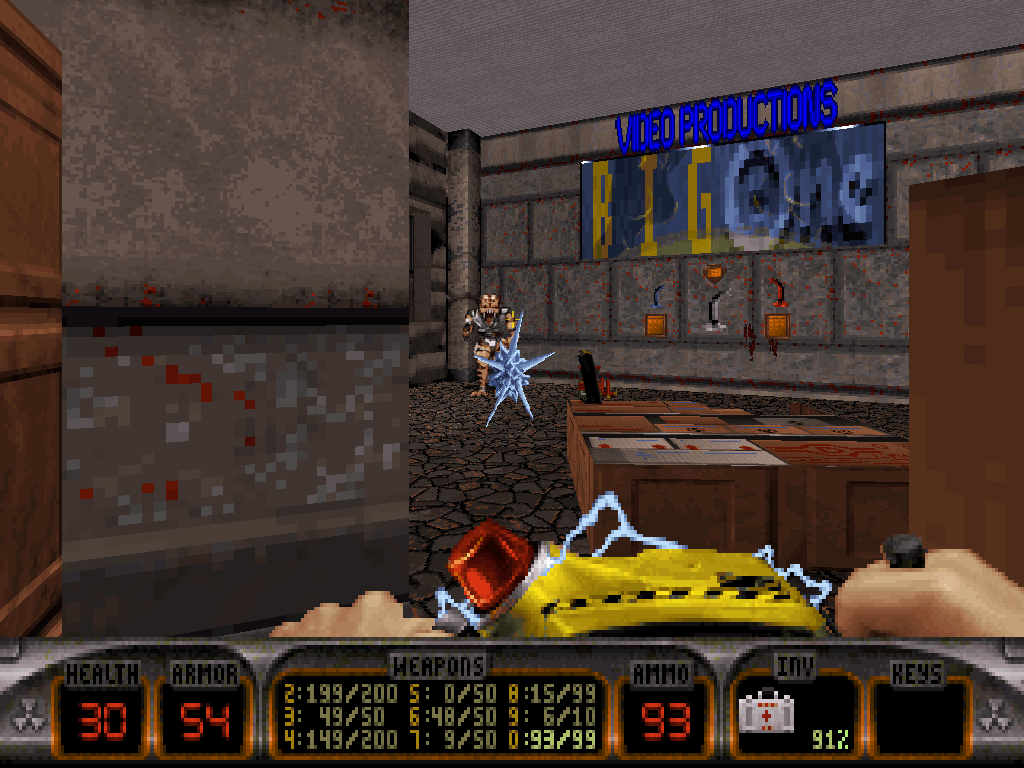
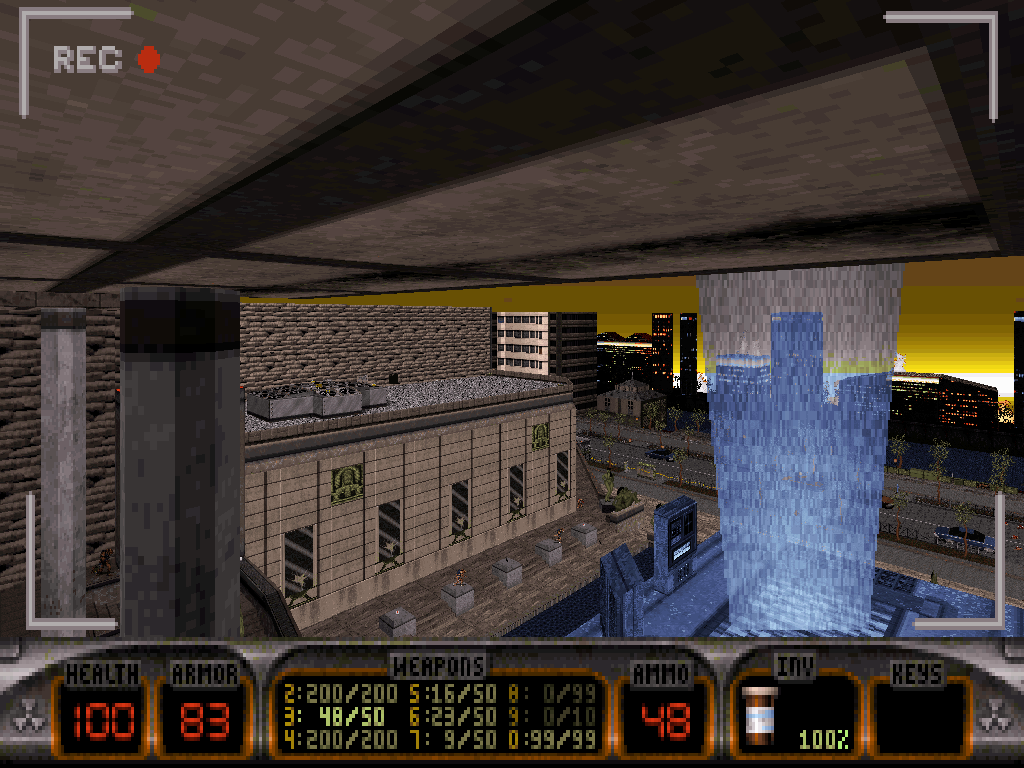
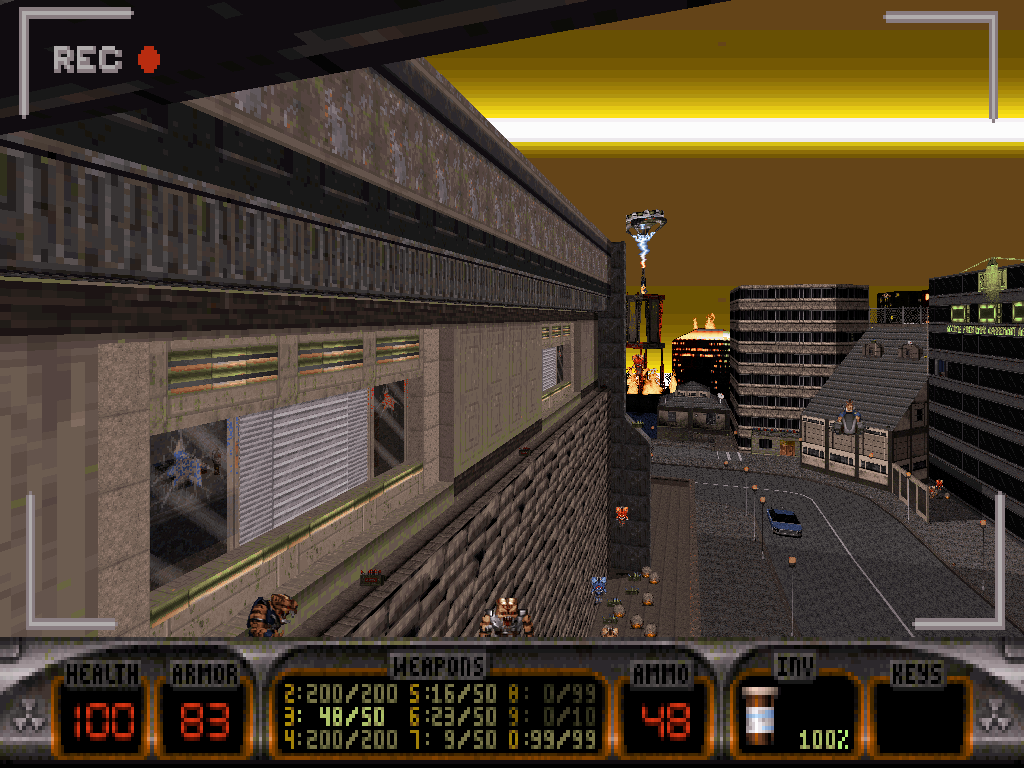
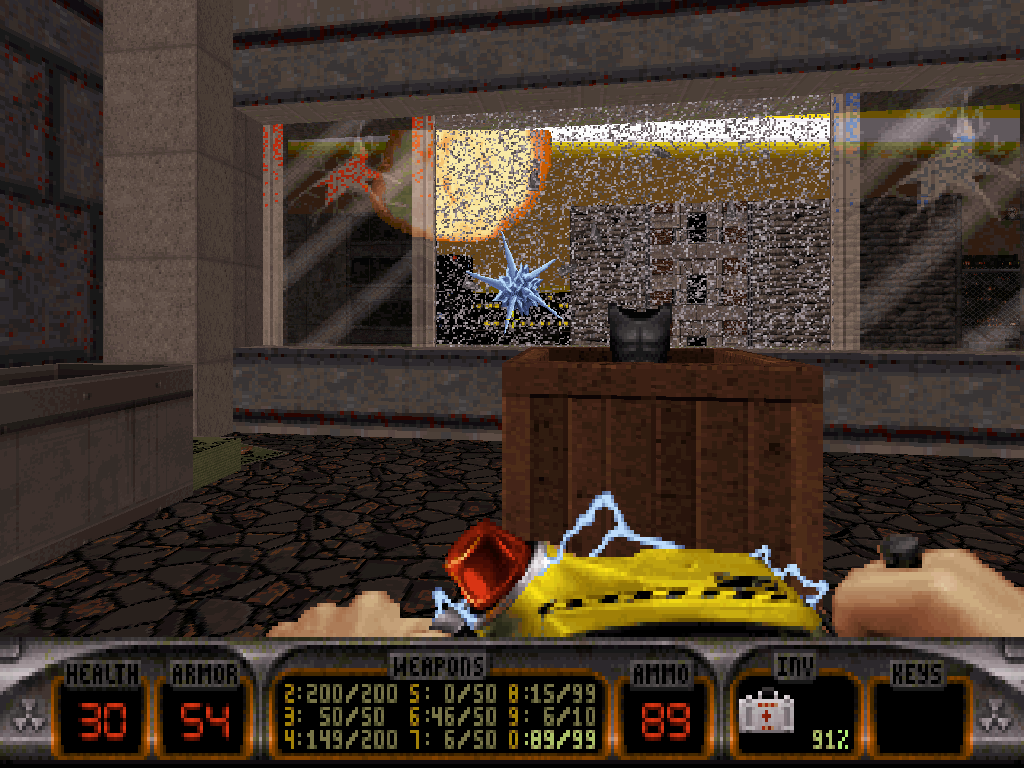
From that ledge, Duke can access a similar window, just next to the one he came out of (as well as a few elevated goodies if he feels like walking that line).
Opening the shutters and shattering the glass will lead him into (the remains of) a luxury apartment that is partially collapsed, and also a reference to 1995 French comedy film "Les Trois Frères" ("The Three Brothers"), representing character Pascal Latour's apartment - complete with the immaculate "Monochrome de Whiteman" and the records he inherited from his deceased mother.
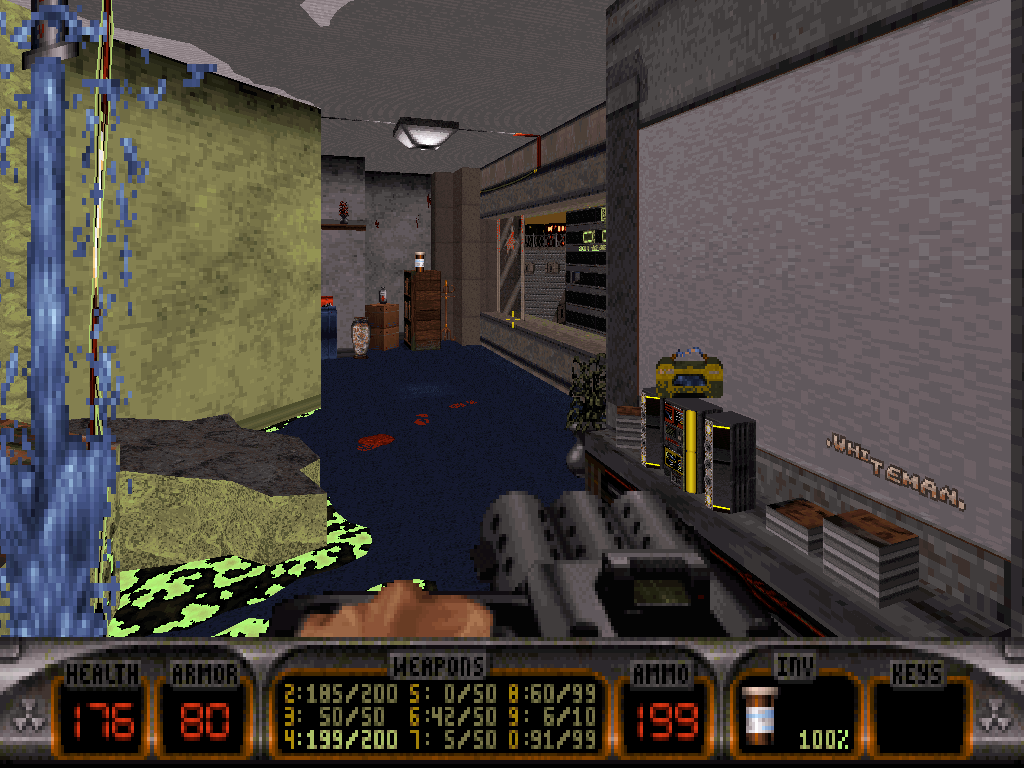
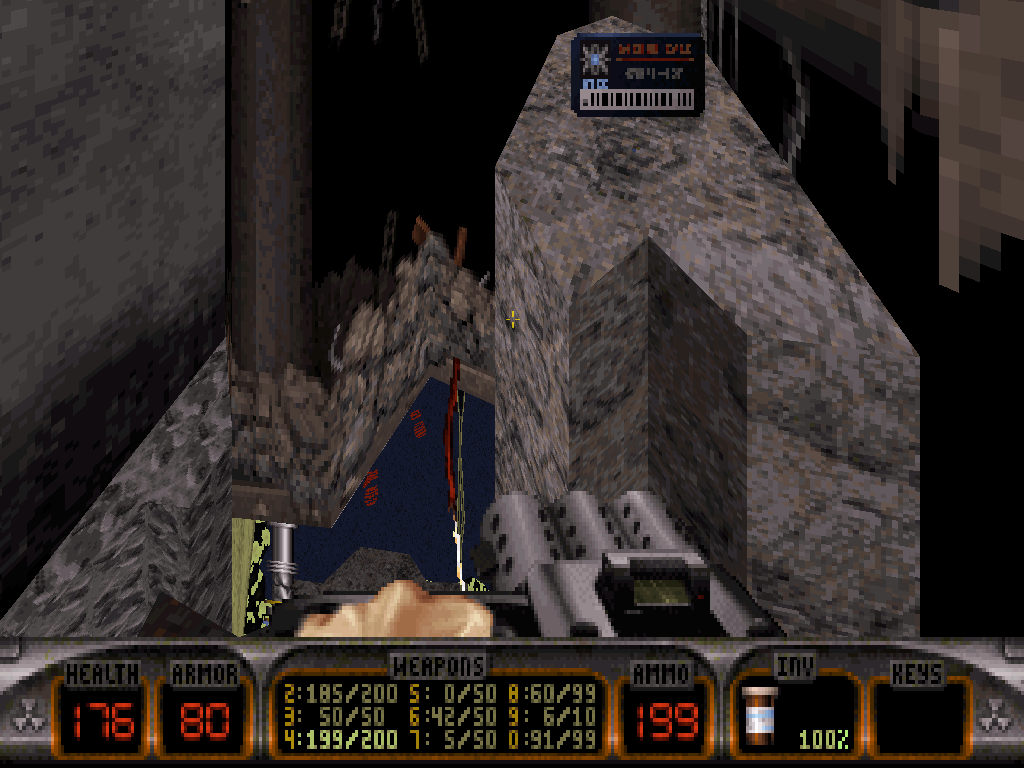
Climbing the pile of collapsed rubble (all the while minding the electrified water on the floor) will take Duke to the blue key, while someone in the room down below discreetly defaced the "Monochrome" and put a record on.
Duke can now backtrack to the top floor of the porn studio, either by going back around the window or by exploding a wall into a ventilation shaft which will lead him to the movie sets, where he can then use the elevator again.
Finally back in that room, he can now leap out of the leftmost windows and reach the lower rooftop of the museum building's left wing, where some scum is bound to manifest itself.
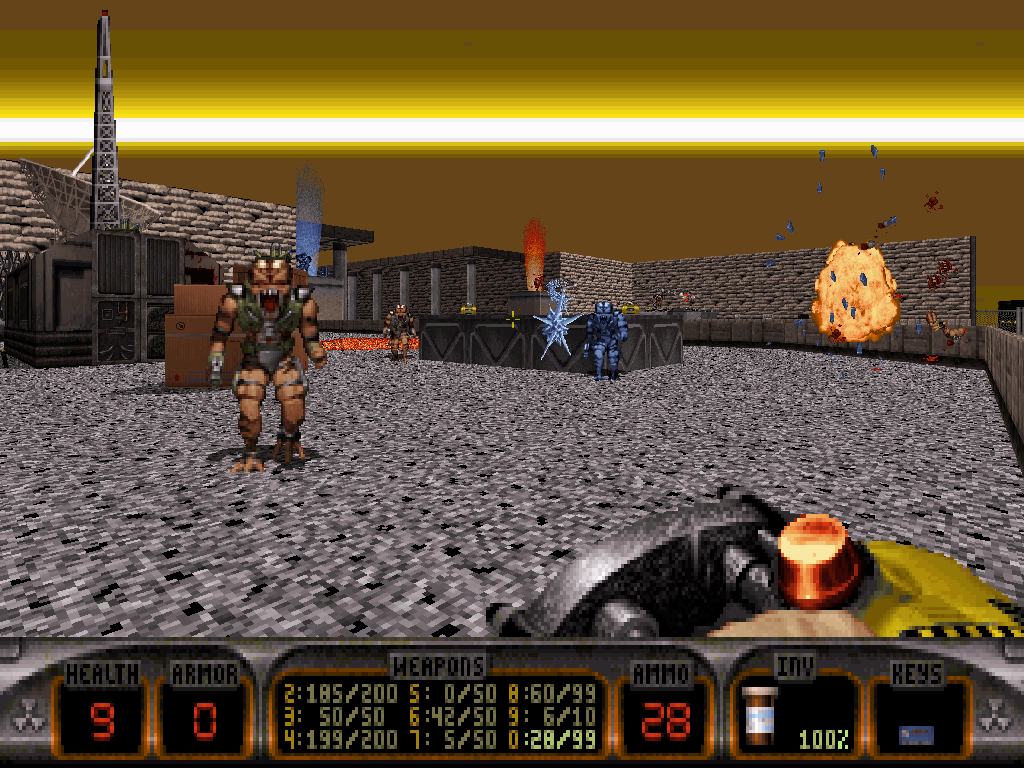
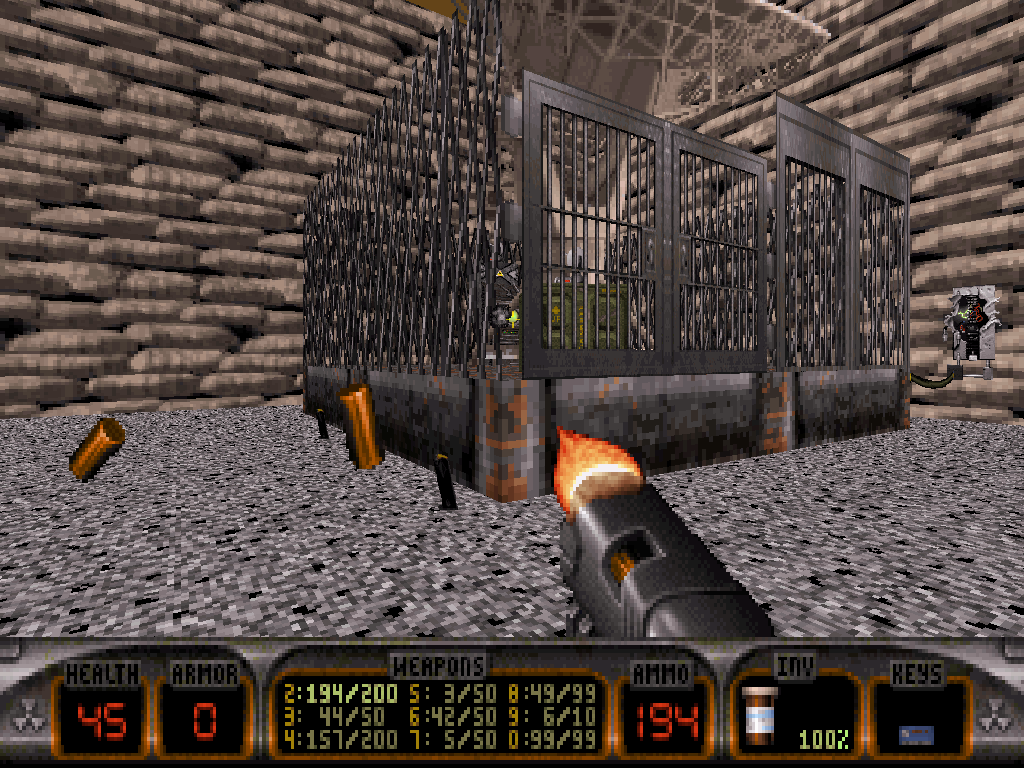
Mindful exploration of the rooftop will uncover the presence of a shootable switch, behind fences, right behind and through the massive antenna.
Duke can either find a way over the fence or use his pistol through a corner of the gate; either way, activating the generator will cause the adjacent part of the museum building to blow up, revealing a passageway to the blue key pad, towering over the central plaza.
From here already, Duke can realize his destination is the now visible, opposite rooftop.
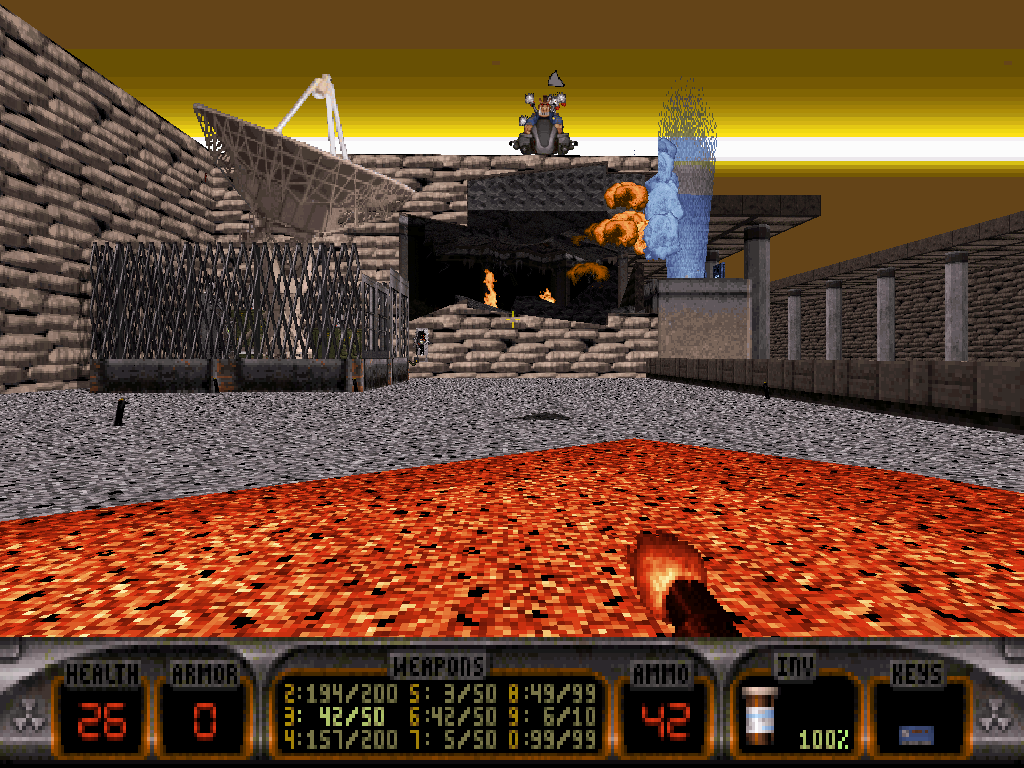

Using the blue key for the expo du jour will start slowly raising a neon signage-bearing central platform, right under Duke's nose.
After he's been reminded about his findings at the pharmacy by peeping at the security camera screen or just spontaneously figured out that a Steroids jump should be in order, with precise timing and accuracy, Duke can and should nail one just there and then as the platform keeps rising, traverse along and across the plaza and, finally, leap again at the end onto the opposite pillar then rooftop.
The expo du jour will only activate once and so were Duke to miss his performance, he might end up having to find another way to complete the level altogether as a consequence of that artistic choice (which of course is possible).
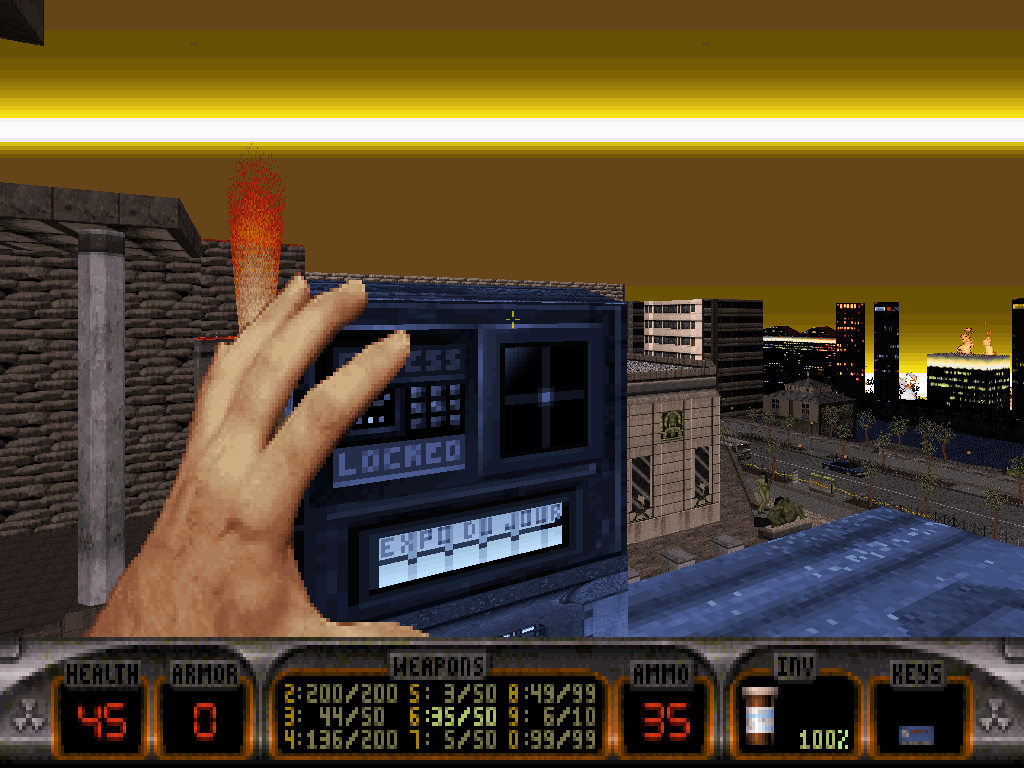
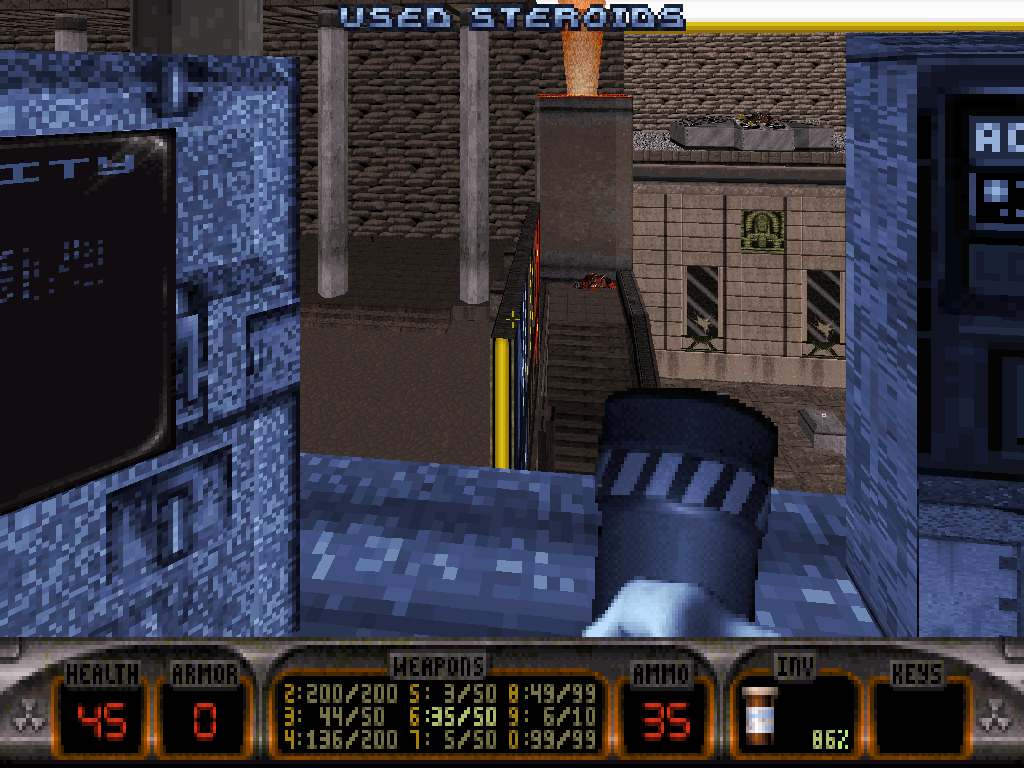
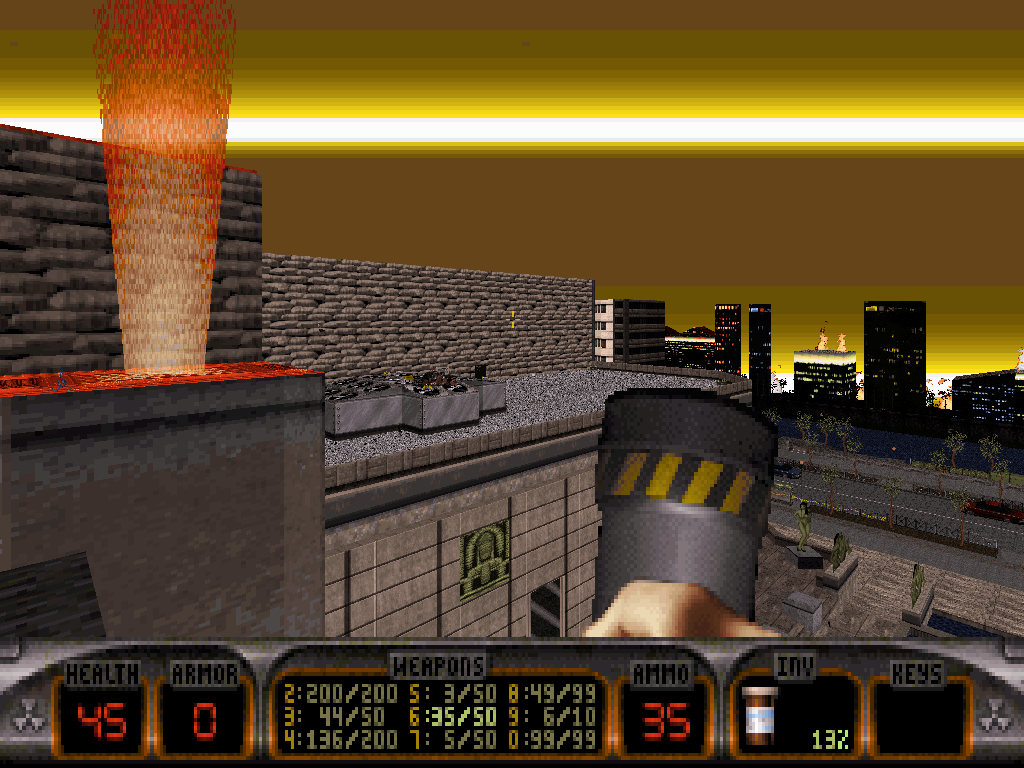
There on the opposite rooftop, a massive enemy attack awaits; but so does the yellow key for Duke to fetch. After he's grabbed it, he can finally unlock the door from the outside and unblock the way into, and out of the top floor of the pharmacy.
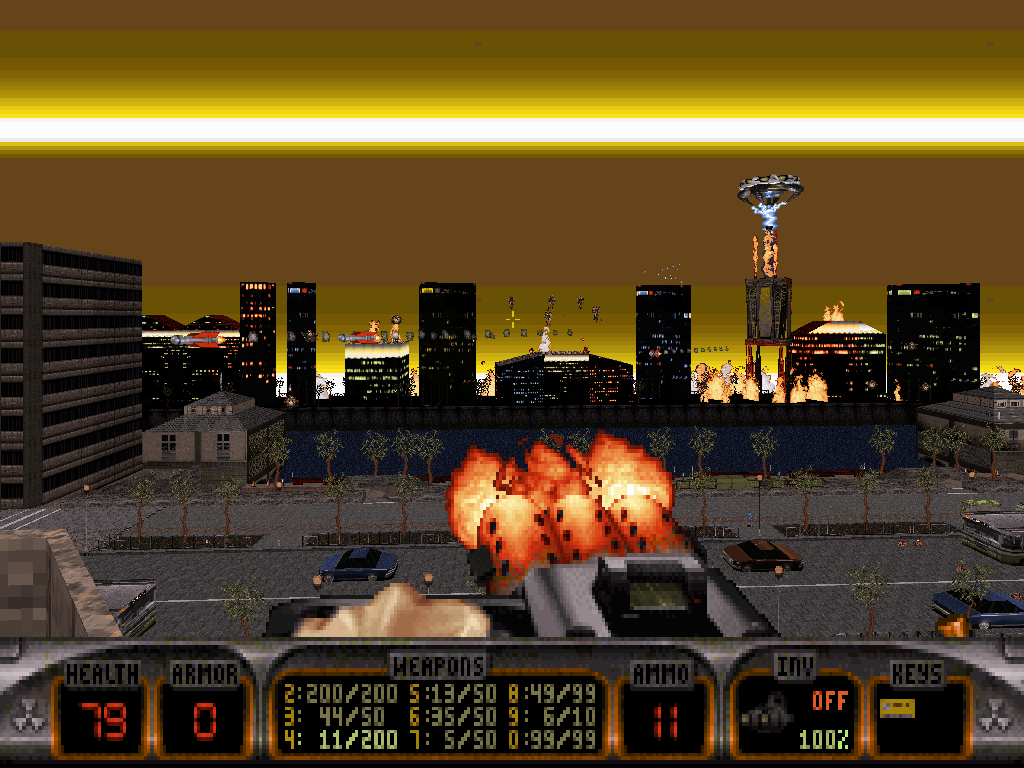
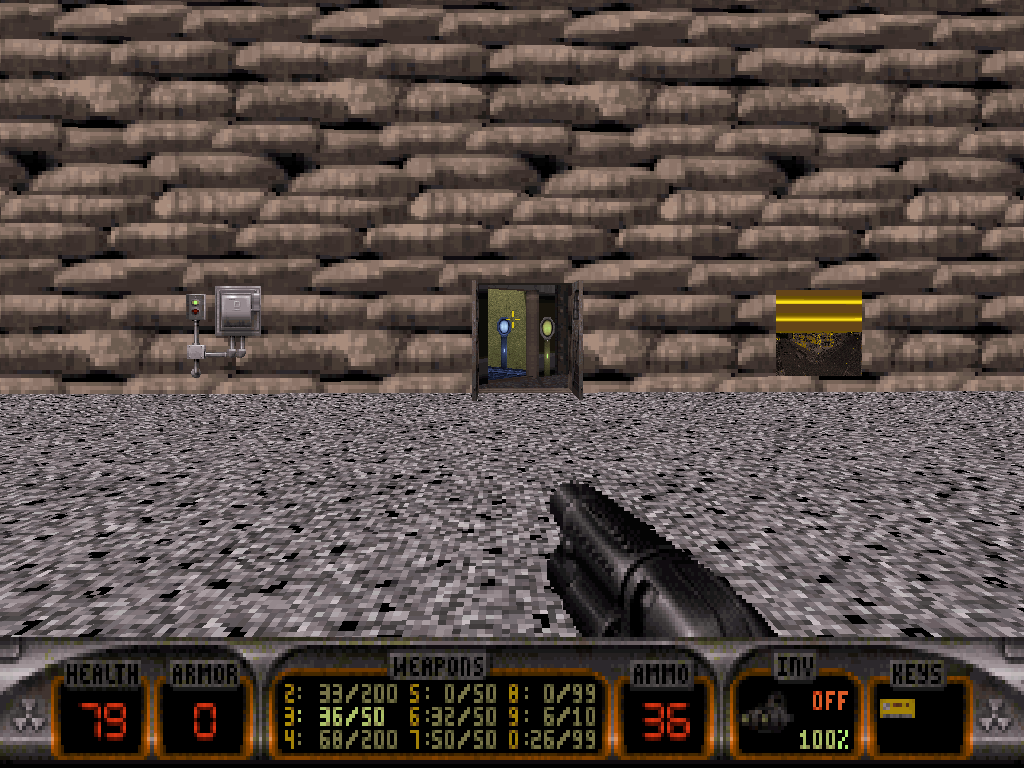
Whichever way Duke chooses to get there, eventually, the yellow key gate is waiting for his arrival around the southwestern street corner, close to the boulangerie and the office building, right across the road from the porn studio top floor and Pascal Latour's apartment.
Lowering the gate will allow Duke access to the whole underground layer of the map which represents an off-limits segment of Paris' real-life catacombs.
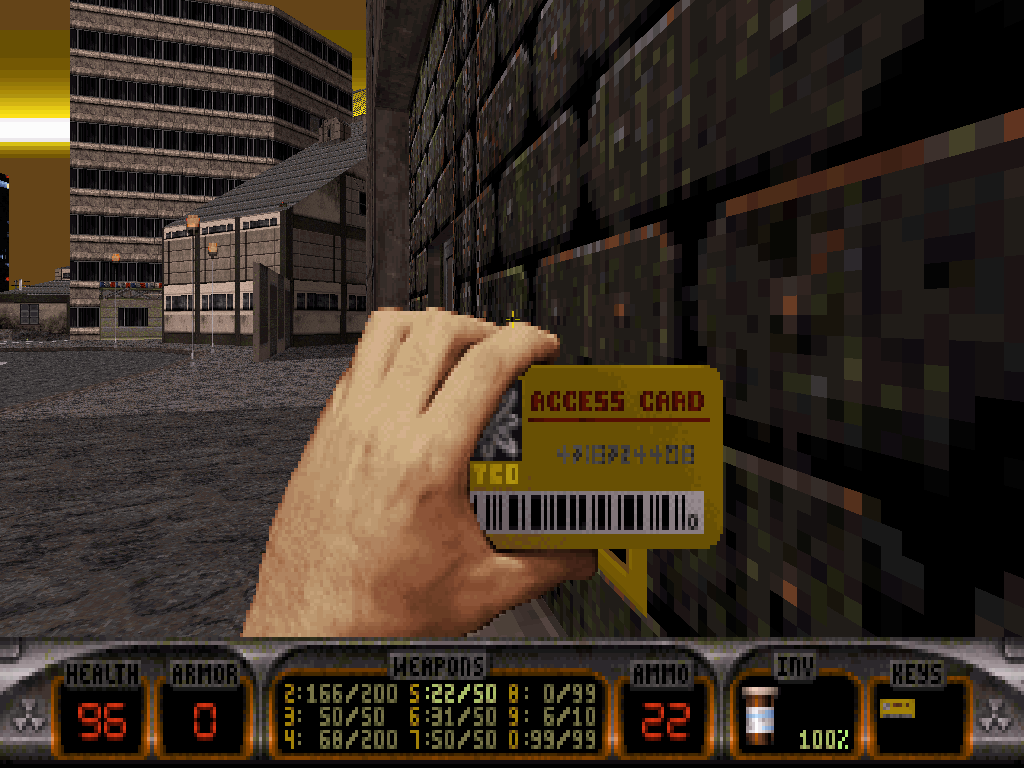
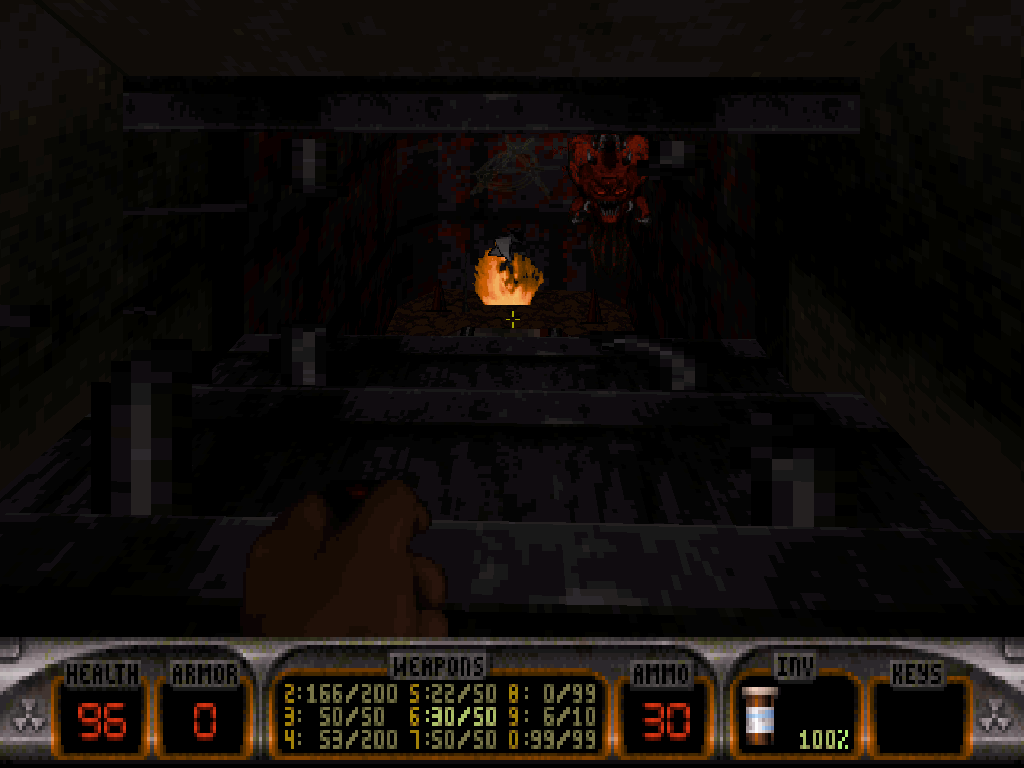
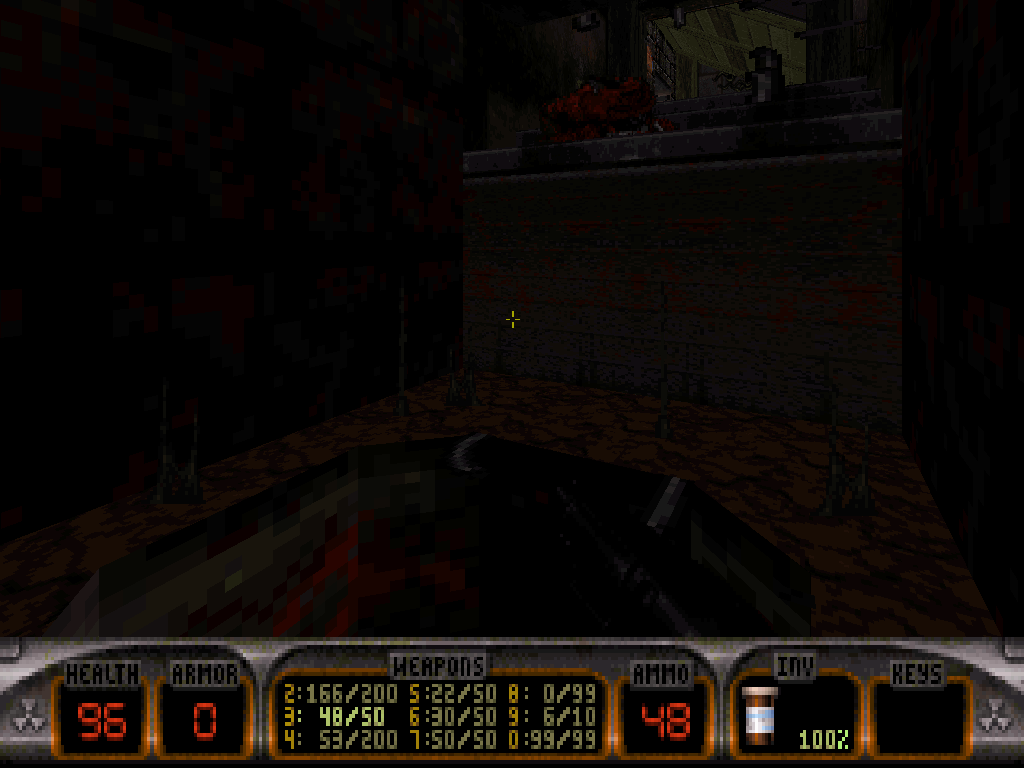
Jumping down the manhole will land Duke near water at the end of a very dark, claustrophobic cavern type of passageway.
Following the path up the stream shall lead him to a first room (a loose recreation of La Plage), which is the first of more to come and also happens to be packed with Sentries.
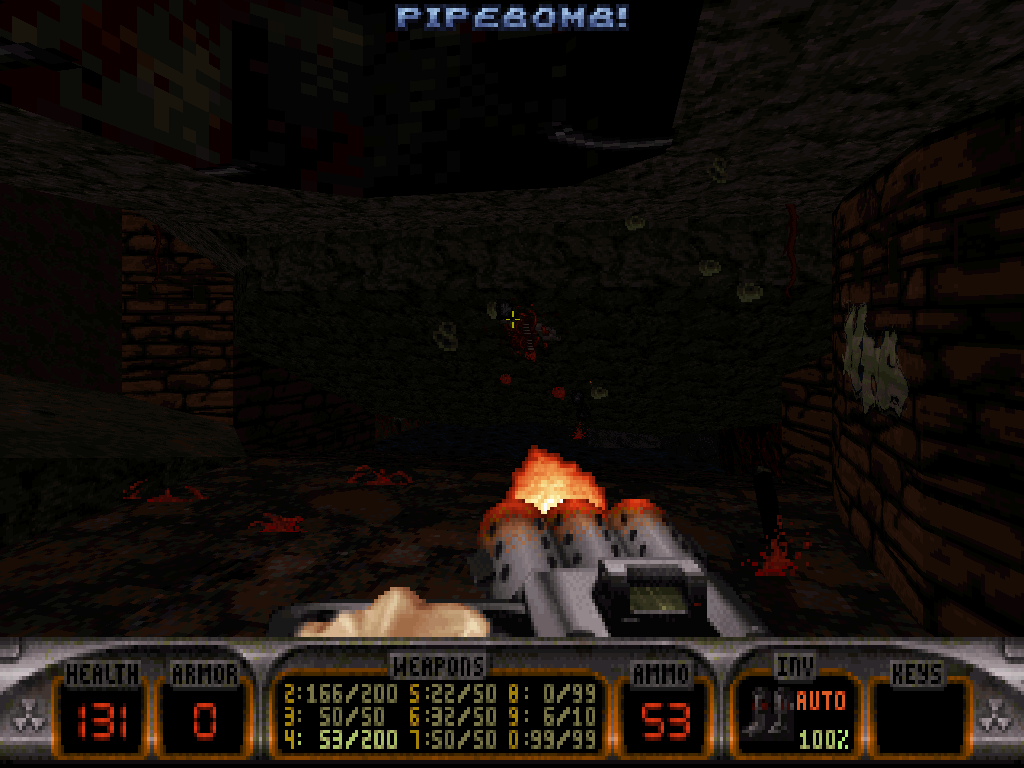
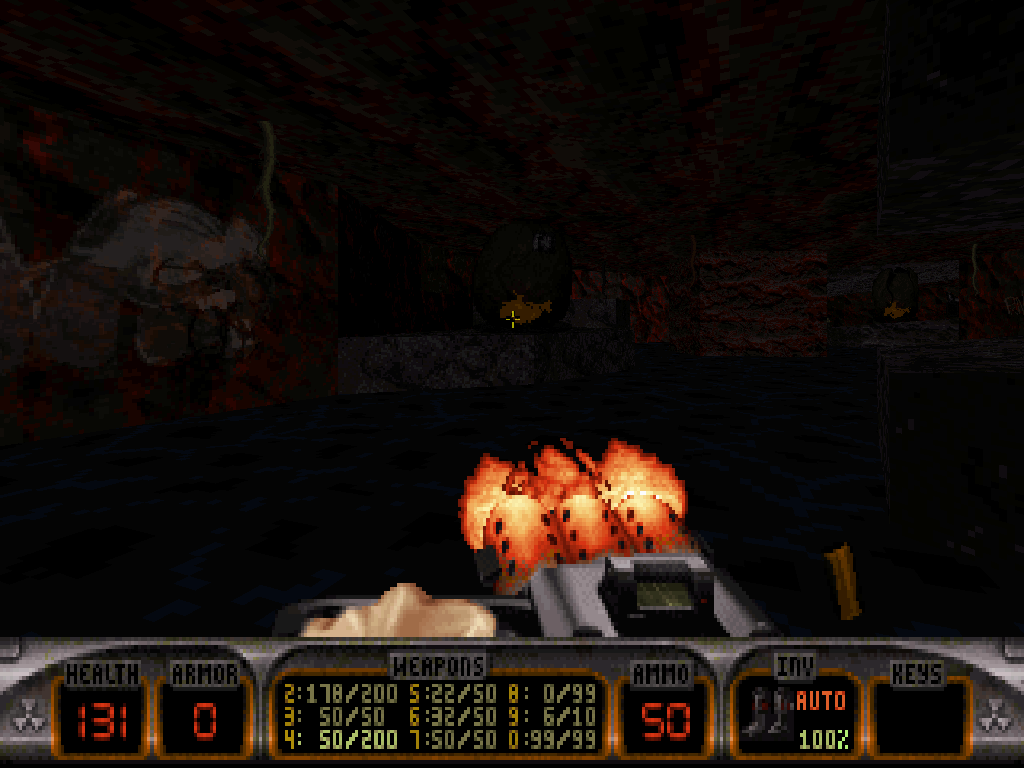
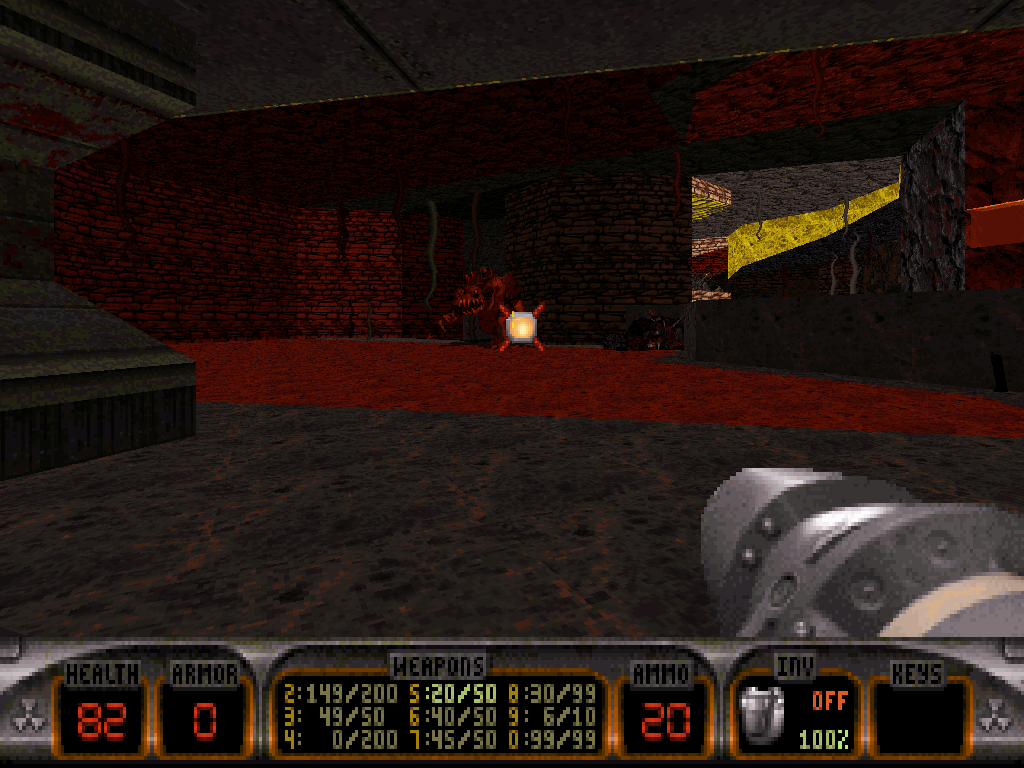
Upon effortlessly vanquishing his foes, Duke can progress in and around the back of where the Overlord Sentry came from, to find another narrow, candle-lit passageway he can just barely fit in.
At the end of that cave is a pit Duke can and shall fall through, floor by floor, by traversing all the different holes; then, once at the bottom, smashing the Protozoid Slimer eggs will allow him to crawl into one more tight tunnel that is flooded with water again.
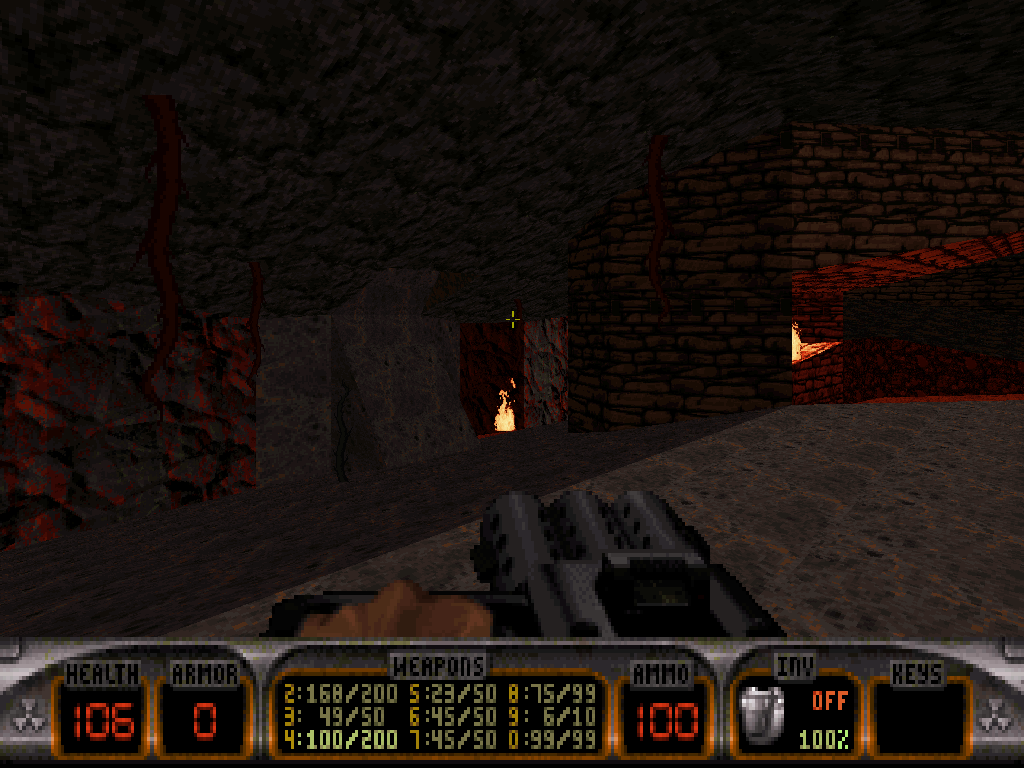
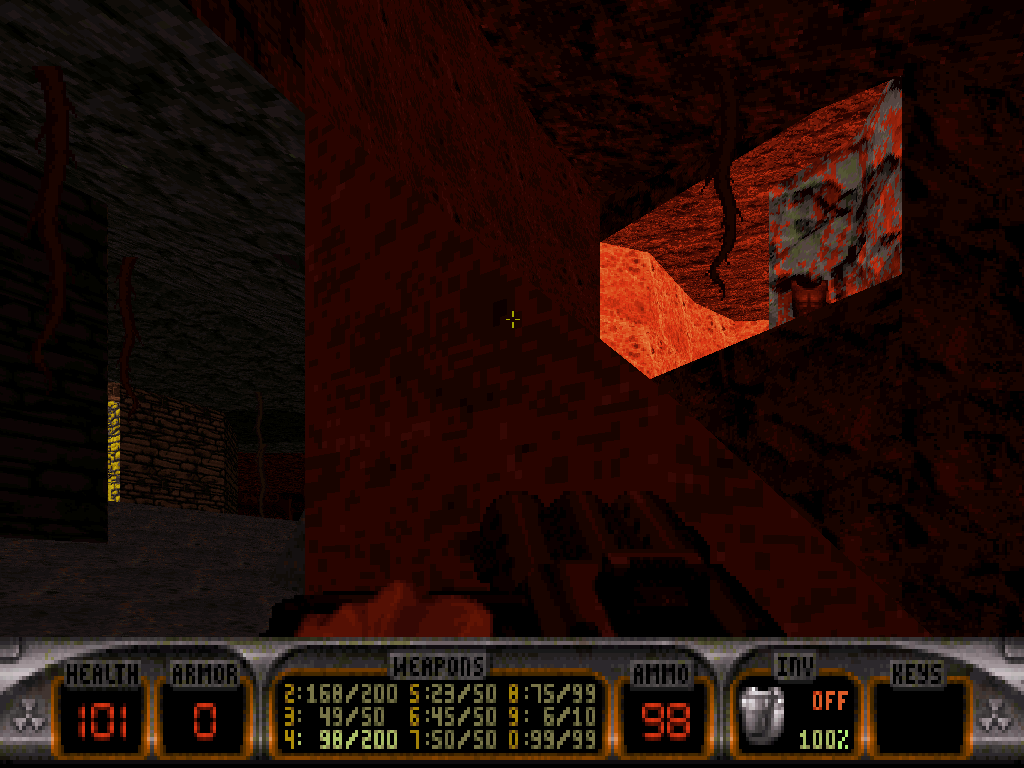
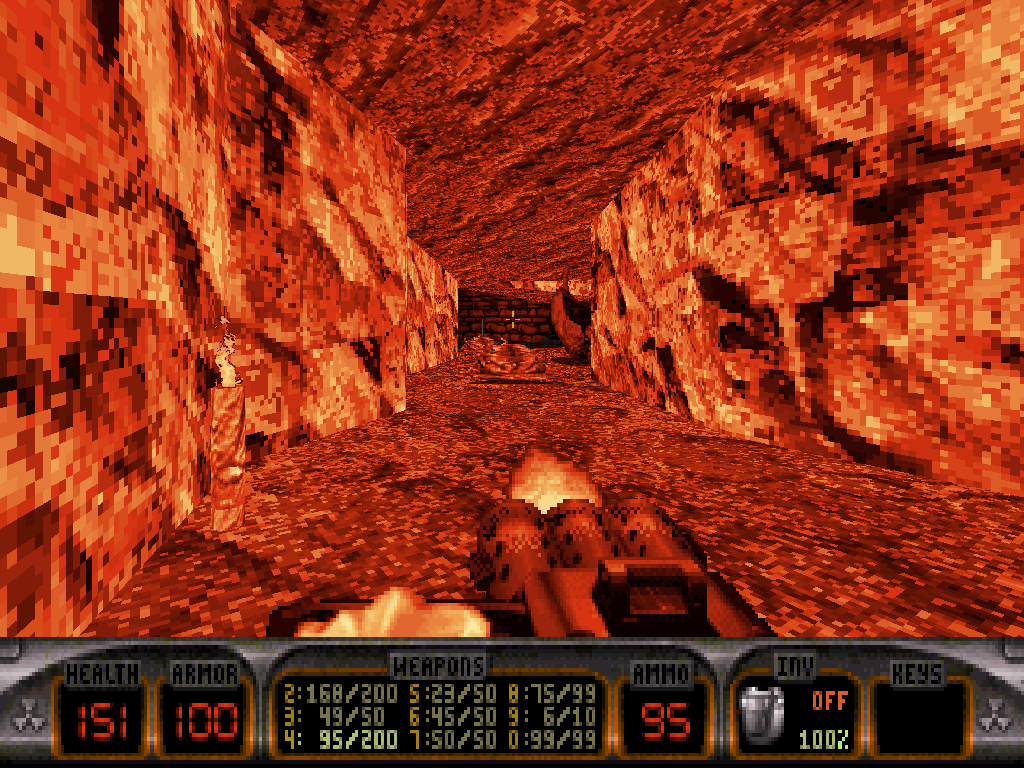
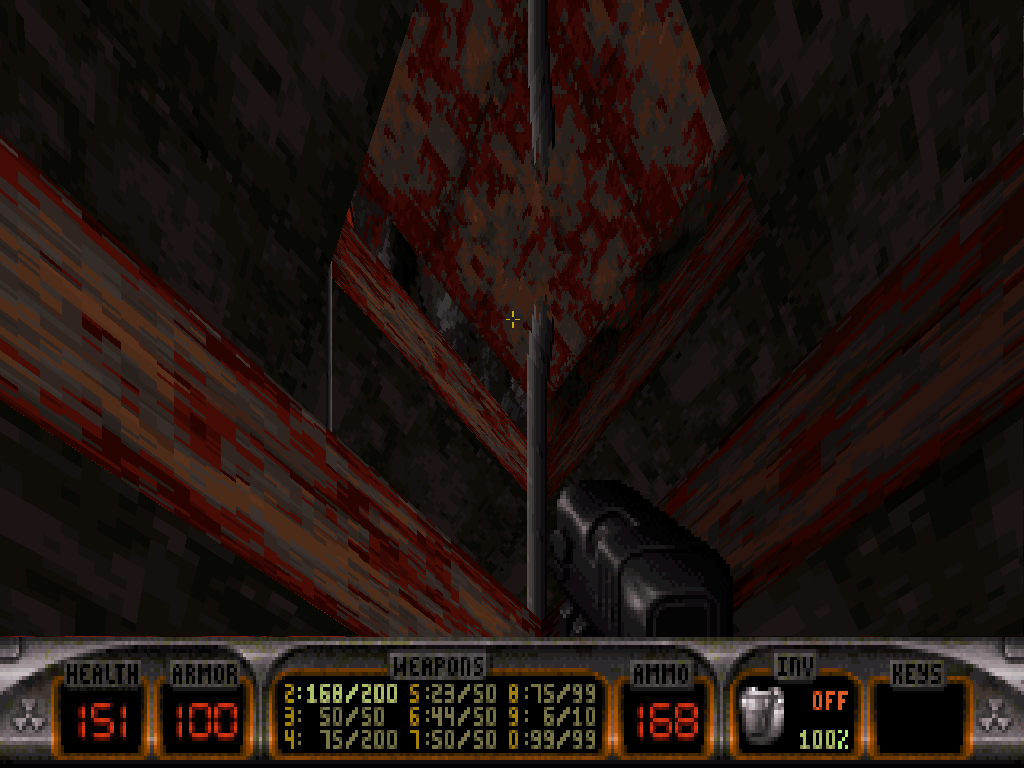
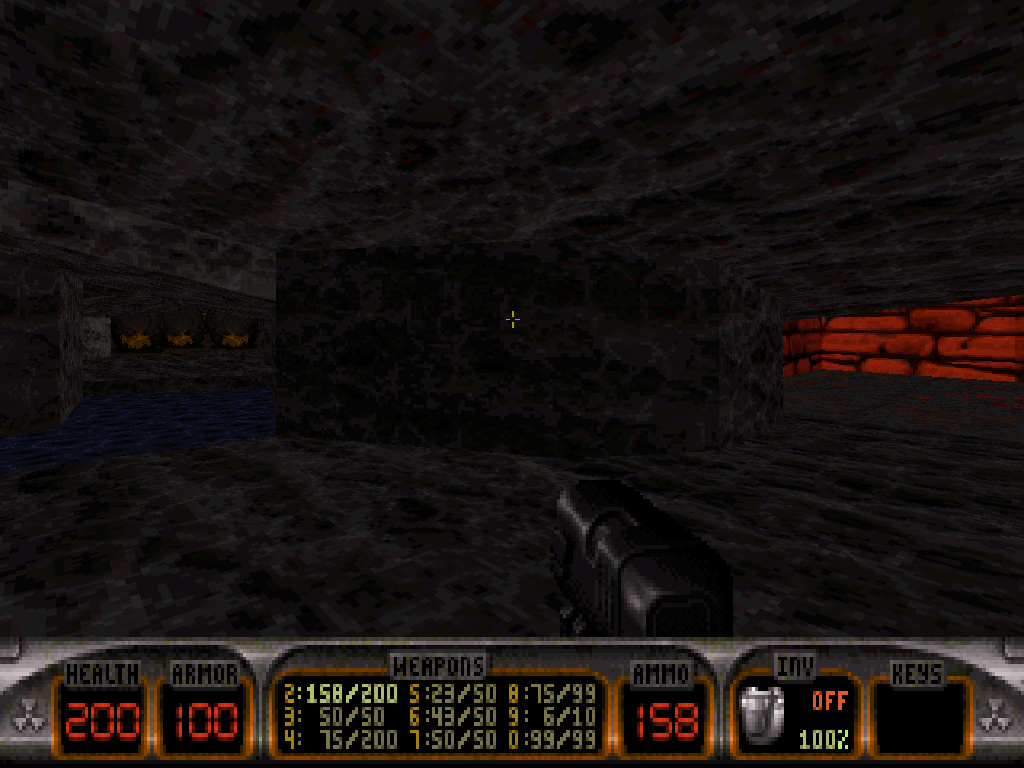
At the end of that tunnel is another cavern which splits in three different directions.
Going left is some weaponry, jetpack reach back to street level through a manhole (if Duke has any fuel left) and a sneak preview of the next challenge in the level if Duke is careful.
Going right will show an even more direct view and seemingly possible access that seems blocked for now.
Finally, exploring the center section shall take Duke, eventually, to a dead-end with a bright red handprint switch on the wall, and the grave of Philibert Aspairt.
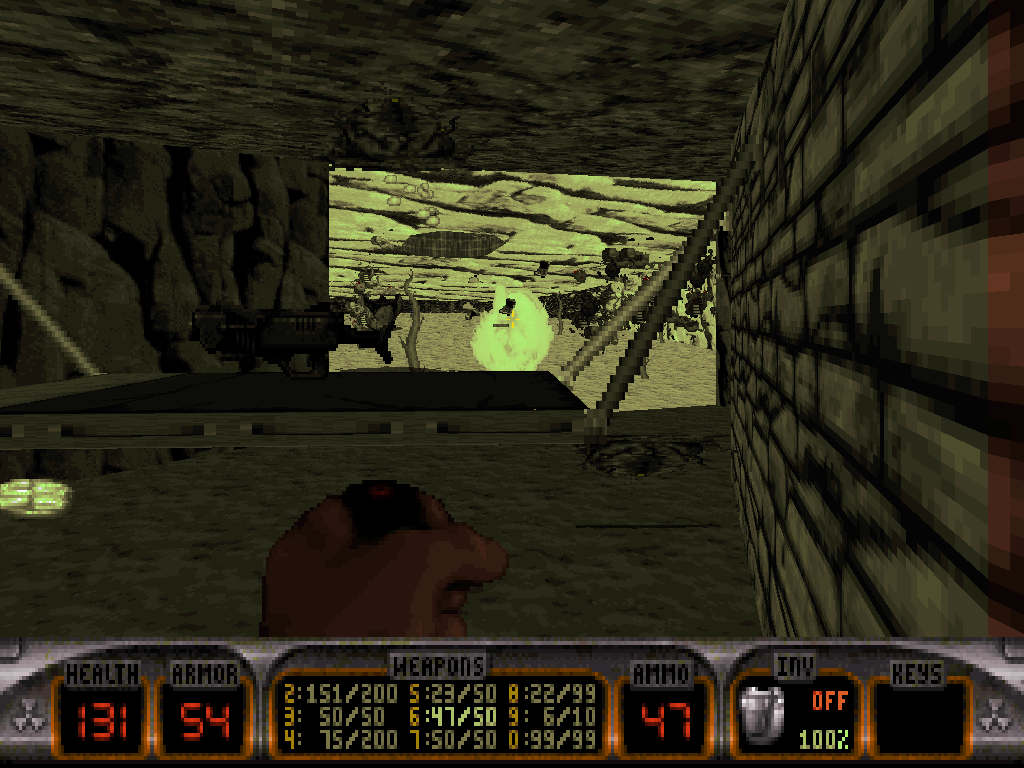
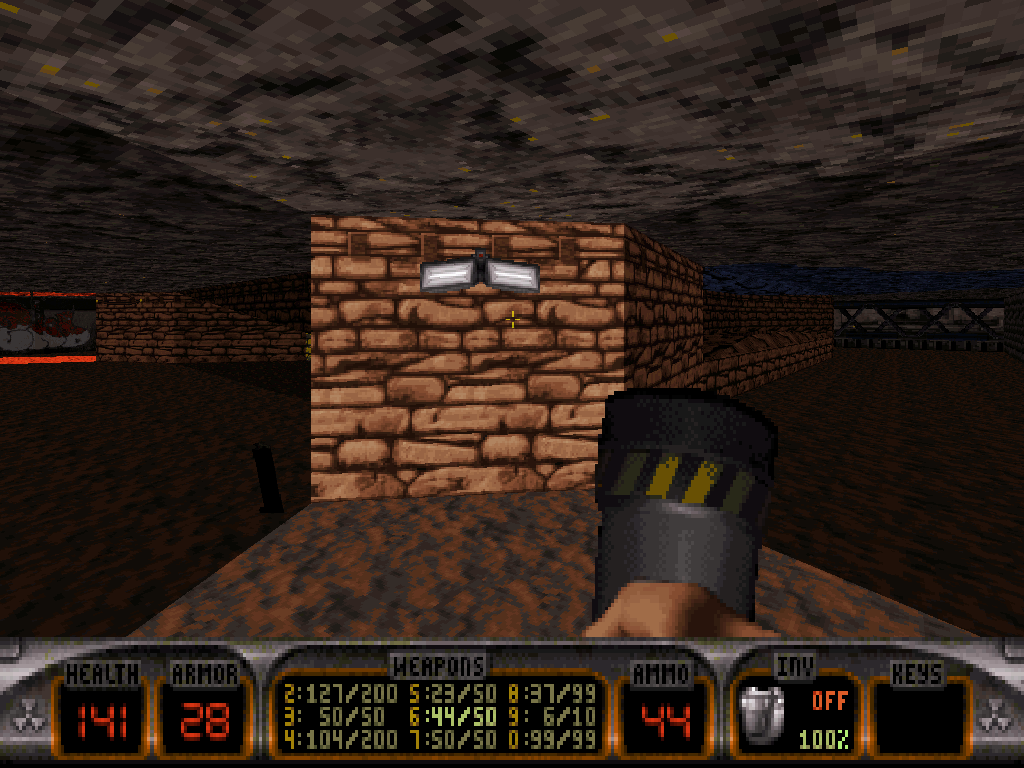
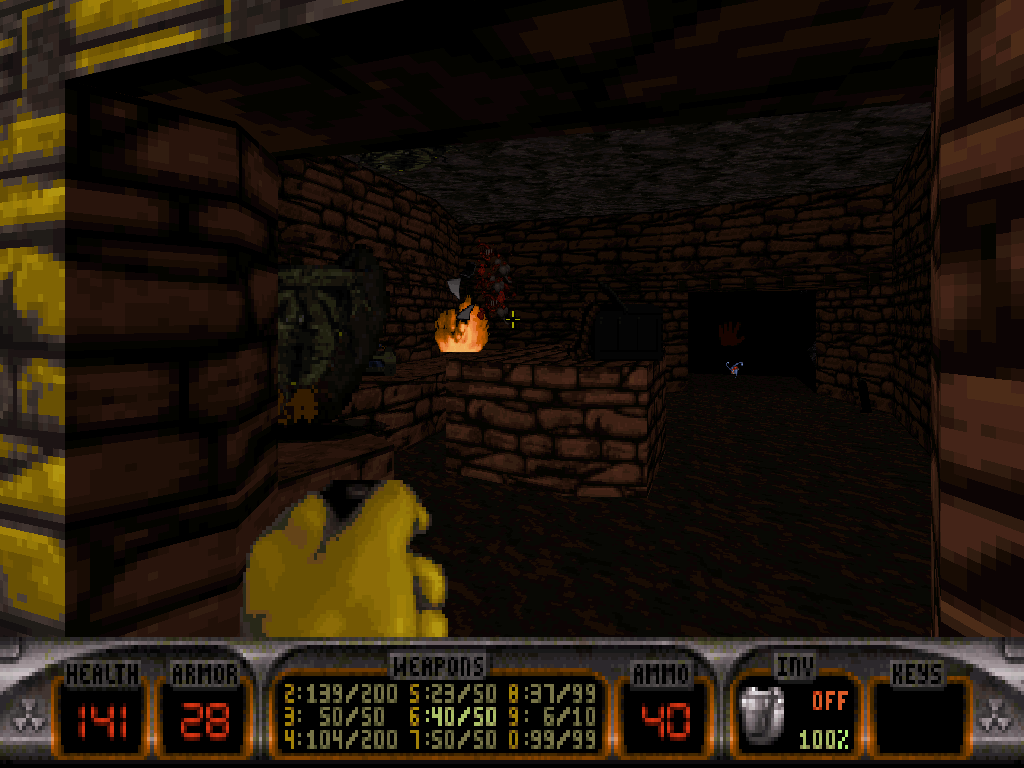
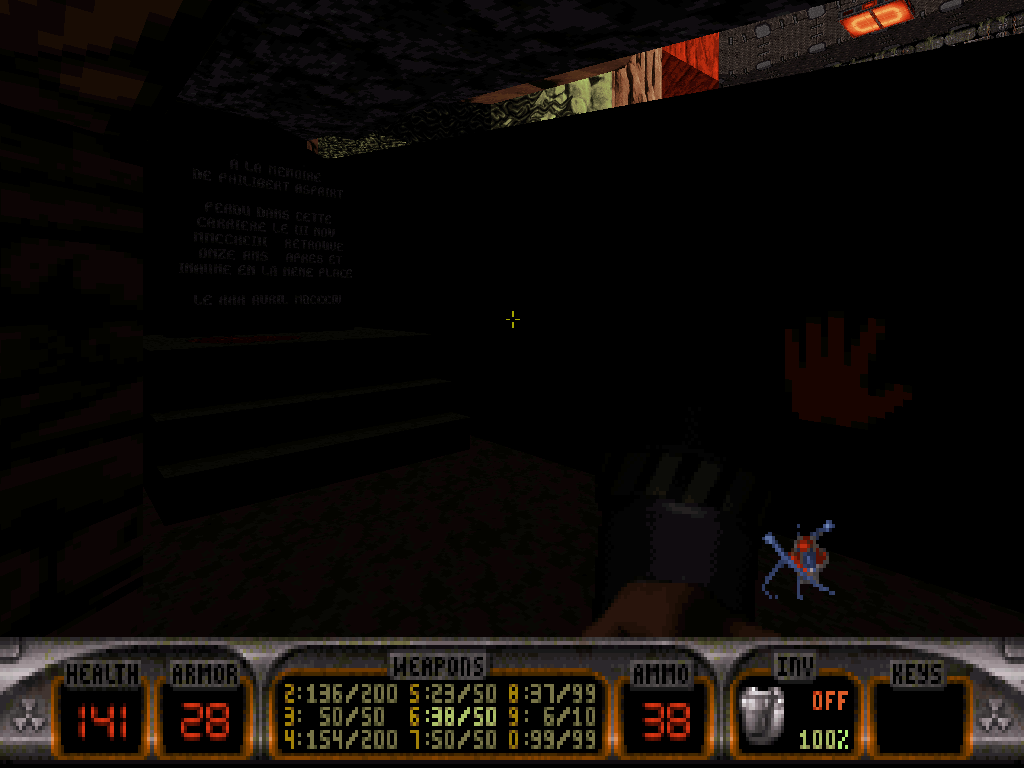
Pressing the handprint switch will cause the grave to start shooting shrinker ray in a straight line, and also explode the next wall as enemy presence awakes.
The shrink ray will traverse the hole in the wall and reach as far as the blocked entry point into the next room Duke got to see earlier, and so now he can go back there, get shrunk by the ray from the grave through the wall, and then slip underneath the barrier.
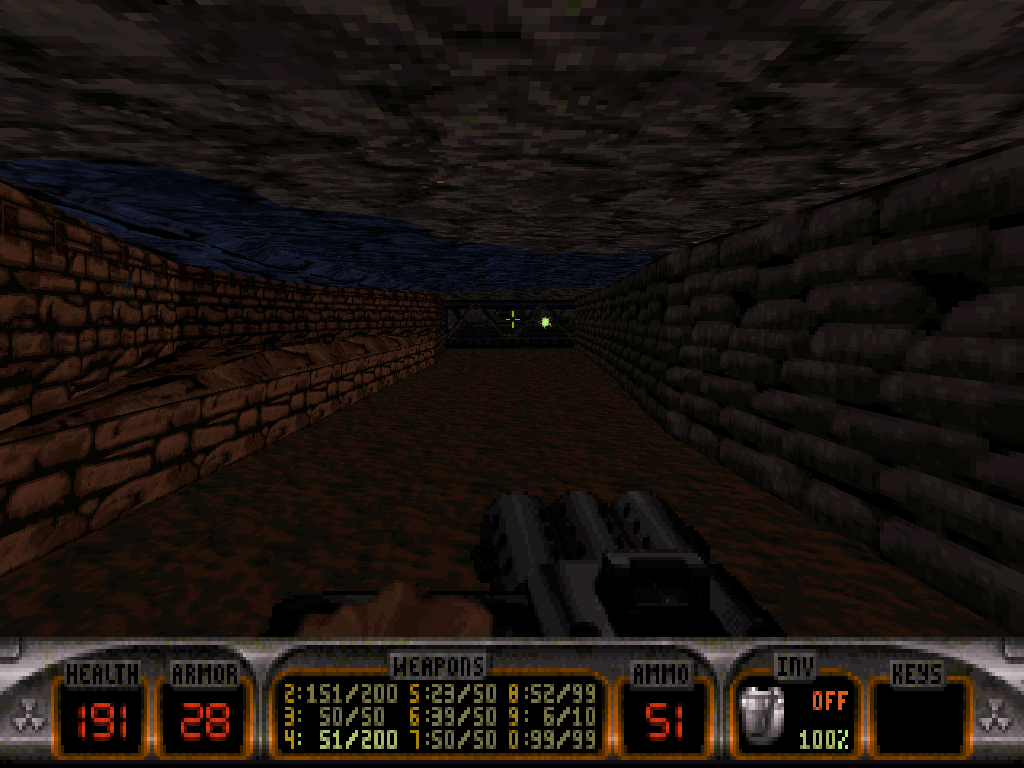
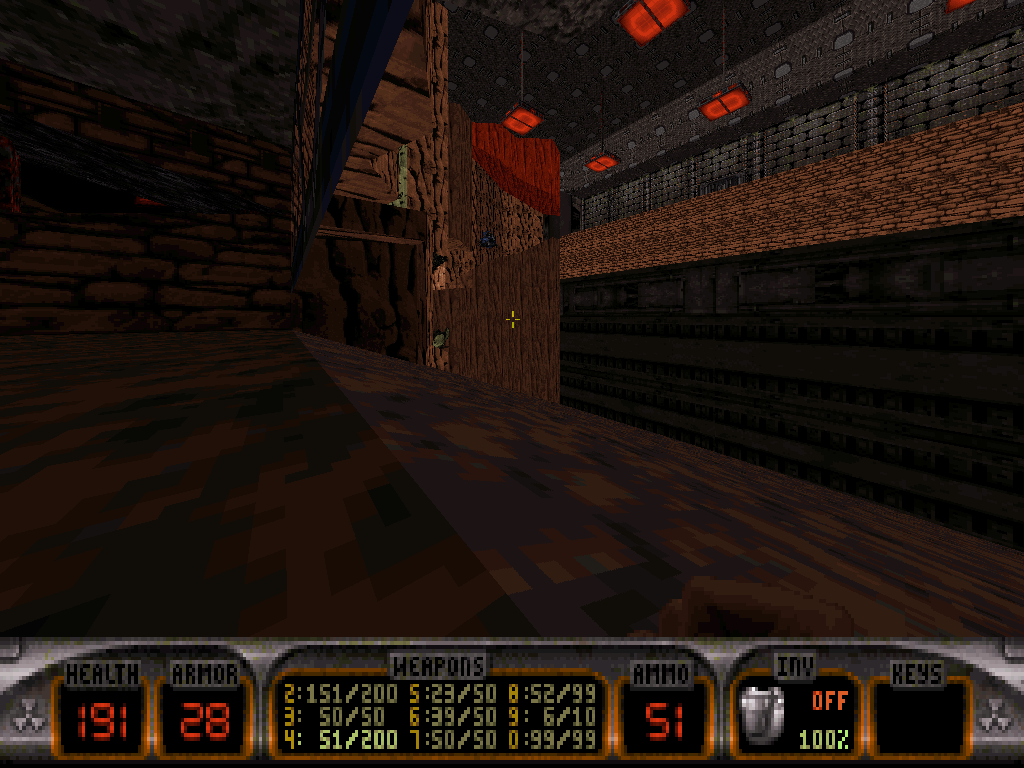
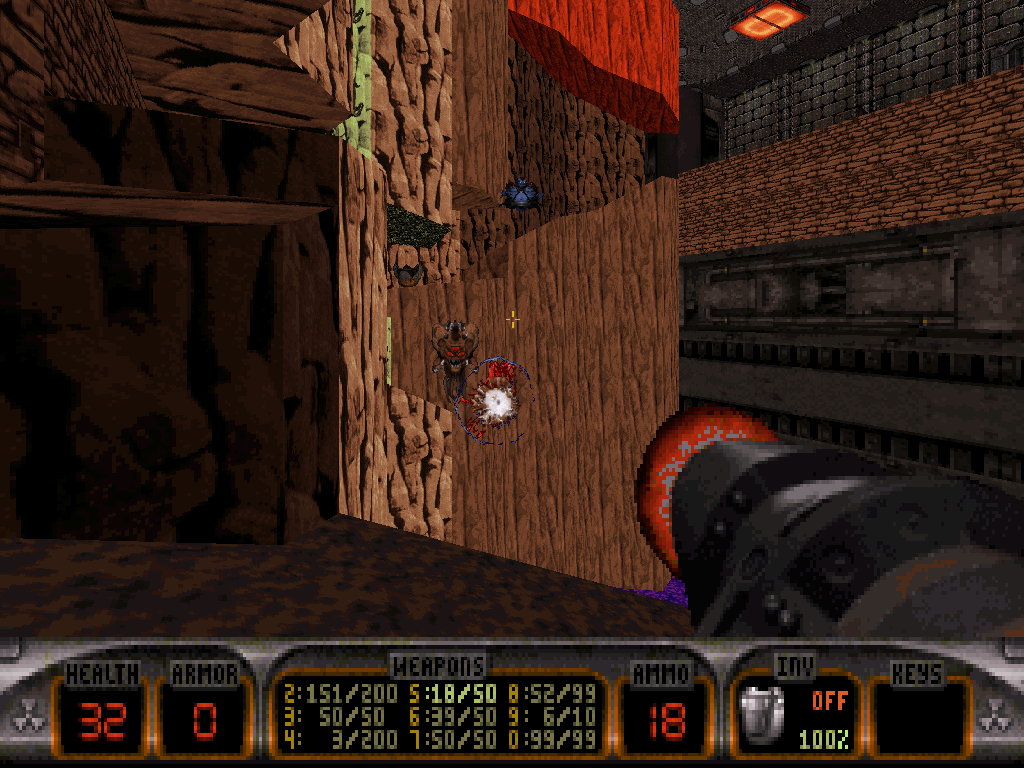
Continuing ahead, Duke shall reach a room which seemingly comprises nothing but, and is made of the skeletal remains of copious numbers of corpses.
Pressing the handprint switch on the wall there will cause the central part to rotate, revealing more of the room and the way ahead (plus a Sunburnt Cycloid Sentry on higher difficulty settings), but the revolving walls also seem to block the possibility of a direct jump as they pivot.
Even if he knows for sure he can make it, Duke would be safer jumping down to the lower section of the room on his left side, which will in turn allow him into a tunnel through all the bones that will finally take him across the room, in an elevated position.
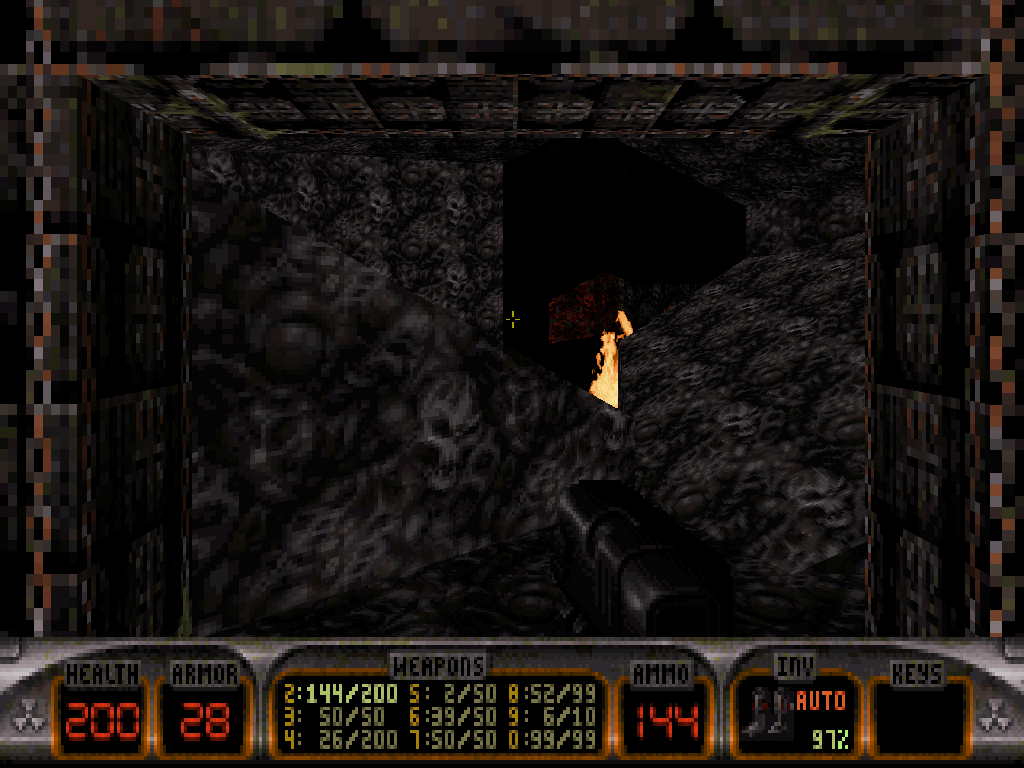
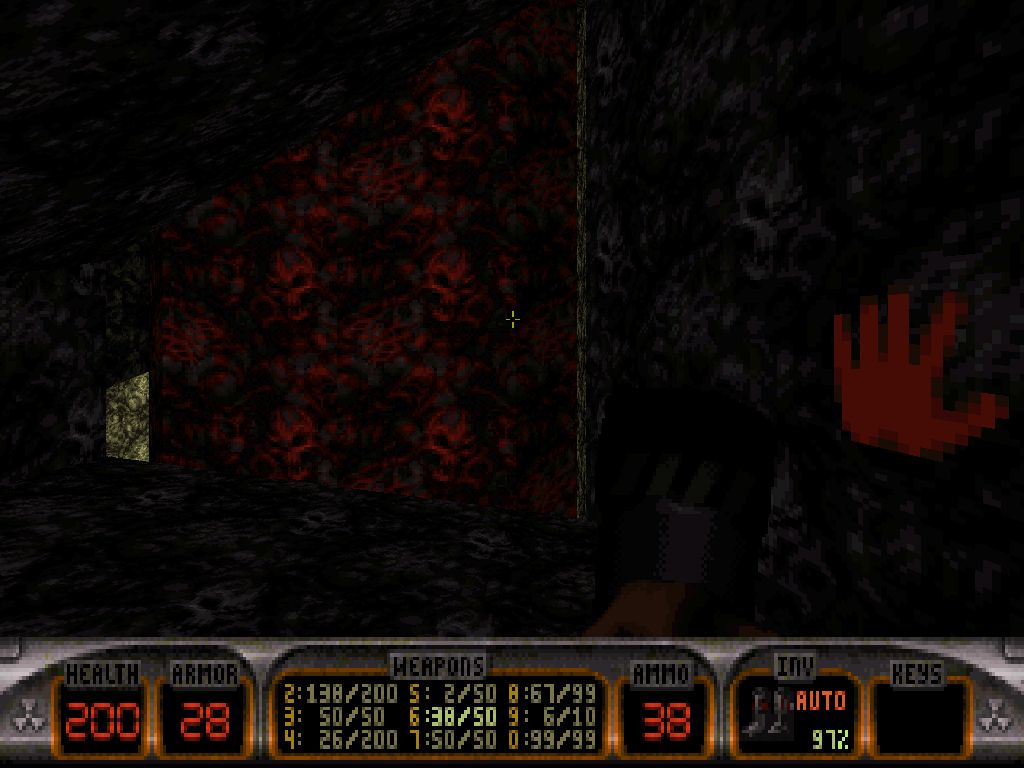
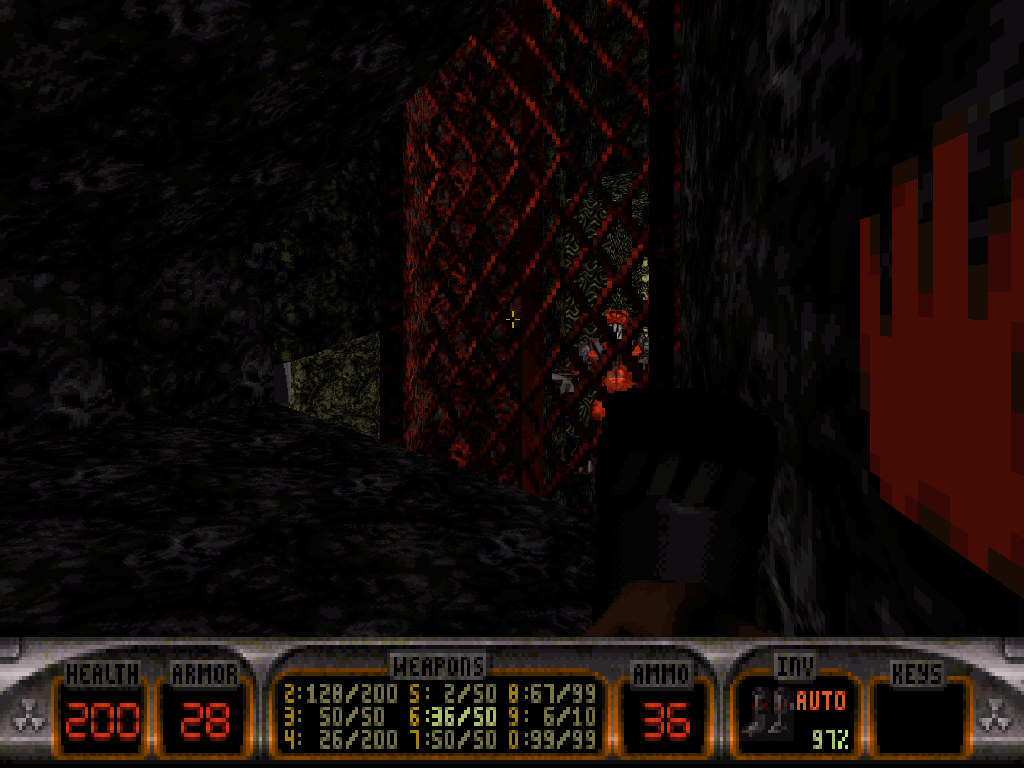
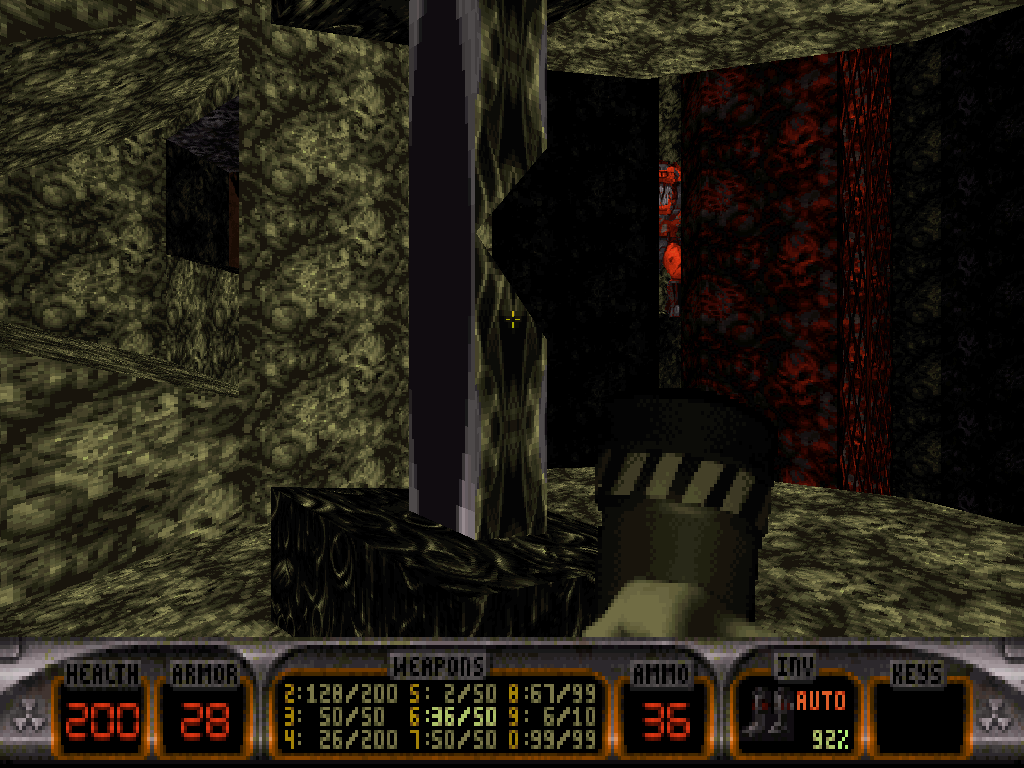
There, another handprint switch awaits; Duke can press it to cause the central part to revolve again, liberating access via a jump from the wall Duke is standing on.
Of course, the Sunburnt Cycloid Sentry awaits.
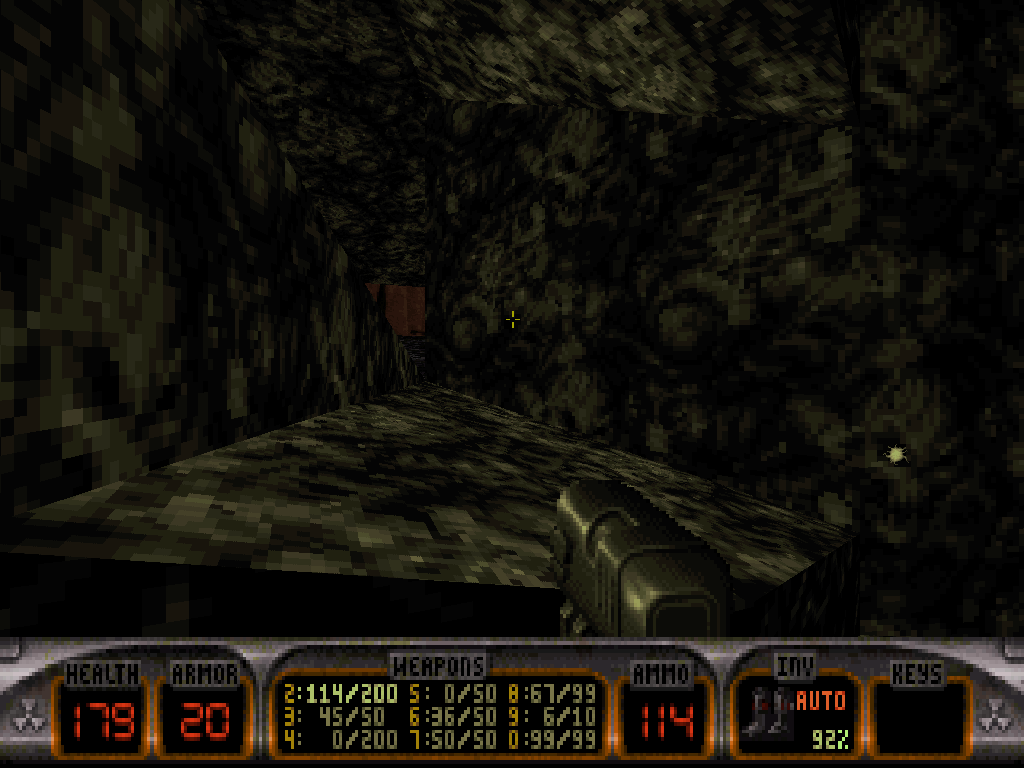
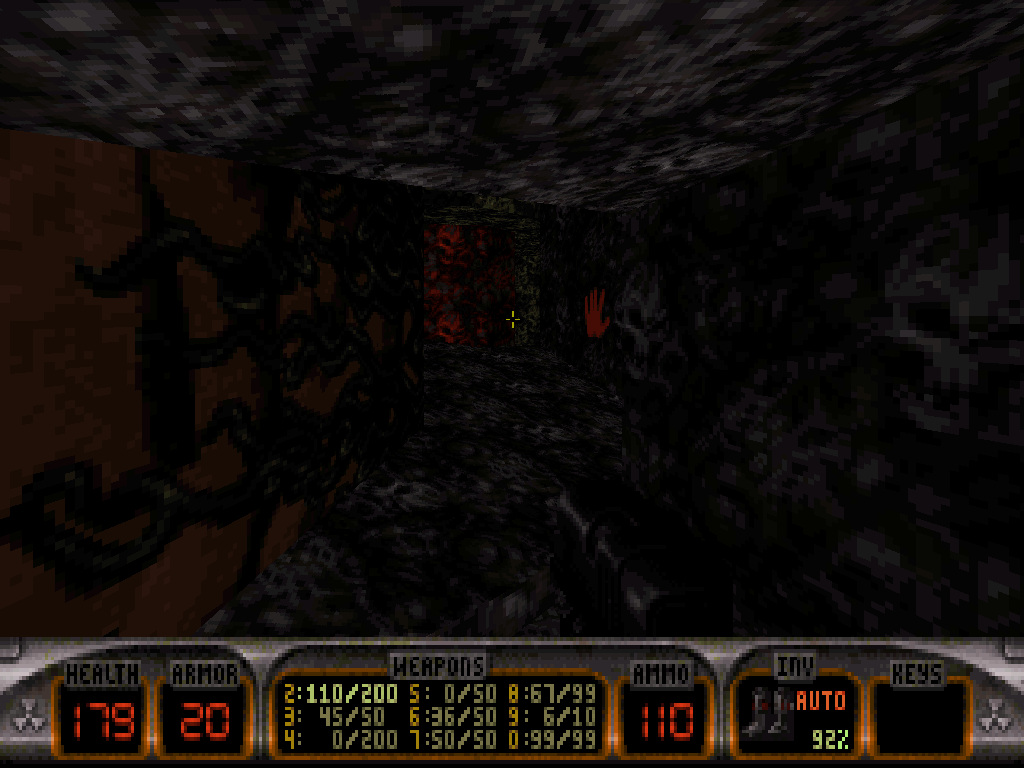
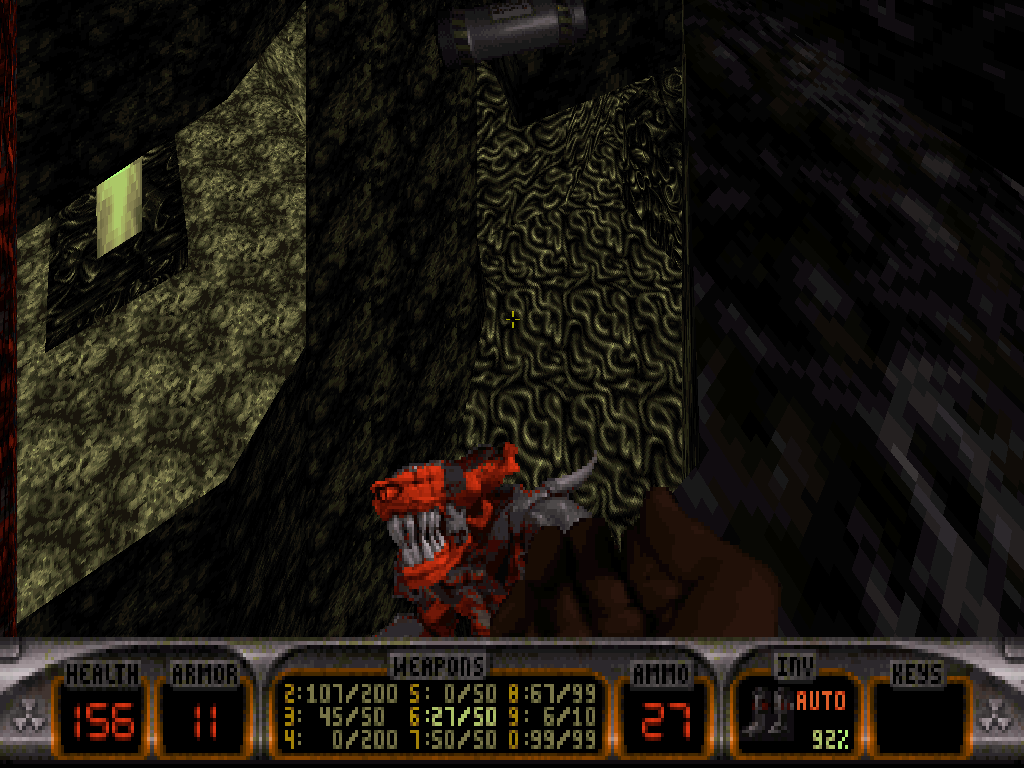
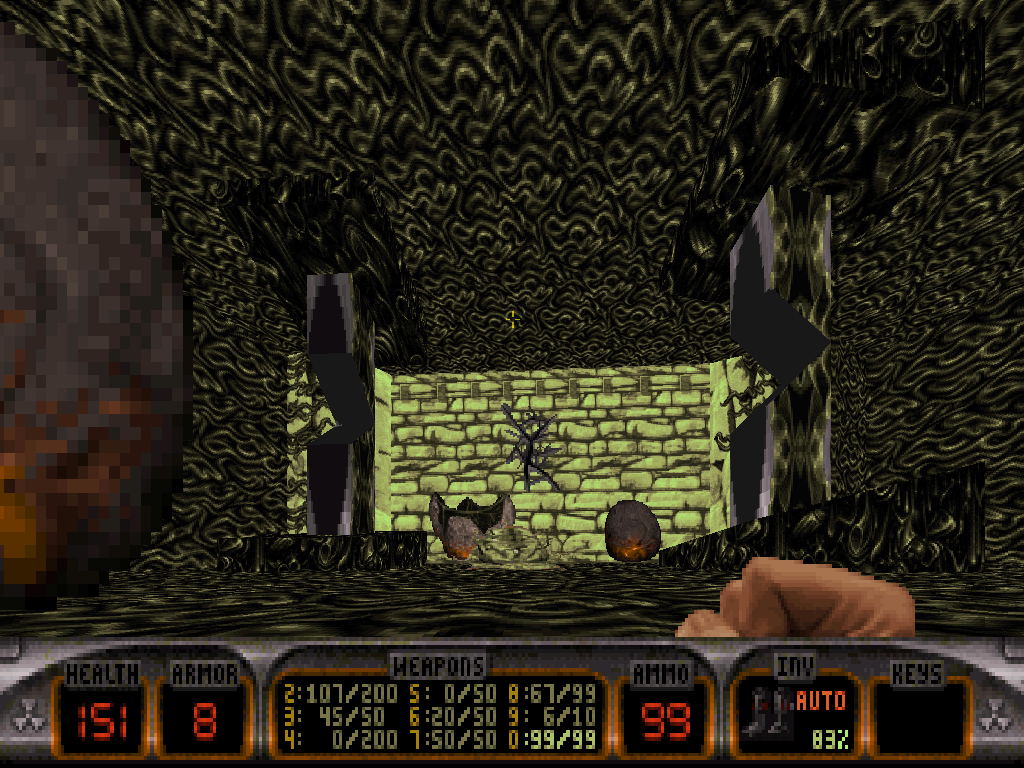
Exploding the crack in the wall in the back will lead Duke out of the catacombs and into a ventilation shaft stemming from a strange control room where a machine can be seen processing more and more dead corpses into the skeletal system Duke just traversed.
Searching around, Duke shall find the red keycard, as well as a switch to unlock the next door if he climbs up the crates.
Said door leads into a very cramped space that doesn't look designed for human standing upright position, with a switch.
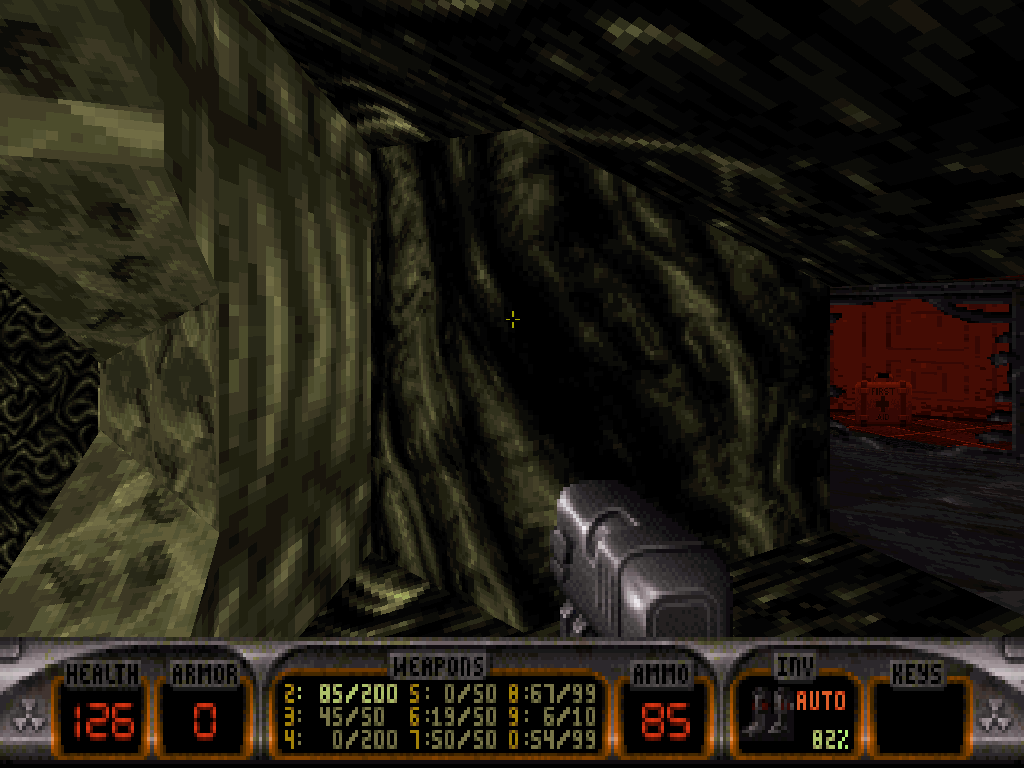
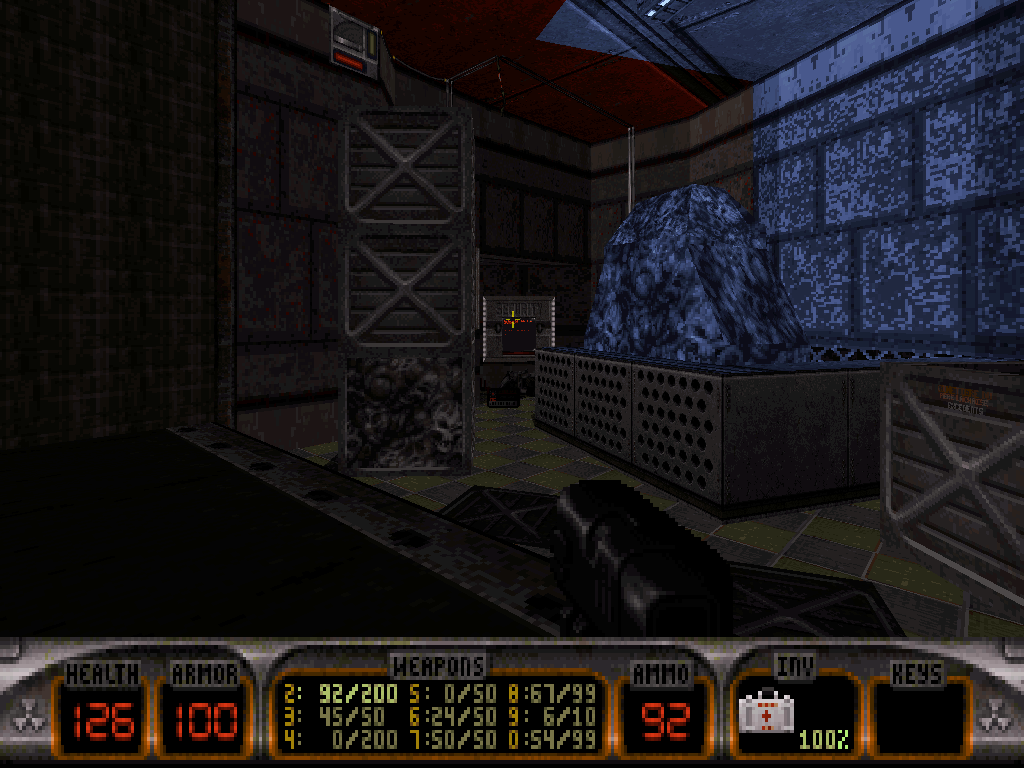
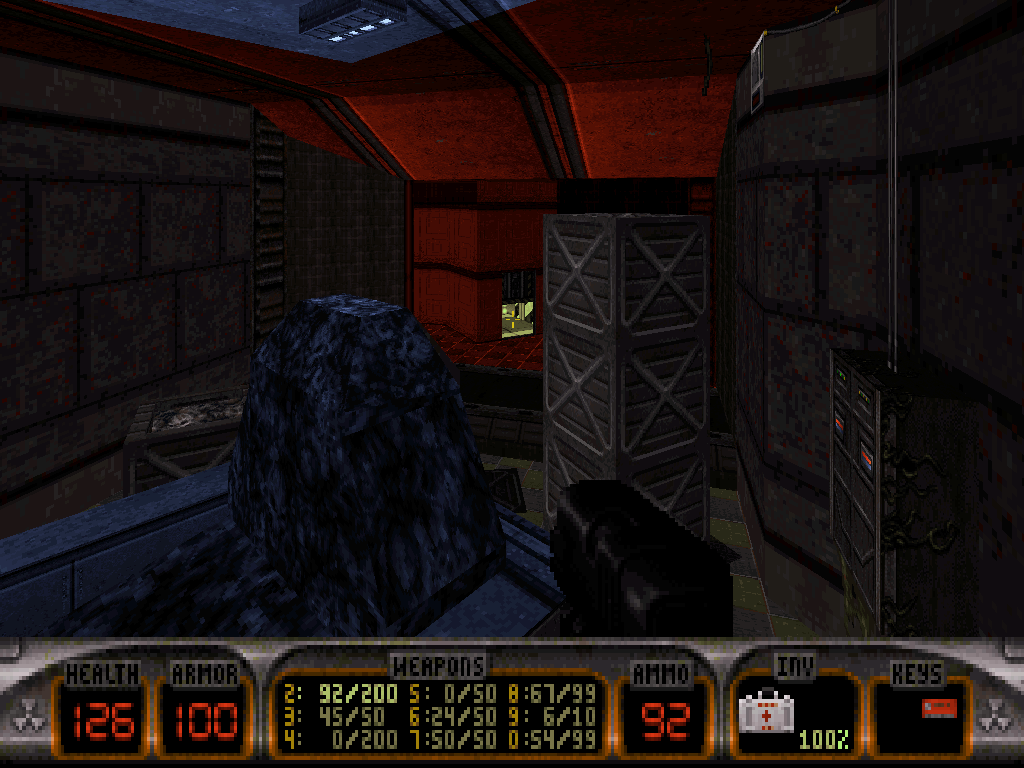
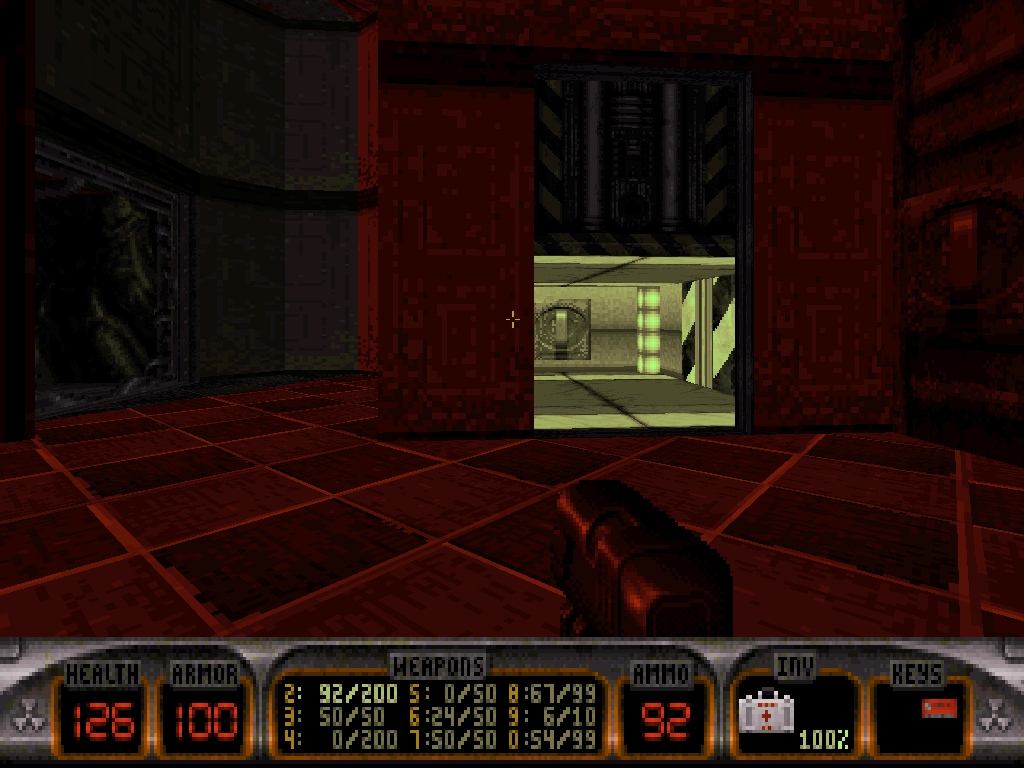
Pressing the switch will reveal the space to be some kind of elevator as Duke finds himself zooming his way back up and out into the back room of the pharmacy, after riding up what really was the lift to a secret underground morgue which keeps feeding bodies into the catacombs.
Now in possession of the red key, Duke can go unlock the gate to a loose reinterpretation of Palais Galliera, the all the way up north.
On said way of his, he shall take notice, then care of all the pissed off, last resort Pig Cop Tank and Battlelord Sentry reinforcements now deployed on the streets to punish him for breaking into the catacombs.
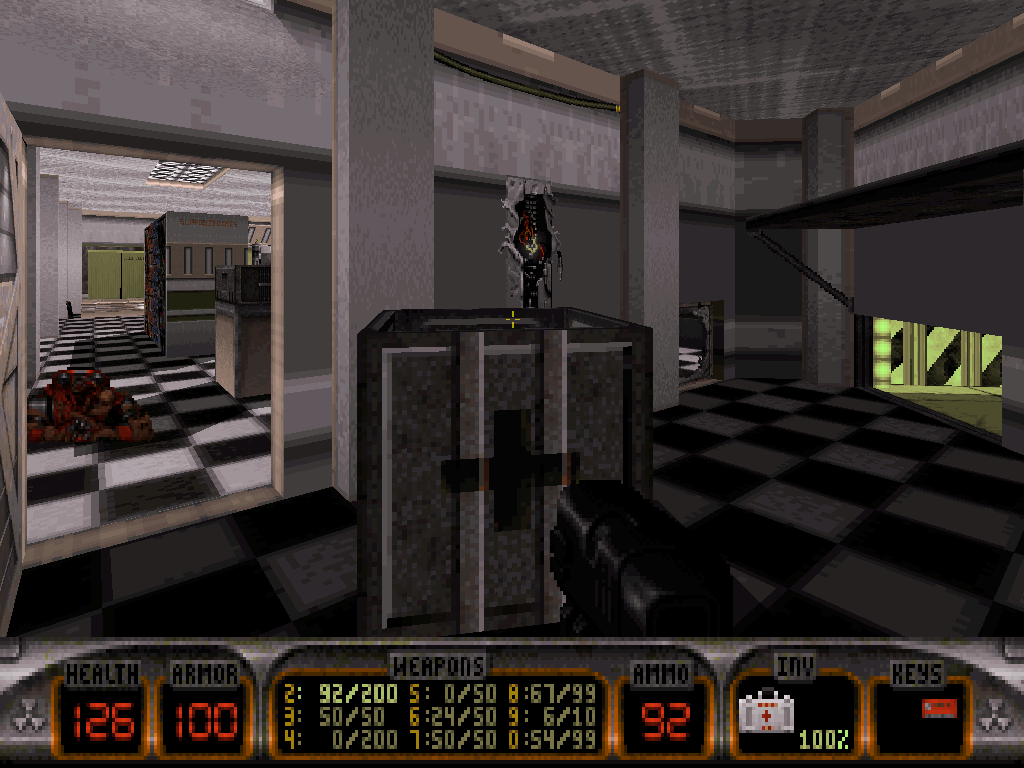
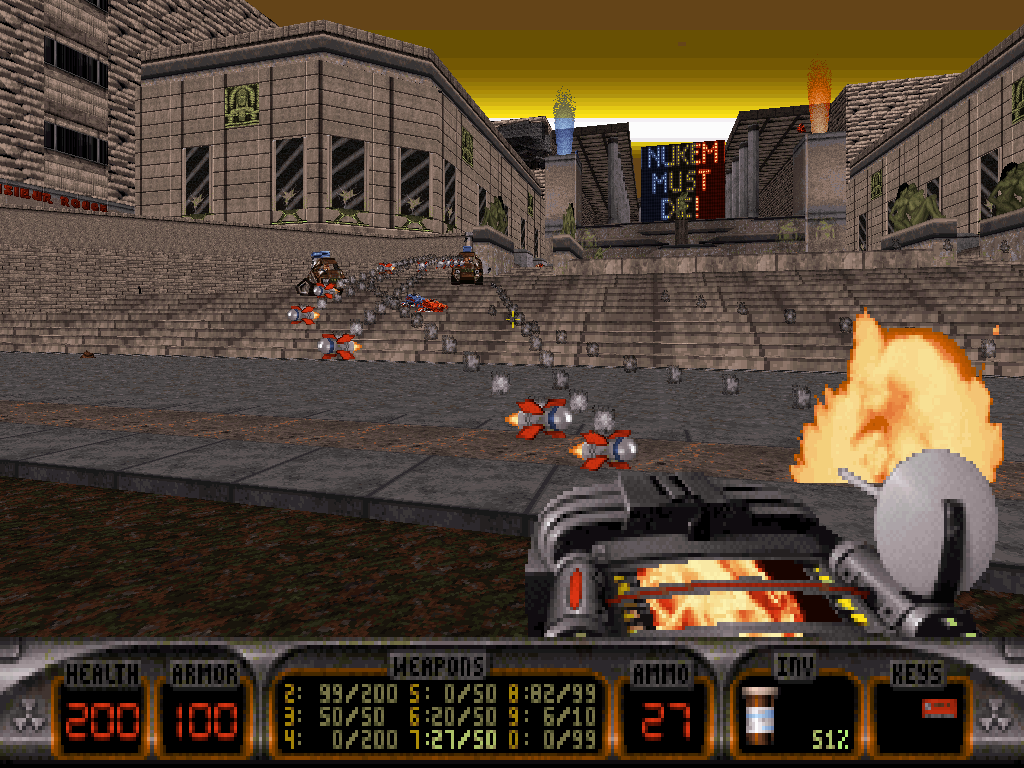
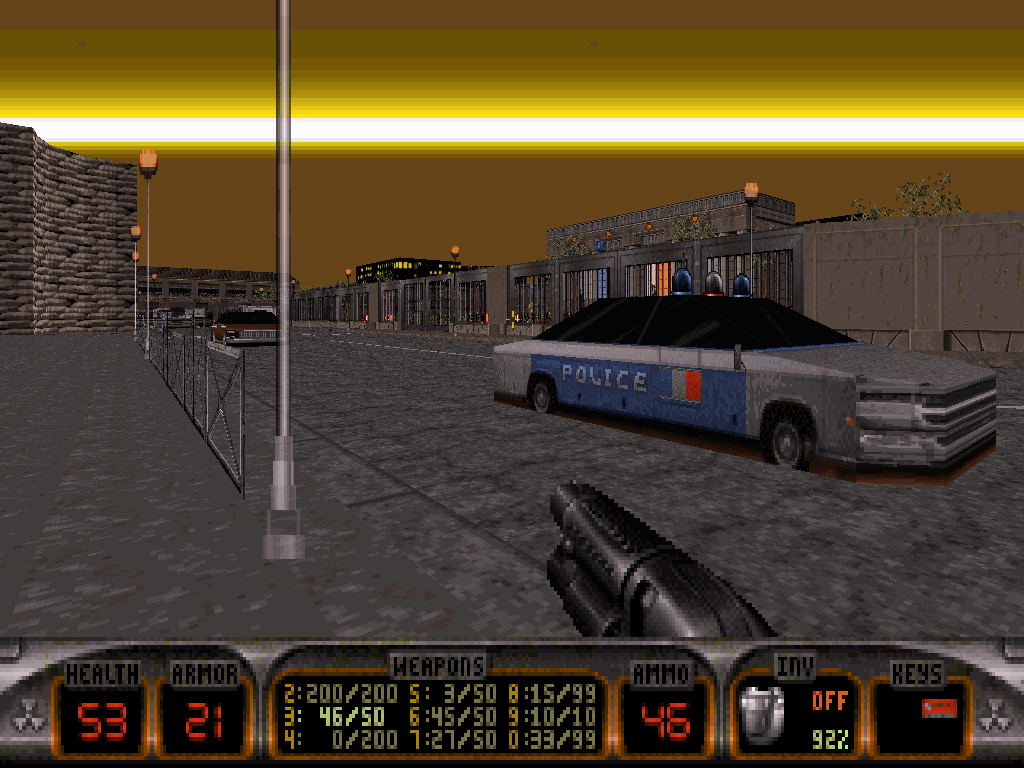
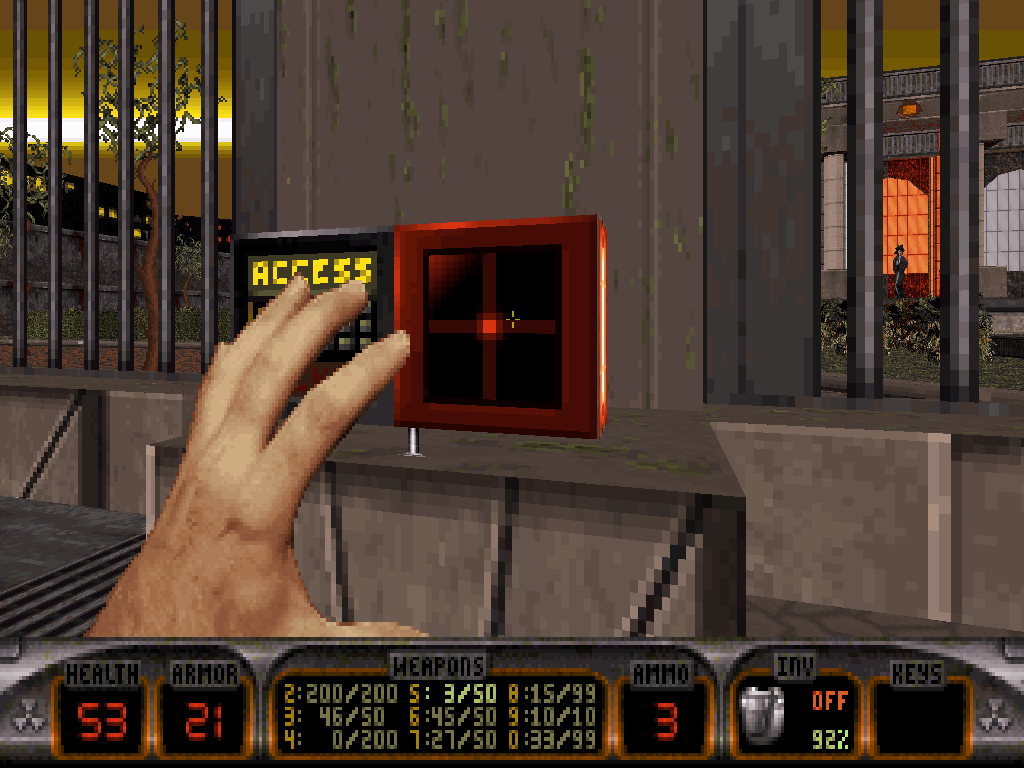
A not-so-peaceful walk around the gardens won't be without uncovering the sights of a scaffolding Duke can climb in the easternmost corner.
Doing so shall lead him to a well-guarded rooftop the sabotaged arm of a demolition crane just so happens to be overhanging, with a switch (and a jetpack) inside.
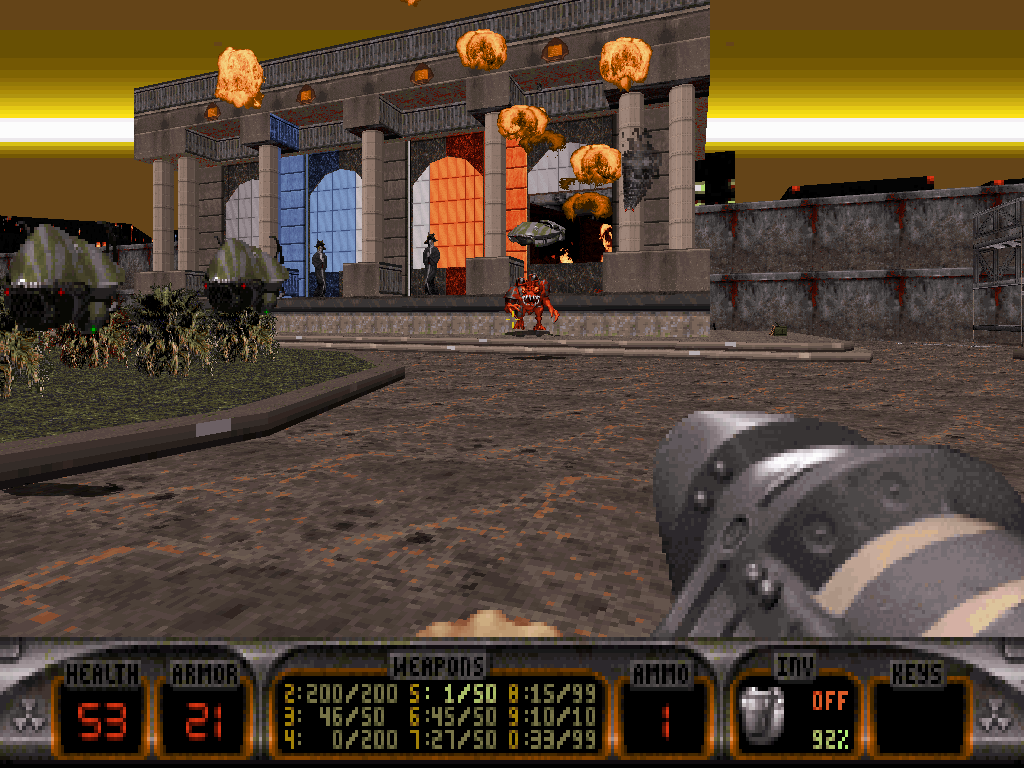
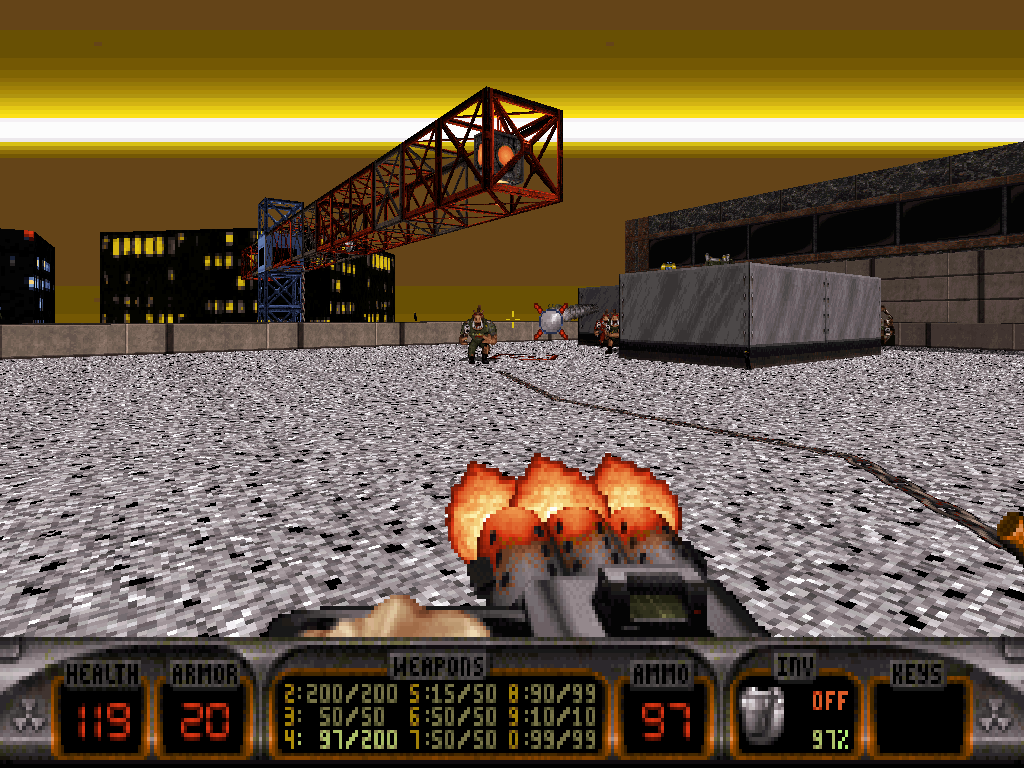
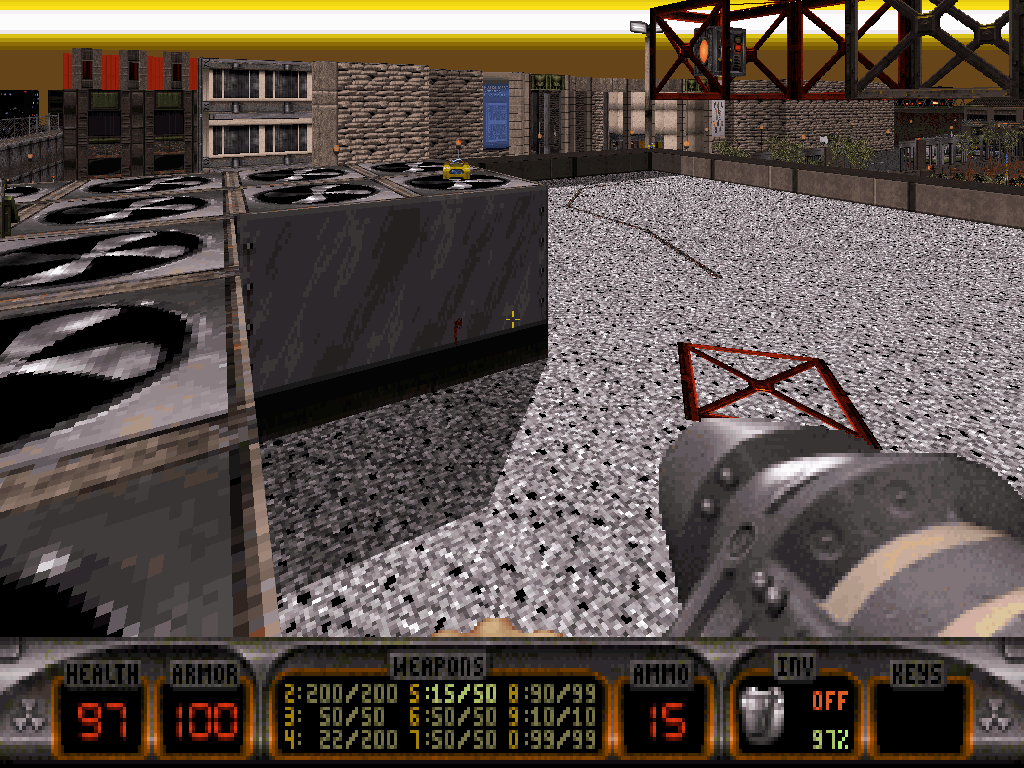
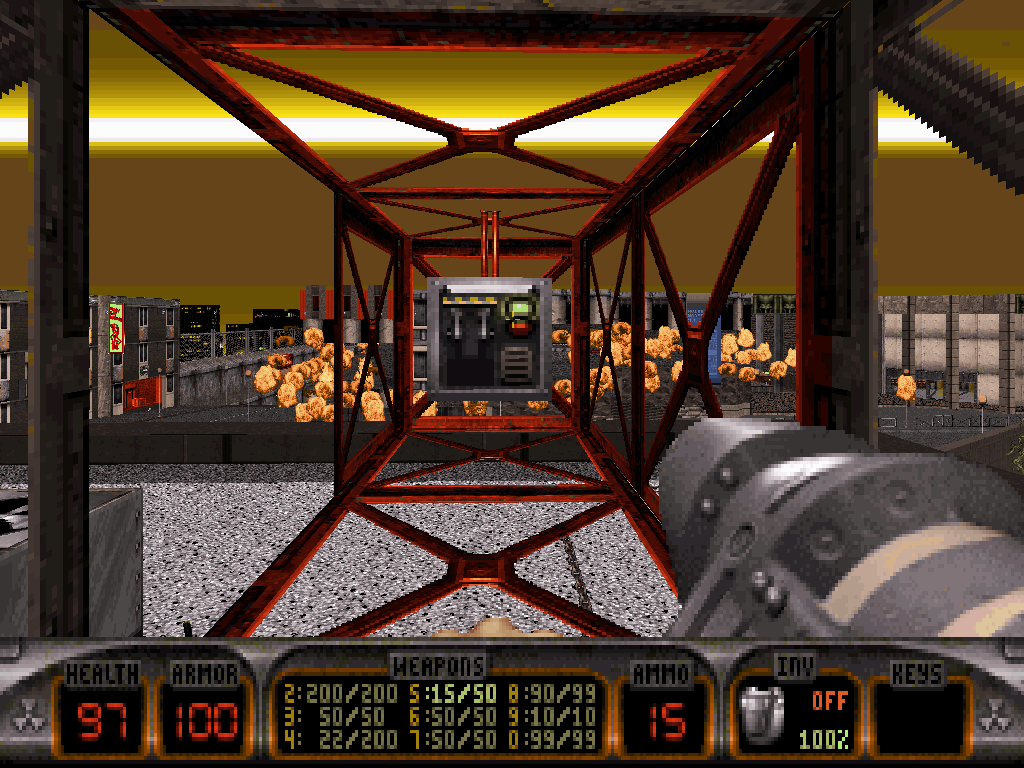
Flicking the switch will cause the whole of the eastern wing of the central museum to blow up and collapse.
Venturing there, either by flying, some clever platforming or through the pharmacy again shall take Duke to his first ever encounter with the Cycoid Emperor (distinct from the Cycloid Emperor Sentry in that it shoots gamma ray bursts and qi energy balls), and, finally, to the level exit(s), successfully ending Duke's Parisian charade.
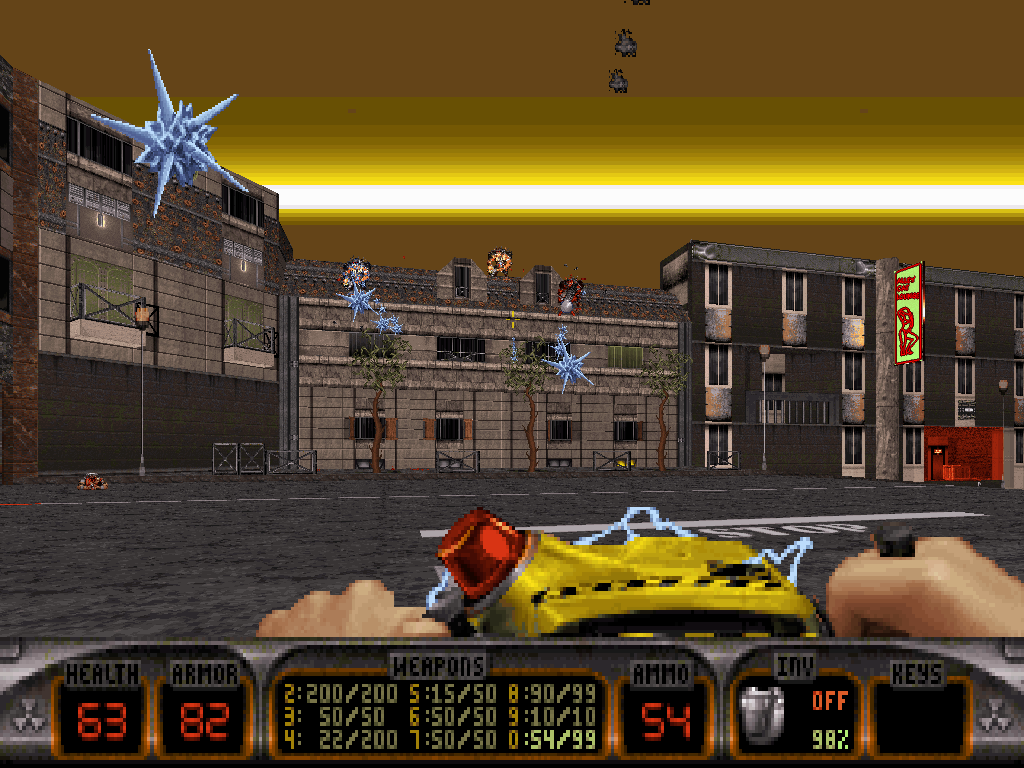
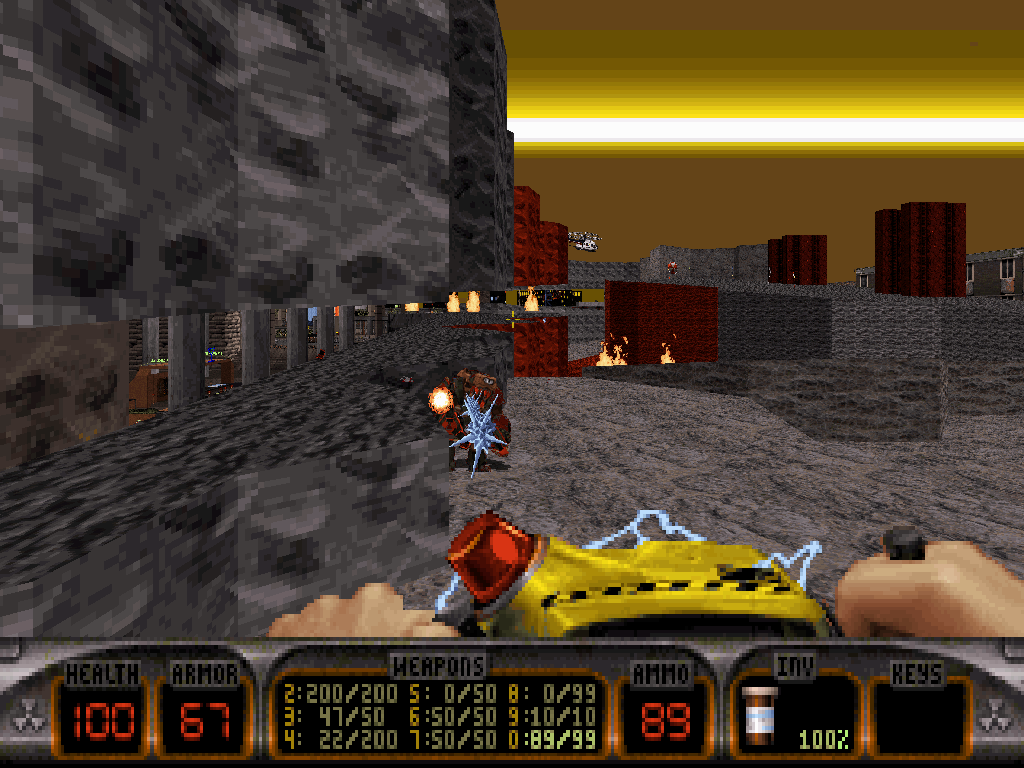
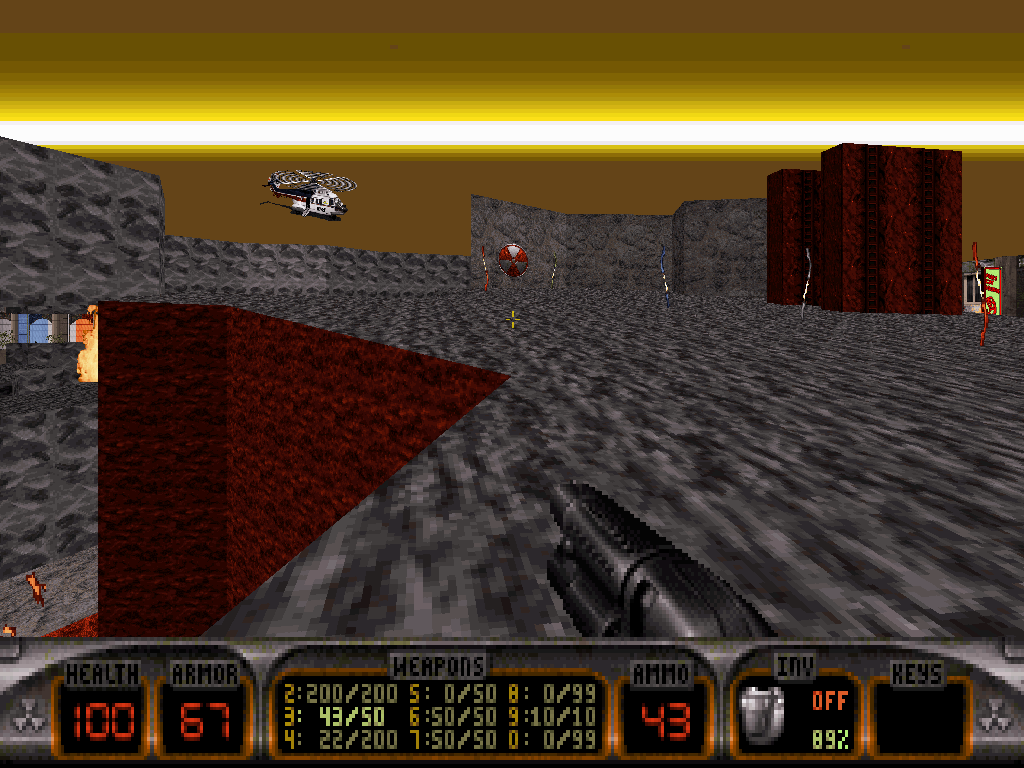
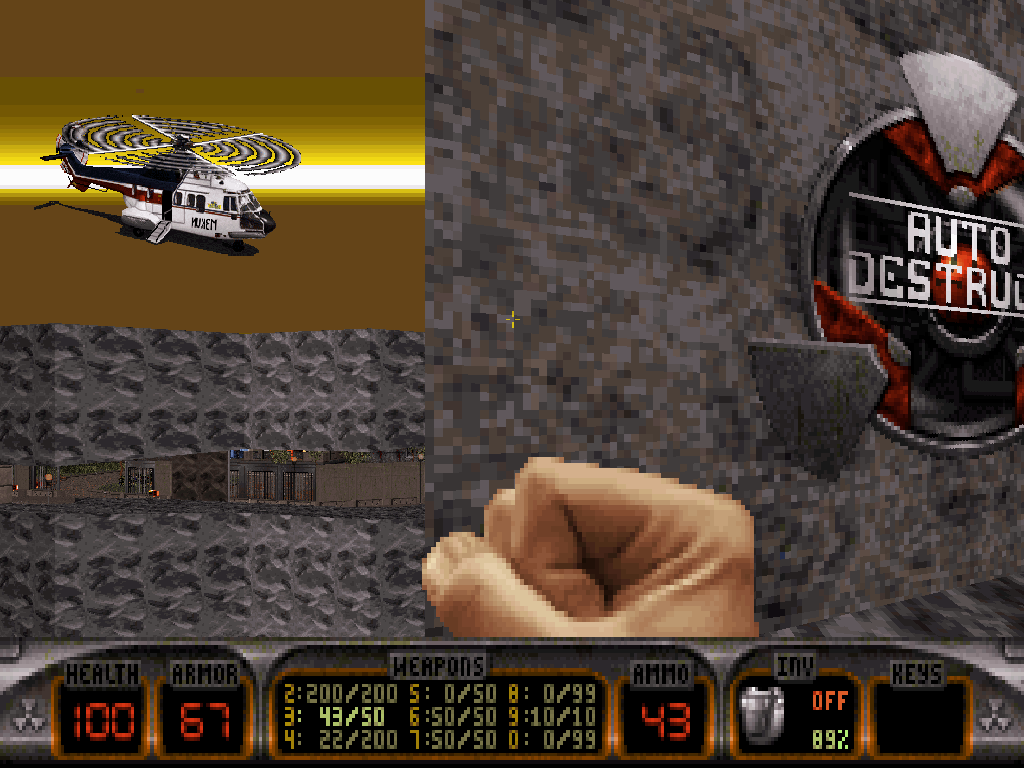

Par time route:
In general but most particularly for speedruns, "Lights, Camera, Revolution" functions very much the same as "Koj Stil Borac", the previous level, did, with the one task Duke needs to complete in order to unlock the exit really being accessible as soon as from level start, if he can survive rushing straight to that point and then back (and he can). In the case of "Lights, Camera, Revolution", if on a roids rush, his primary goal should be making it to the red keycard-locked gardens, then to the crane arm as fast as possible, in order to hit the final destruction sequence switch and liberate the Nuke Button(s).
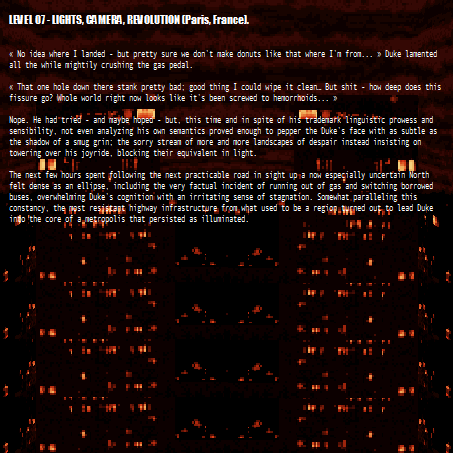
Page from the manual.
As the next Particularities subsection will highlight again, absolutely every key in "Lights, Camera, Revolution" can be skipped, by either bypassing the corresponding locked gates or sometimes ignoring them entirely.
Officially registered par times for the level were achieved without relying on the level's most absolute skip and so probably are very easy to beat.

Particularities:
"Lights, Camera, Revolution" has the considerable responsibility in being central to Duke's whole journey through Blast Radius, occupying the crucial spot of level seven out of fourteen. As such, in addition to yearning for feeling special in itself, it also had a pivotal role to play, as the meeting point of two narrative halves; all the while keeping serving the linearity of the progression and immersion thus far, and presenting Duke with fresh challenges and sights nonetheless.
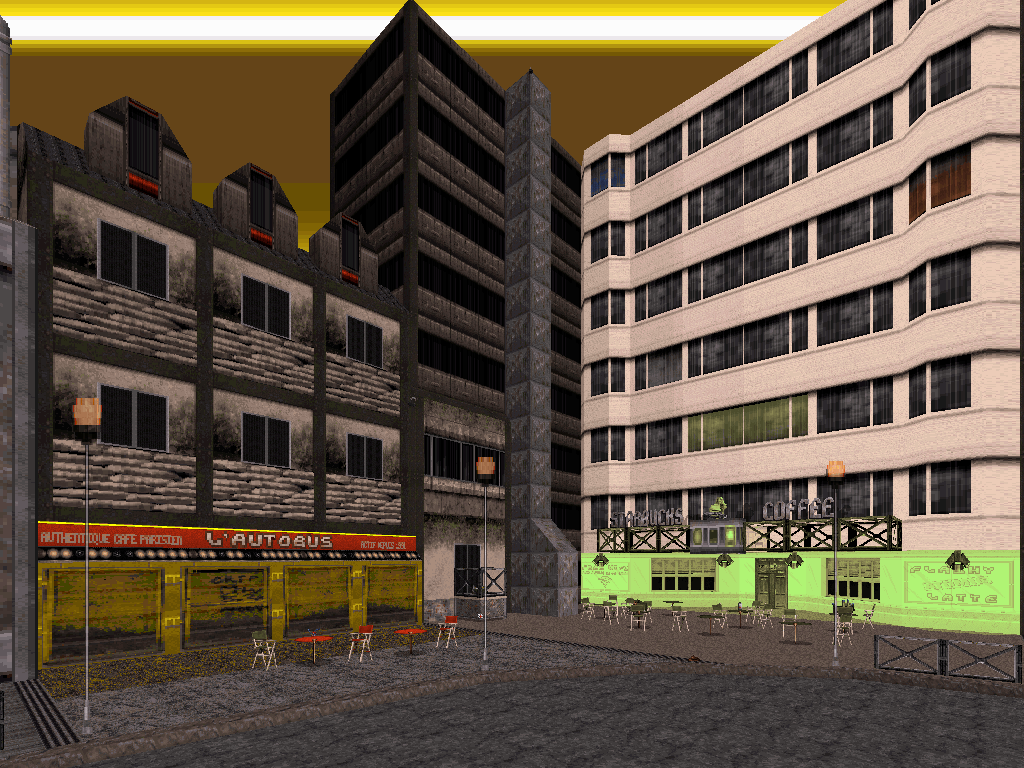
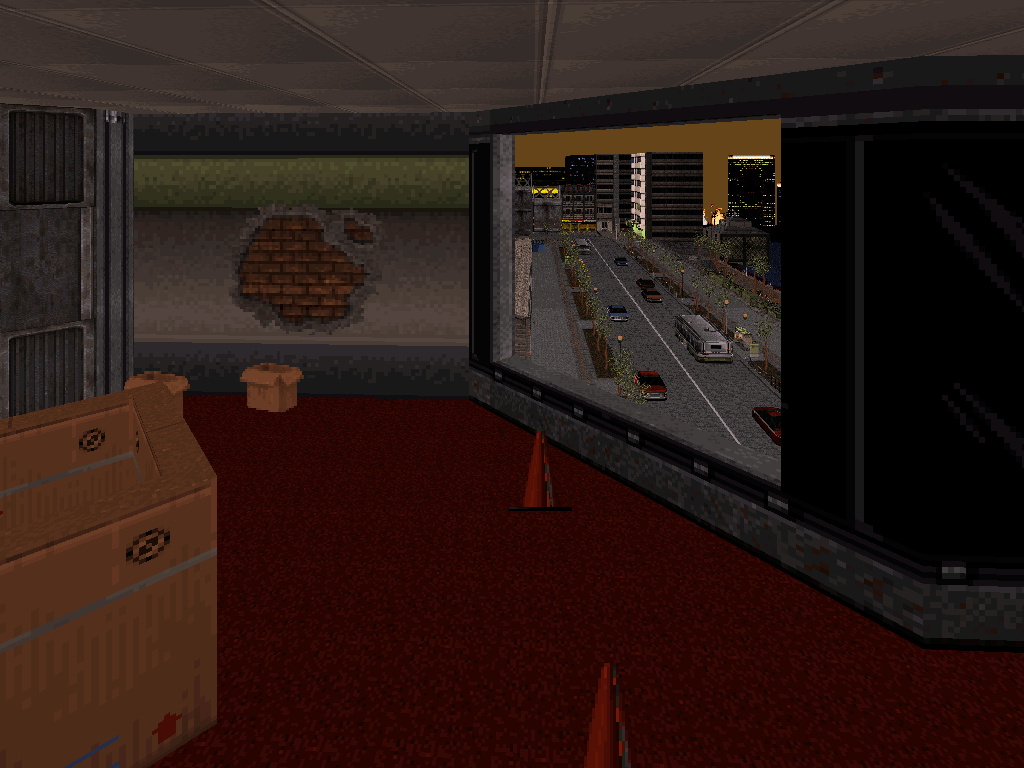
A bit reminiscent in concept of the previous level set in Croatia: "Koj Stil Borac" which also relied on, first, an open-ended city block, and then the later reveal of a formerly invisible, unpredictable underground dimension of the level running under the streets (using the trademark sector-over-sector capabilities of the Build engine), "Lights, Camera, Revolution" takes a few steps back from the extreme approach of being the episode's 'jetpack map', offering Duke three keys (and locks) as opposed to just one and, through a copious amount of doors, odd-shaped rooms and quirky passageways, a megaton worth of nooks-and-crannies.
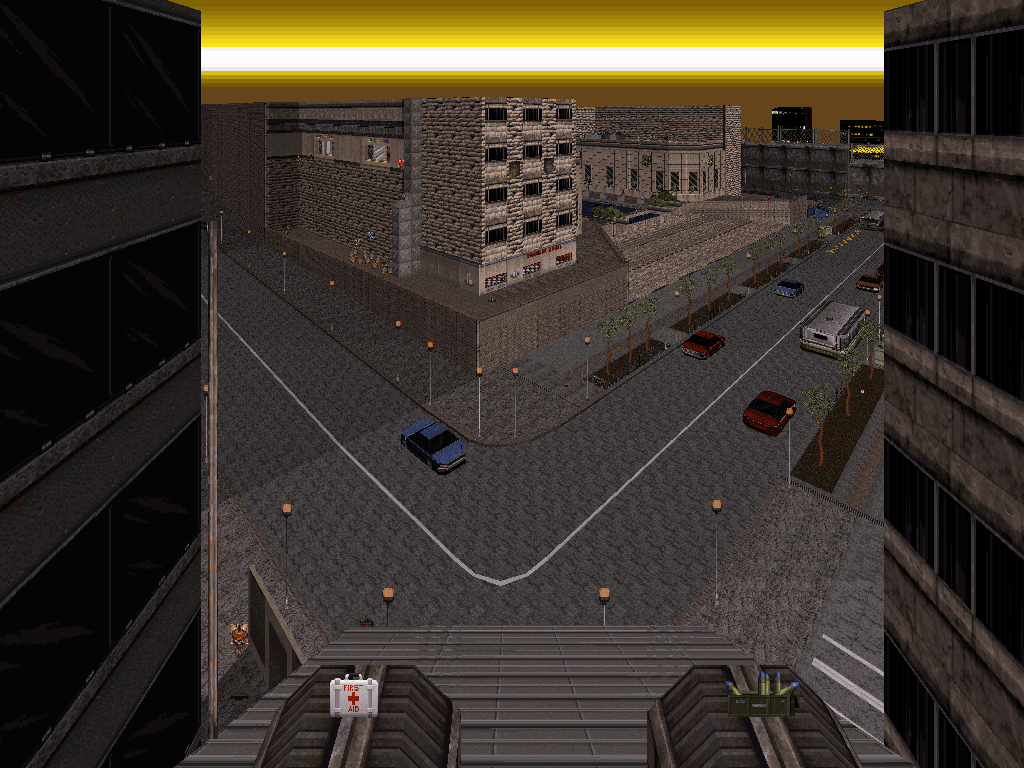
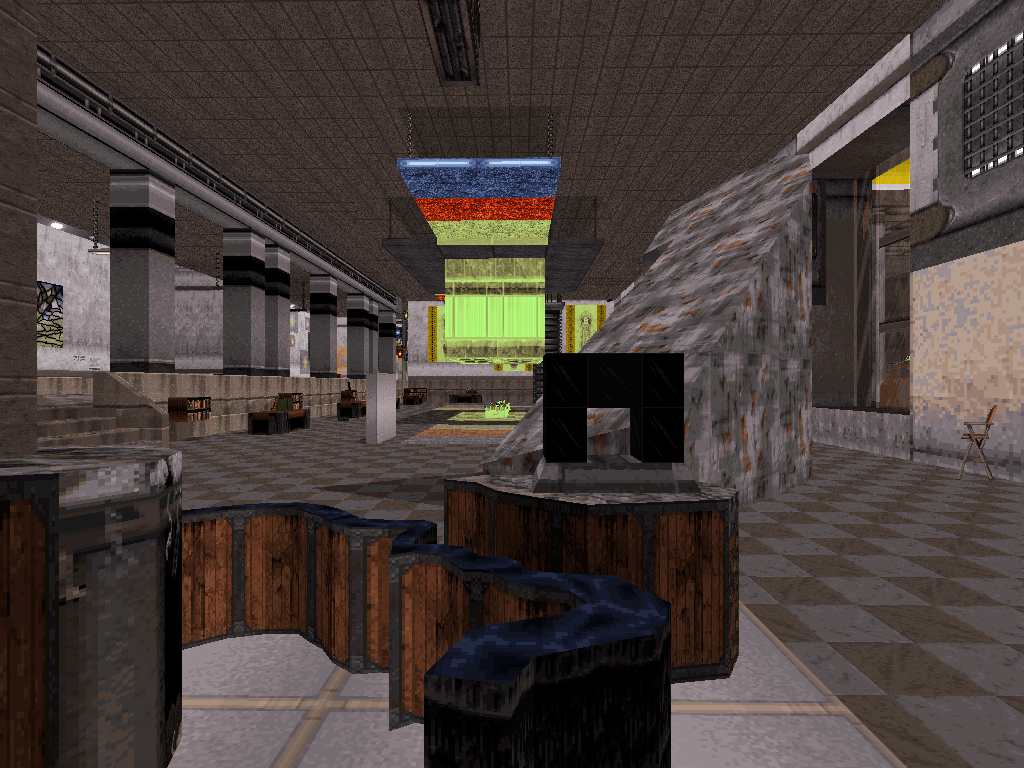
As the level of equilibrium, "Lights, Camera, Revolution" doesn't neglect to, and further dares exist as a set-up for what's essentially one big riddle, where Duke's puzzle-solving skills keep being tested in various, successive ways in order for him to unlock progress. Every next room just keeps providing with different intrinsic challenges, bombarding Duke with a palette of visuals, colors, themes and encounters which only the central heart of the level suffices at tying together.
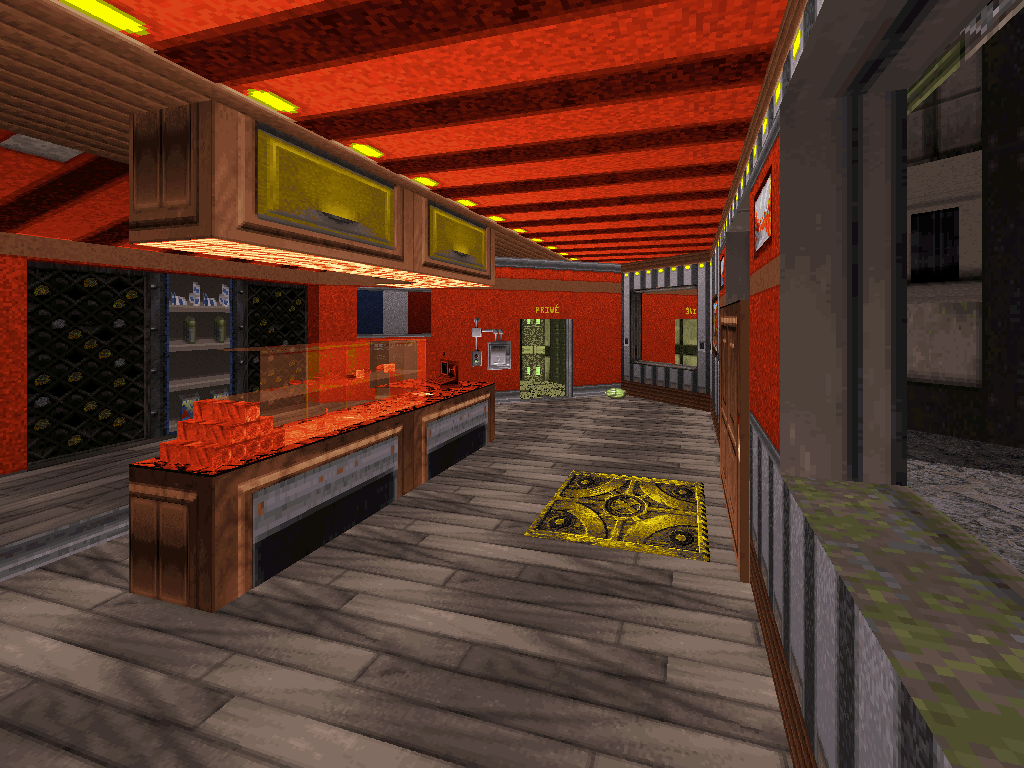
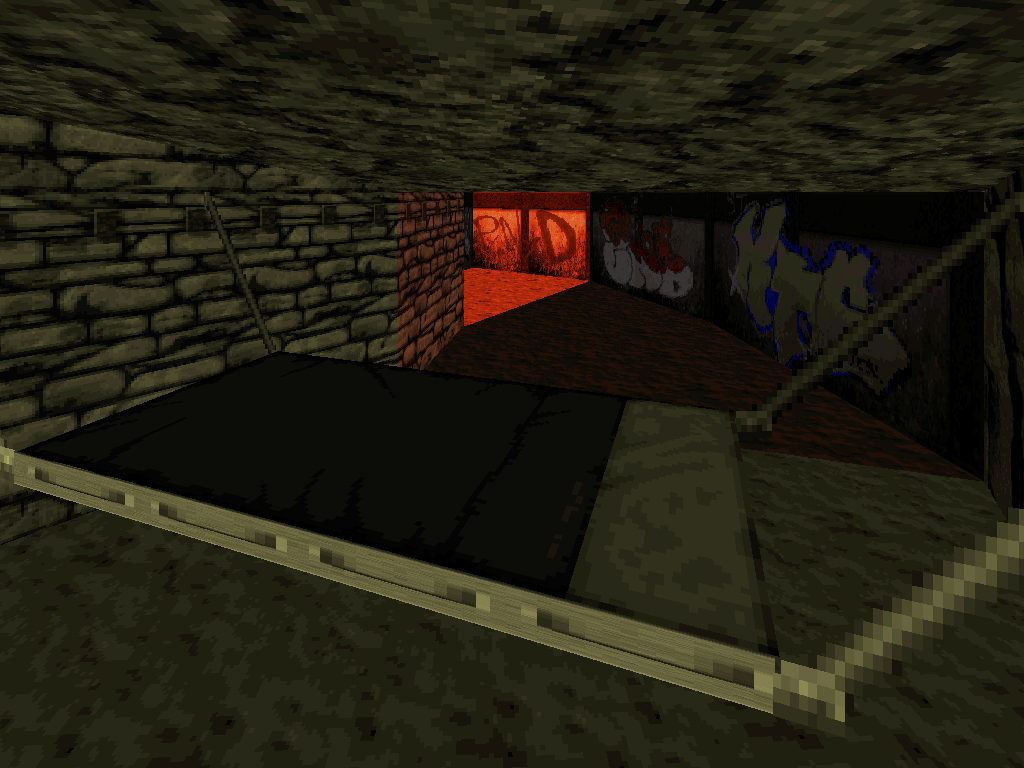
In "Lights, Camera, Revolution", Duke keeps running into an exponential amount of compartmentalized spaces and micro-regions to 'solve'; and also into the corresponding tally of exploration possibilities, whIch keep hinting harder and harder at - and eventually shall suck Duke into - at least part of a dictated path that seemingly persists at existing almost out of pure principle, as a strangely convoluted, yet really rudimentary line of traversal. Fundamentally, all Duke has to do is navigate from south to north, then north to south again (inside the museum), then across and through (blue key puzzle), then again once underground (the catacombs), then head back north again in order to unlock the exit, opposite to Duke's starting position in relation to the center of the map.
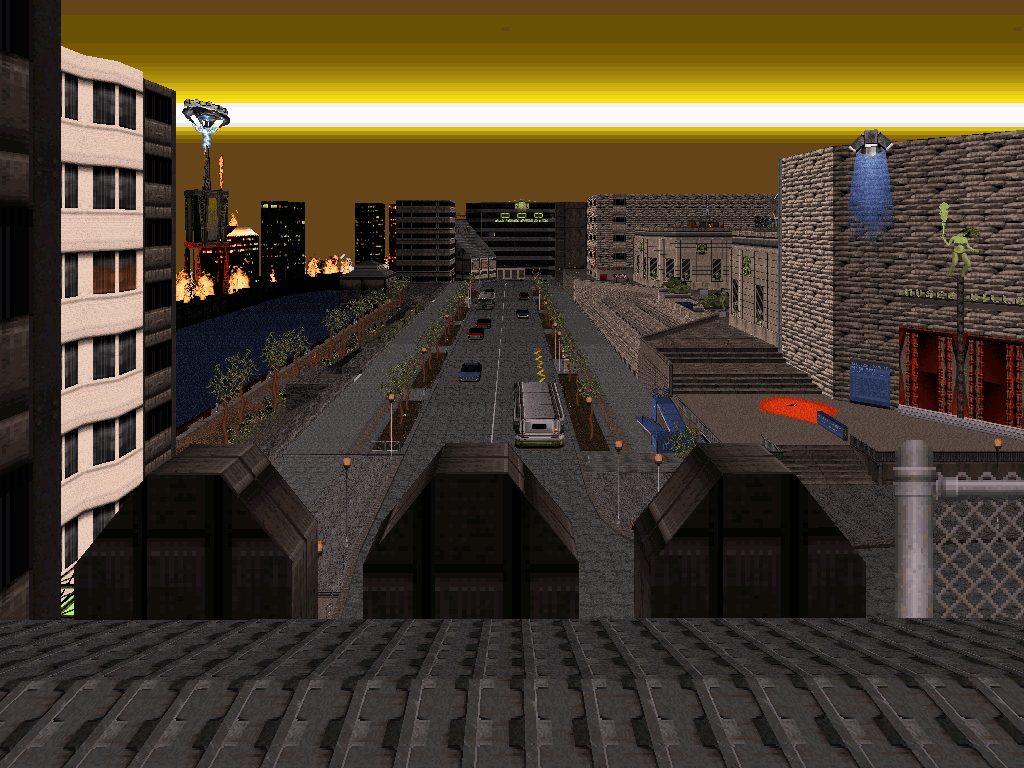
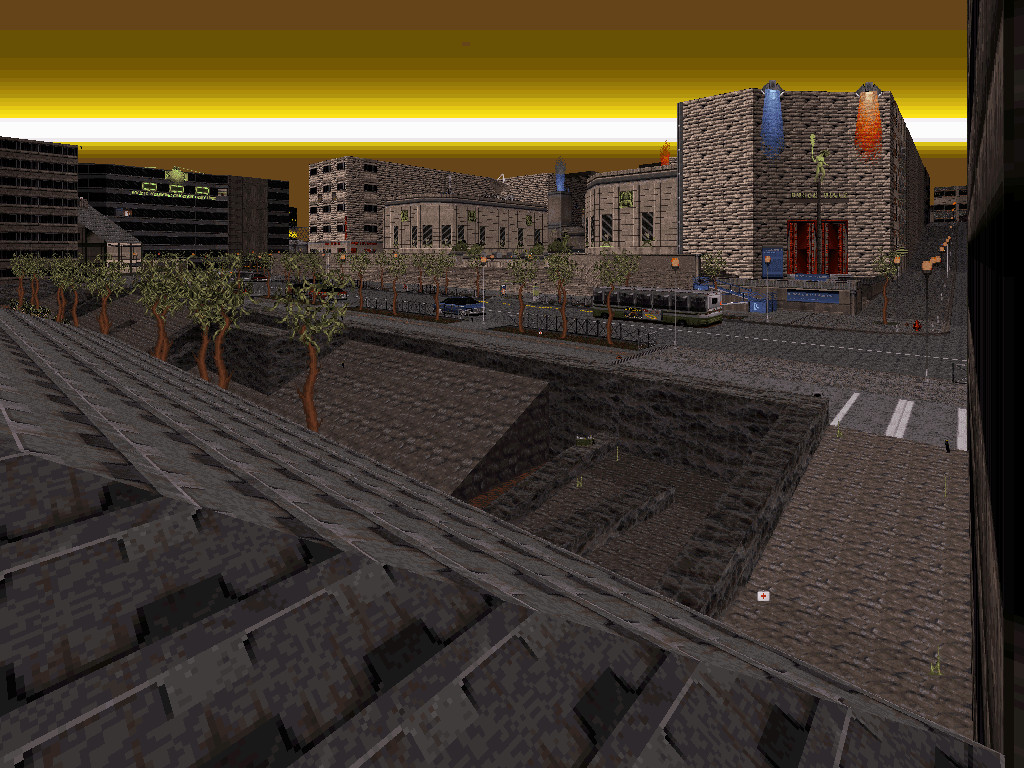
This 'map scanning' approach to level traversal will later confirm itself as a major principle in most of Blast Radius designs, as demonstrated as soon as the next level in the set: "Norilsk No-Reward" which relies on that concept entirely for all of its navigation, and was built much later.
A level set in and around the Paris Museum of Modern Arts and the off-limits catacombs turned out to be, in itself, quite the fantastic opportunity when it came to experimenting with a wild variety of sometimes eccentric creative concepts, bound together under the omnipresent, tricolor umbrella of the French theming, architecture and 'illuminated' mustard skies which by themselves never cease representing the simultaneously 'hip' and zany vibes.
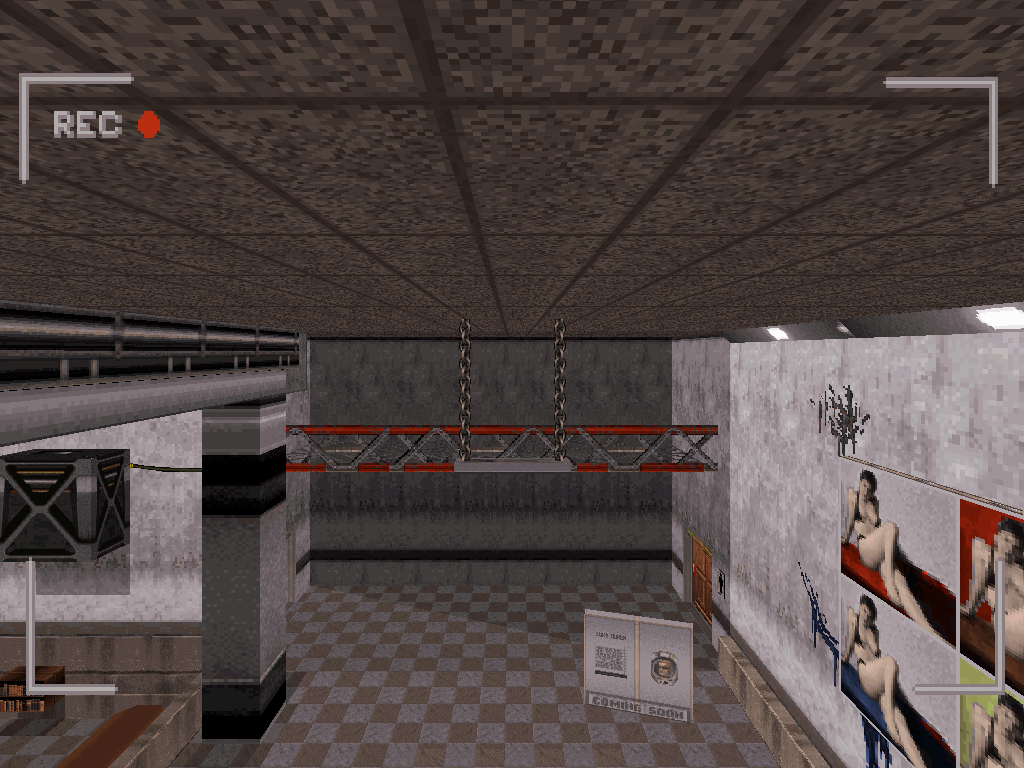
Maybe in a meta manner, the player and Duke both contribute to, and reinforce that environment by indirectly 'making art' as their shared peregrination through the museum in particular will keep leaving distinctively-shaped marks, until the entire level is 'defaced' and the entire museum building itself gives up to collapse. The most on-the-nose instance would be Duke's own, 'coming soon' show space which he does fill with the more he progresses, as exploding the fire extinguishers in both of the museum bathrooms will result in a rather direct, literal exhibition.
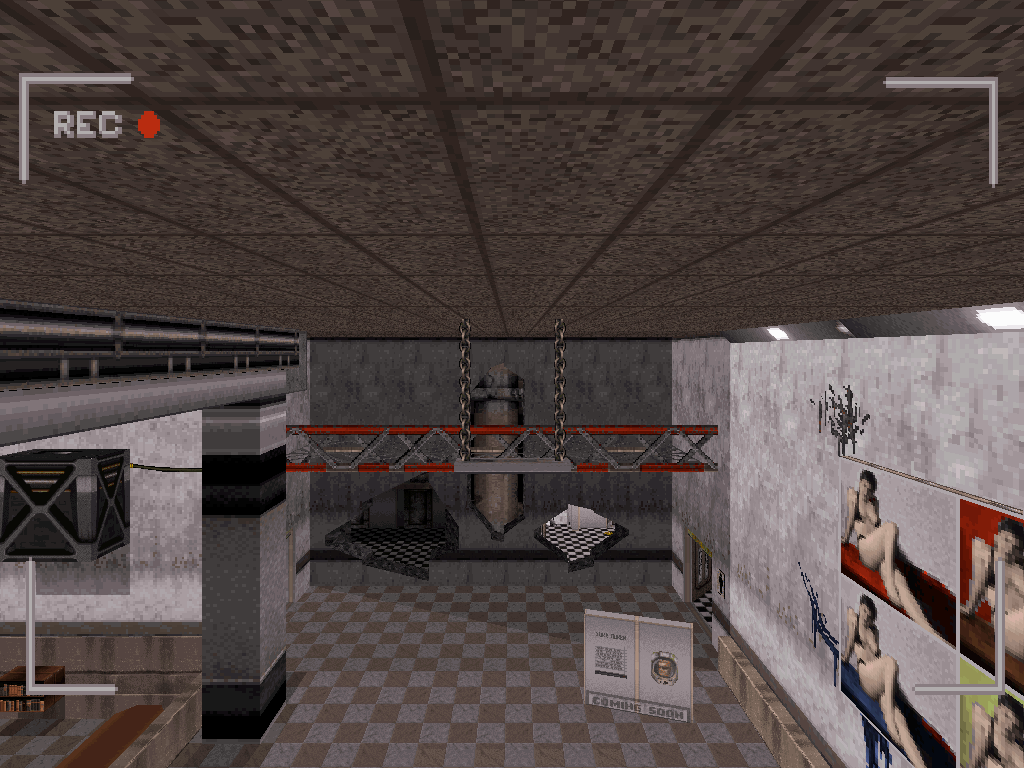
The enemies themselves now massively coming in mostly new tints of blue, white and red and the majority of their appearances being cinematically choreographed, "Lights, Camera, Revolution" intends to honor Molière's country by instilling the feeling of a stage play; the line of the player's perception keeps shifting between designs that resemble a closer attempt at realism and then all the bouts of saturated absurdity, which the contemporary art exhibitions (all referencing real-life artists) inside the museum, or places such as the catacombs only push.
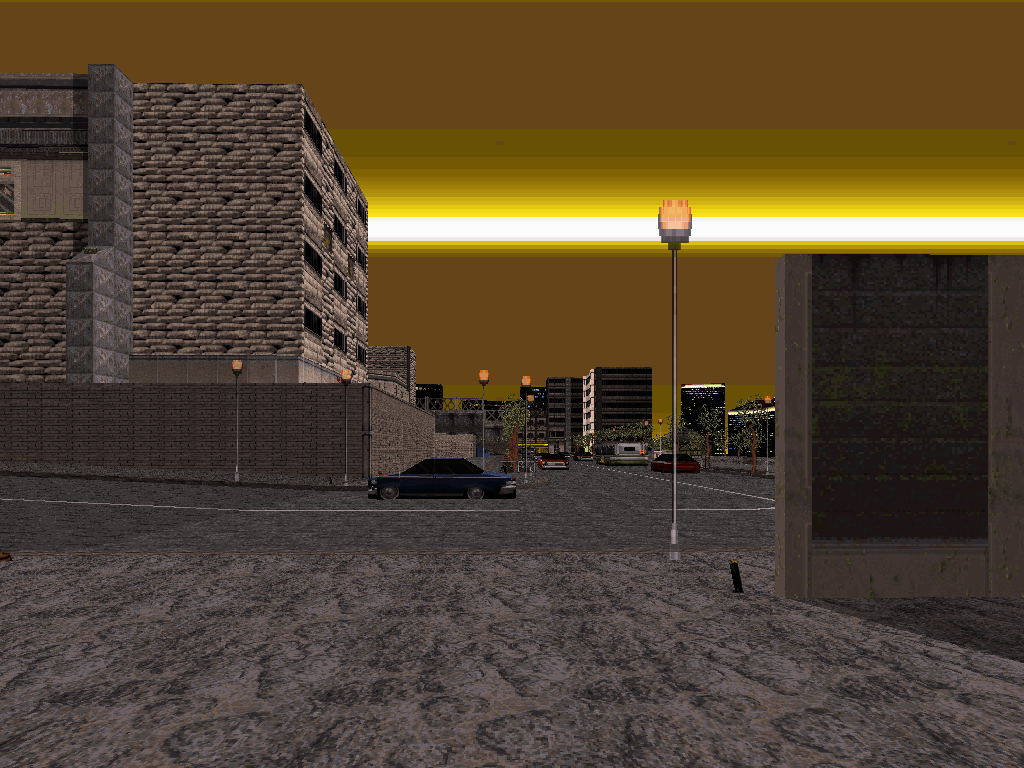
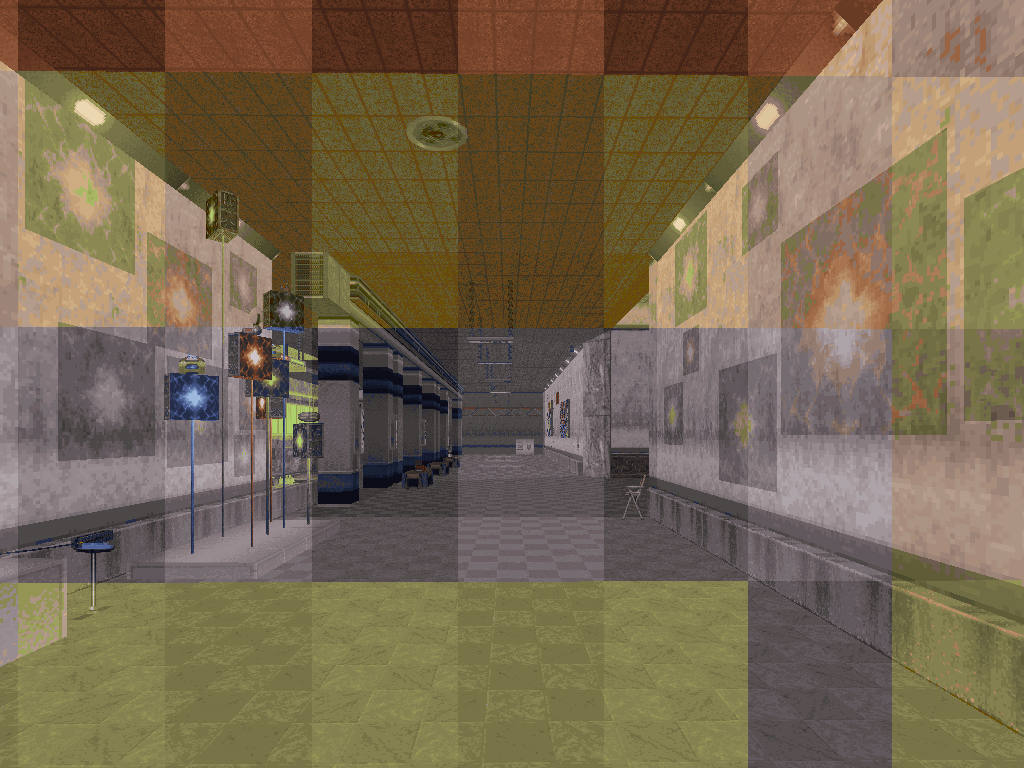
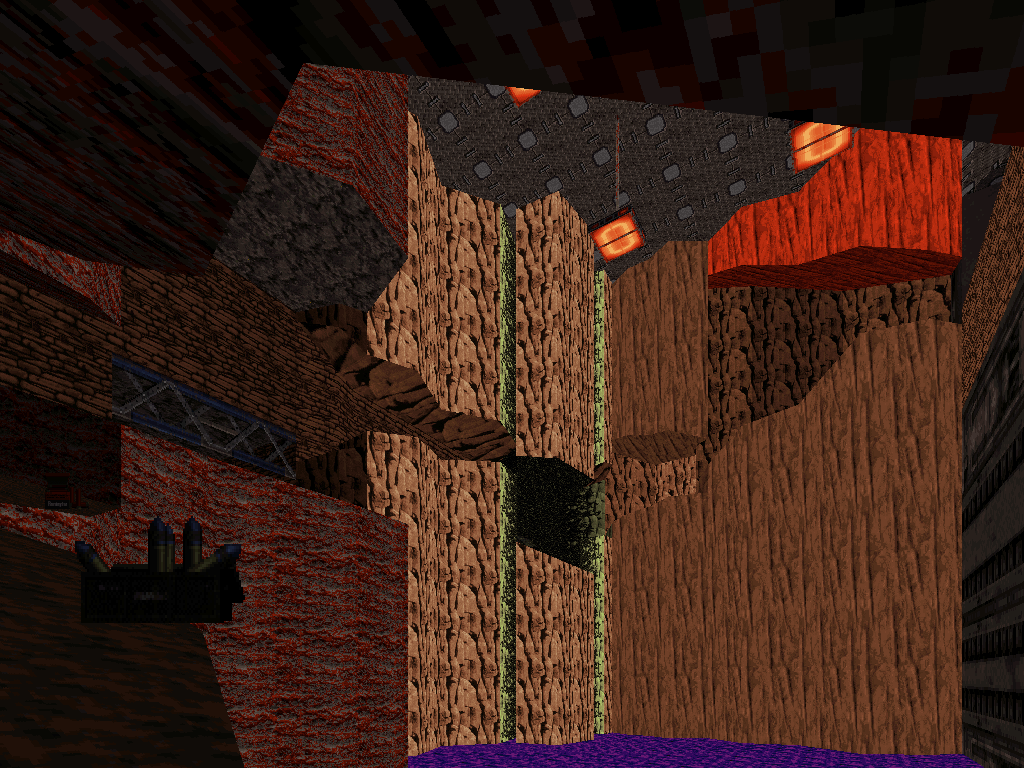
Speaking of the catacombs, they were an important point of focus and intrinsic part of the conceptualization whilst, if not even prior to, building the level (in addition to remaining an important mid-level tonal shift overall, sequencing its pacing). The real-life location is so impenetrably deep and expansive, doing the Paris catacombs any justice in Duke Nukem 3D/Build would warrant its own, entirely dedicated map set, complete with dark mazes and unique puzzles; a high-fidelity recreation also would be close to impossible not just for technical reasons, but out of respect for the real-life Paris community of cataphiles who do tour and sometimes live in the catacombs and mines and are welcoming to newcomers, but also rightfully cultivate some strong ethos regarding the place and should be left alone.
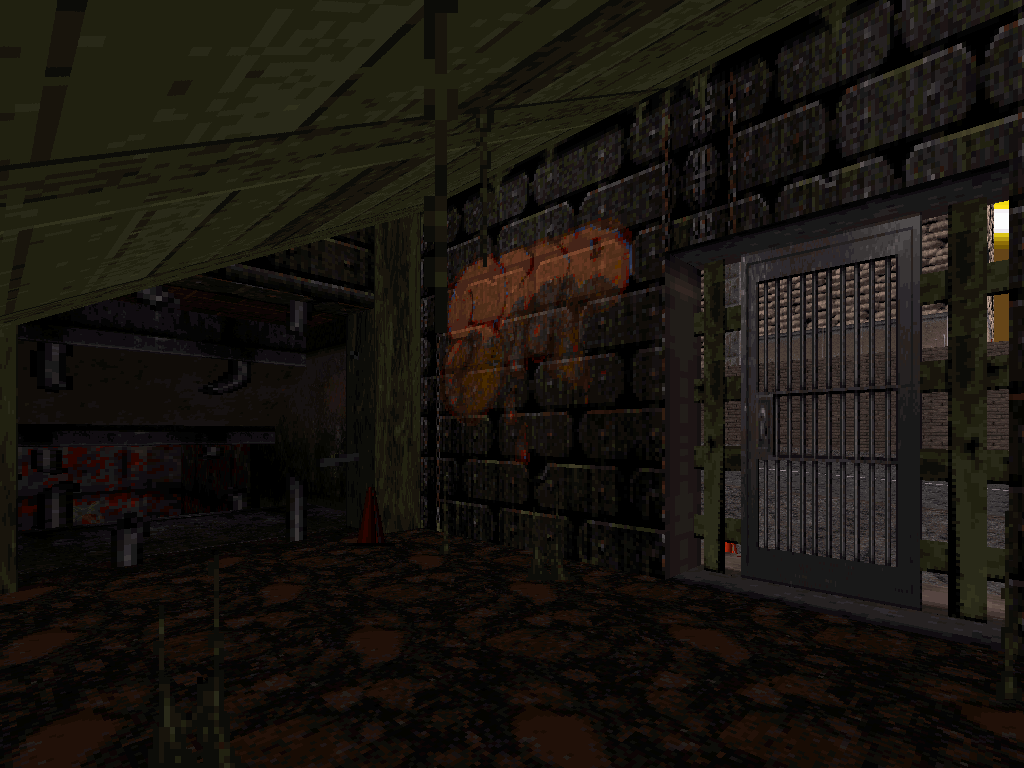
And so the goal and challenge here was retelling and retranscribing the general experience of 'descending' underneath the Parisian urban surface all the while sticking to imaginary, semi-abstract designs which would only occasionally loosely reference some accessible landmarks but otherwise strictly rely on reproducing the feeling, at the pure service of (arguably) practical level design. All the weirdness Duke will run into in that underground layer of the map - alien corruption aside - is justified by real features and potentially lethal hazards of the catacombs: flooded areas, claustrophobia-inducing chatières, tunnels and holes, the occasional trace of human occupation with the hammock, candle or graffiti and even the exceptional cave-in.
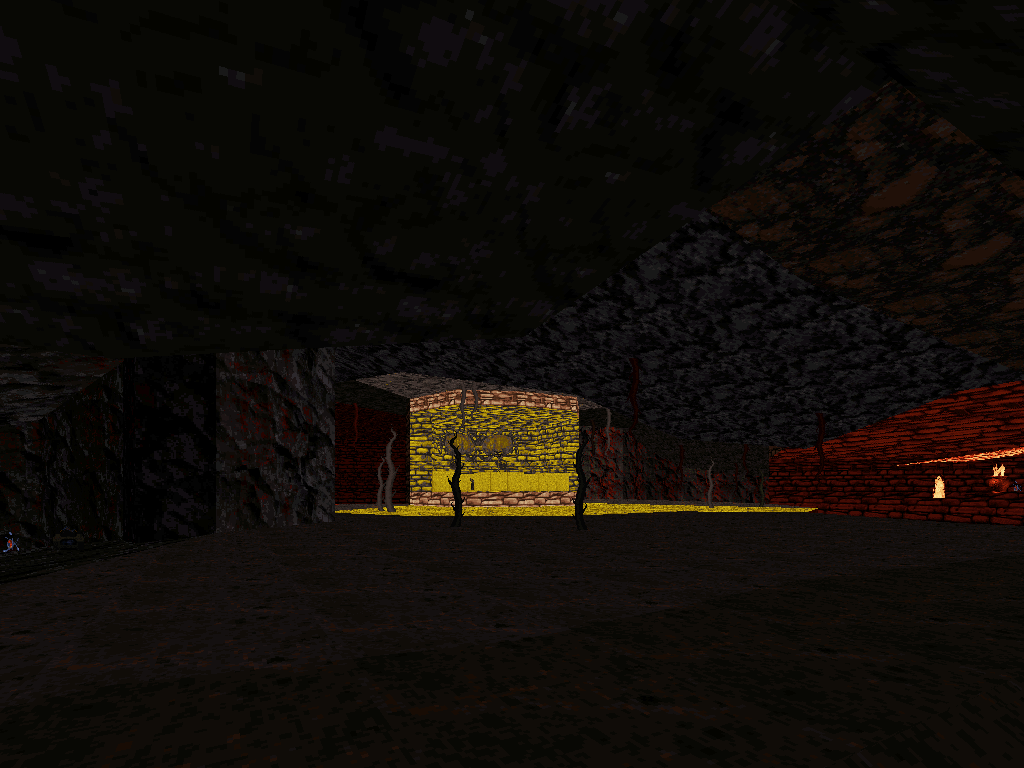
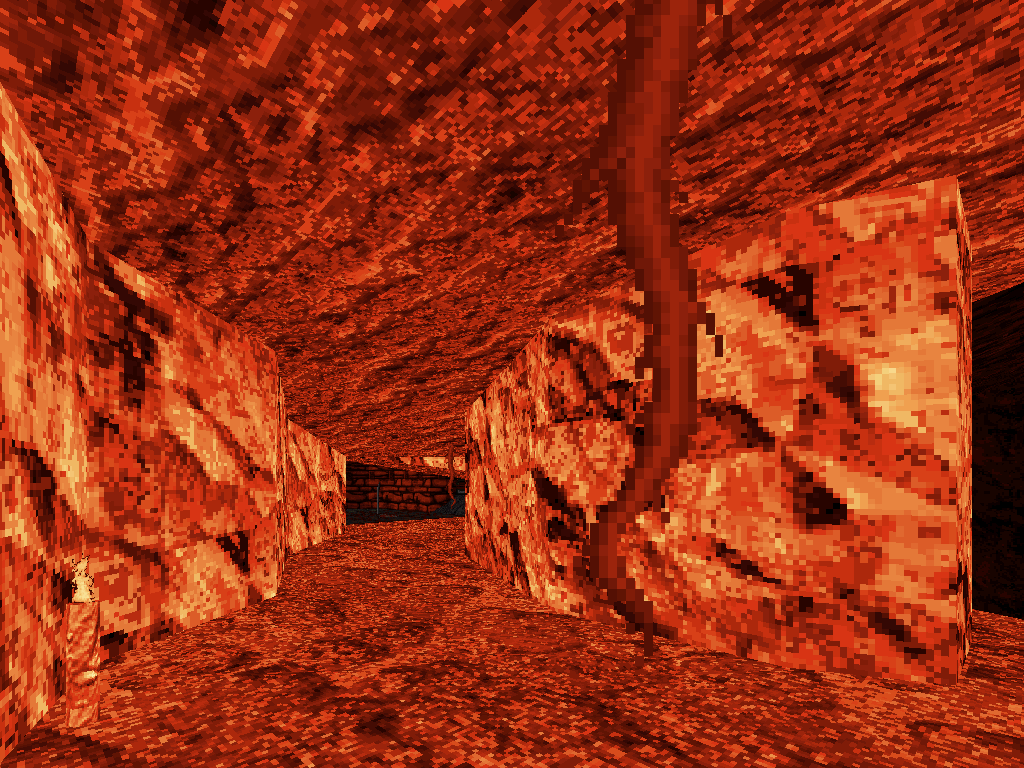
It's an entire rabbit hole to, literally, go down and explore if one is interested, comprising various local, oftentimes amateur video documentaries by passionate enthusiasts throughout the decades that aren't exactly difficult to retrace on YouTube. As a possible starting point, one can skim through the example, below.
Playing with the general symbolism of the real-world place and of its singular existence also lent itself rather well to many established, traditional Duke Nukem 3D codes, with the underground shrinker ray puzzle being reminiscent of the one in the base Duke 3D level by Richard 'Levelord' Gray: "The Abyss", with a thematic twist as the solution there is directly provided by the dormant spirit of Philibert Aspairt.
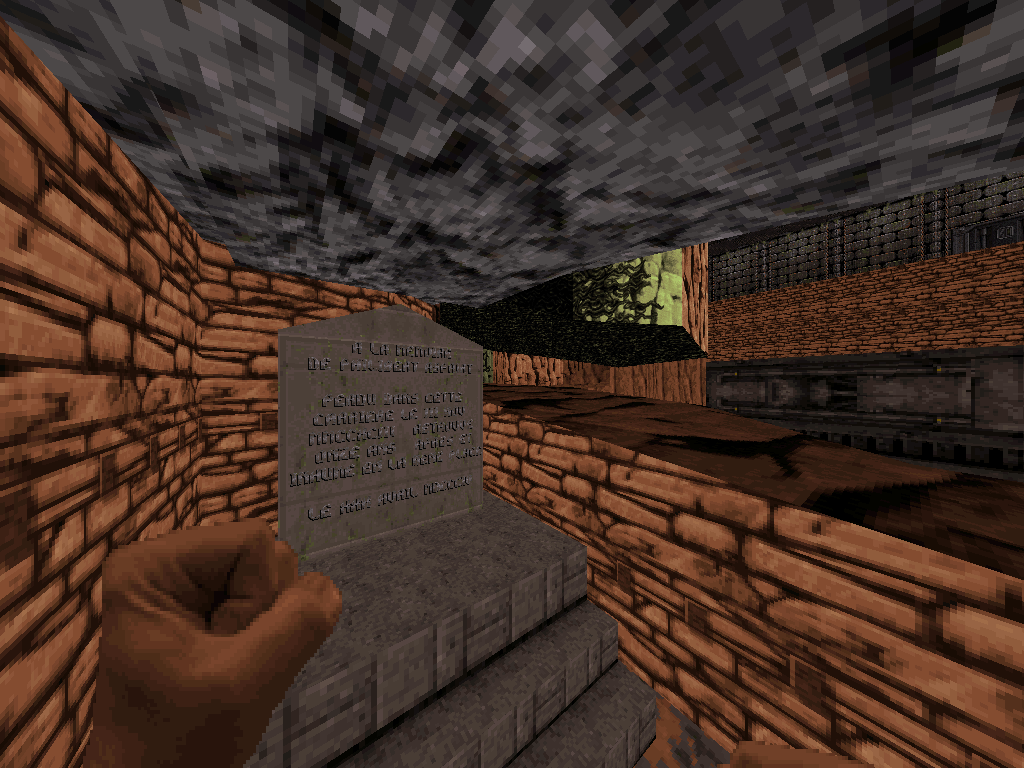
Another strong note is when Duke realizes, towards the end of "Lights, Camera, Revolution" how he just rode a lift back up from a morgue and by doing so, metaphorically rose back from the dead in a way that was completely spontaneous; also helping finalize for good Duke's spiritual rebirth, now completely estranged from America and firmly footing formerly foreign ground.

As alluded to earlier, "Lights, Camera, Revolution" most possibly happens to be the richest Blast Radius level in terms of Easter eggs: they are omnipresent, even though it might take being French to comprehend even the most accessible of them, as they are most often - deliberately and fittingly - more or less deeply rooted in French culture.
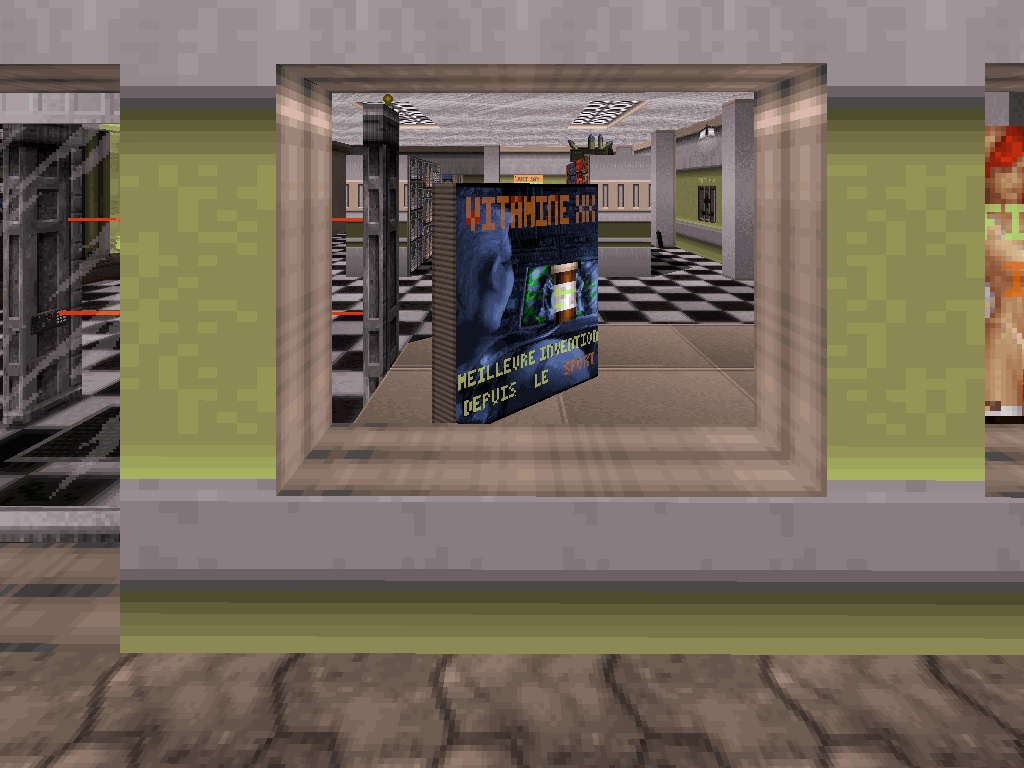
I'll only explain one of the most major ones, as the entire blue key room revolves around it. In the popular 1995 French comedy film "Les Trois Frères" by Didier Bourdon and Bernard Campan, also featuring Pascal Légitimus as to honor the legacy of their usual trio: Les Inconnus, Pascal Latour is an upper middle class, sophisticated Parisian who works in advertising and part of a trio of brothers all learning about, and meeting one another for the first time around the passing of their common mother, a late pop singer.
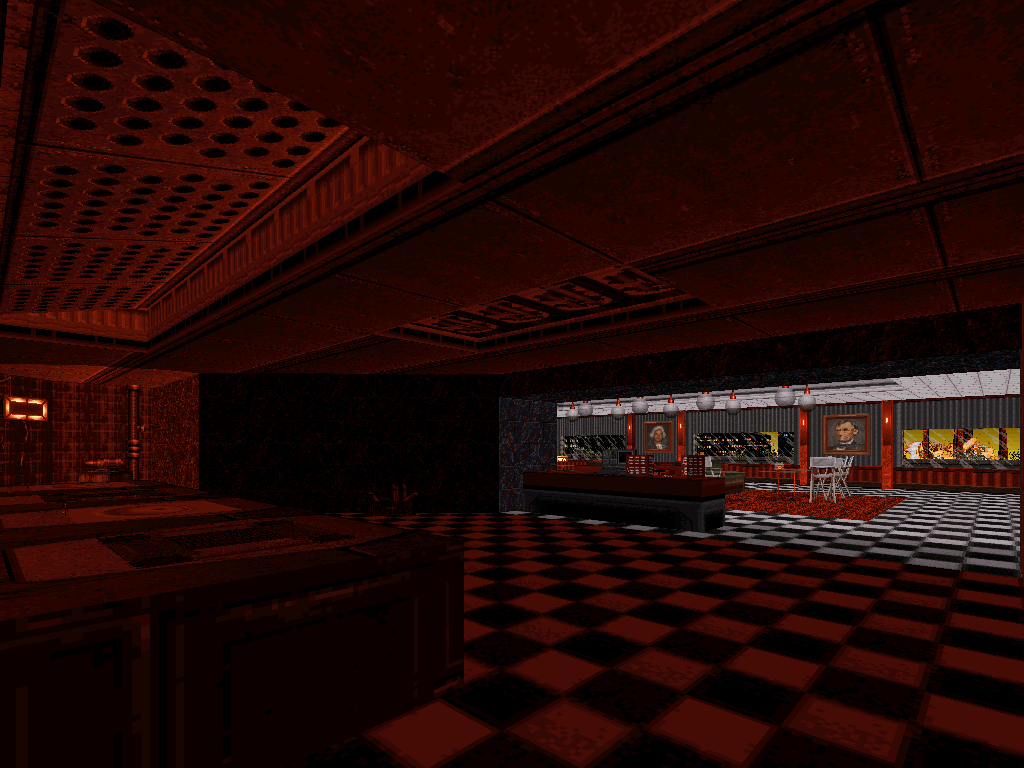
Following several brutal twists of events resulting from everyone's introduction not just to formerly unknown siblings, but also of unfamiliar cultures and classes, the three separate existences naturally degenerate to the point of convergence where not just the trio is forced to live under Pascal's roof, but one of the brothers also needs to take his young kid in (who then becomes the rest of the story's primary catalyst).
One of Pascal's most prized (and expensive) possessions is, out of his quite fantastic modern art collection, "Monochrome de Whiteman", a pure white, blank-looking canvas the surface of which is only (but noticeably) marked by its author's signature.
One big turn in the film's sequencing is when, later, Pascal realizes his brother's kid had 'defaced' his invaluable "Monochrome", by assuming it was a blank canvas and, therefore, taking the initiative of drawing a reunited family on it as a surprise.
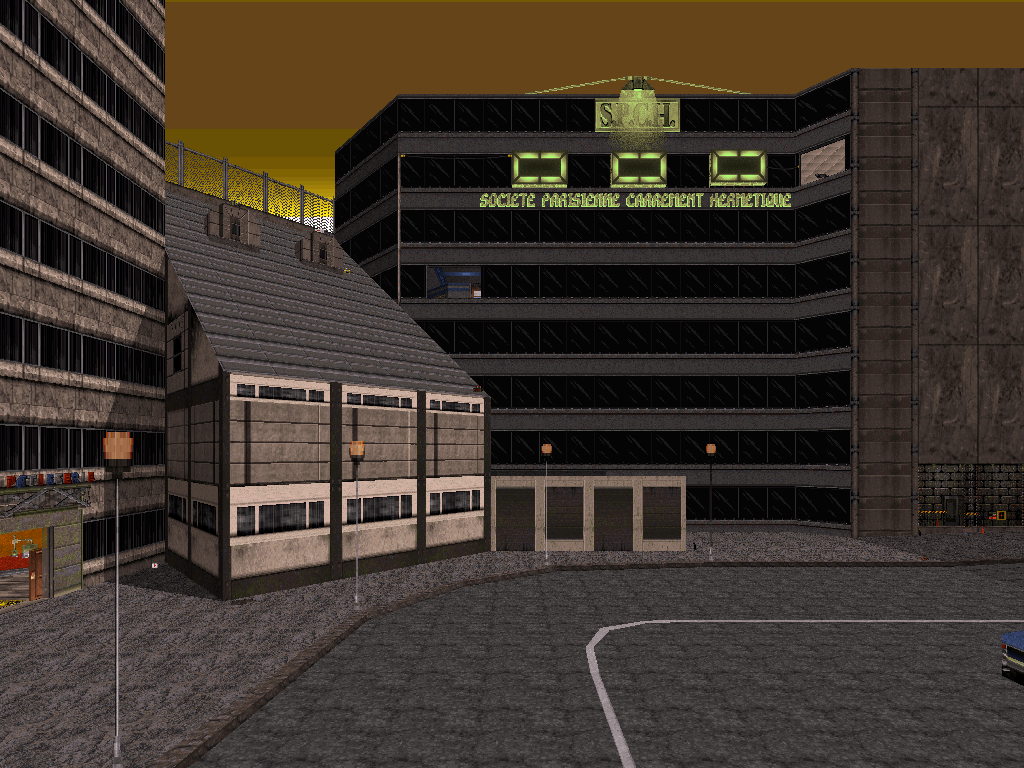
The whole of the blue key room sequence in "Lights, Camera, Revolution" is a direct reference to that scene, with the "Monochrome" escaping Duke's sight only for however long fetching the item takes him, then meeting it again a split second later, but already defaced.
The culprit already is gone, too, but they put a song on: "Doux Daddy" by Catherine Ringer from Les Rita Mitsouko, used for the film's credits roll and, in its story, playing the role of the one hit song ever recorded by the trio's common mother; a record of which ends up being their only inheritance after repeatedly risking, then losing millions of francs to the system, in part because of corrupted administration but, ultimately, also due to the mother's eccentric personality which at this point can no longer be questioned, since it birthed the entire story in the first place.
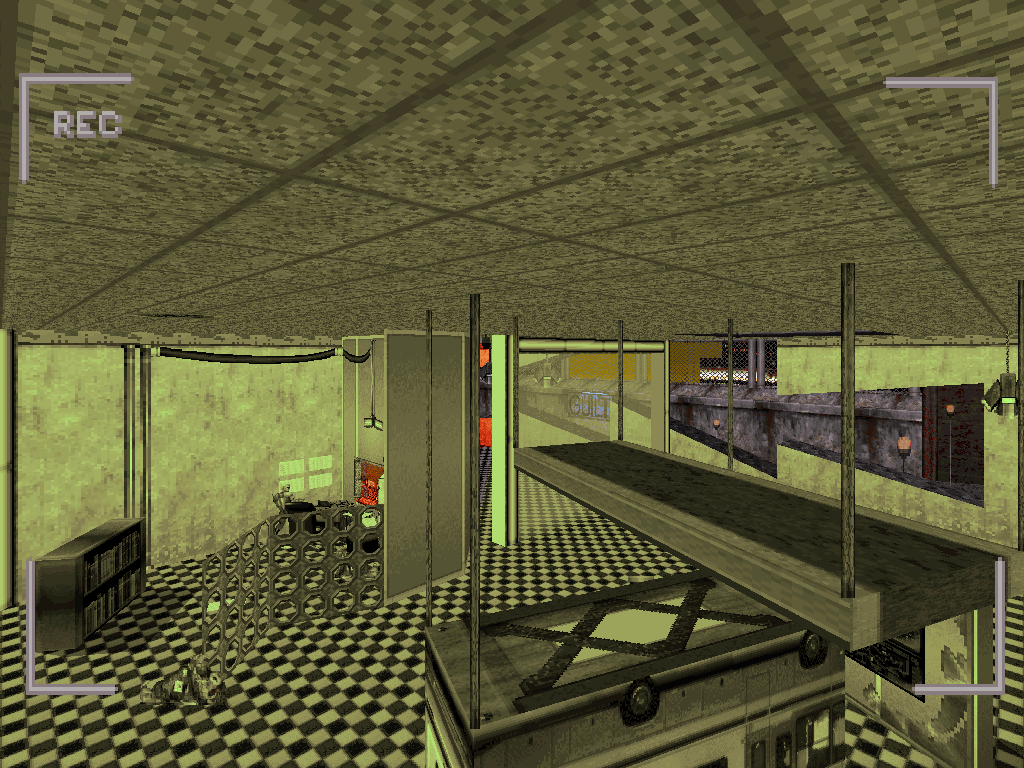
Finally and in pure Blast Radius fashion, if Duke just isn't in the right mood for riddles, culture, existential questioning and even Oprah, then he's completely free to skip the entire level altogether, as literally every key and door can be bypassed if he tries. While that is facilitated if not downright evidenced once stocked up on jetpack fuel, it's possible for him to complete "Lights, Camera, Revolution" in just a couple of straight cuts, any given time.

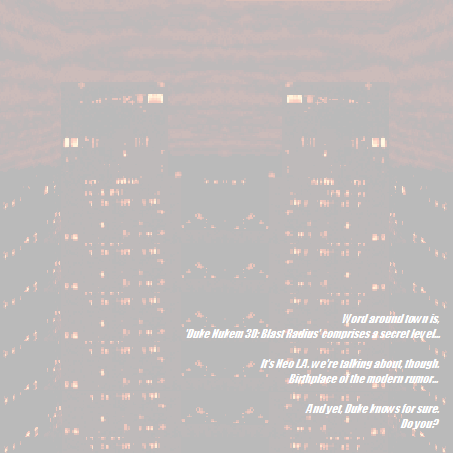
Page from the manual.
(SPOILERS)
Secret exit:
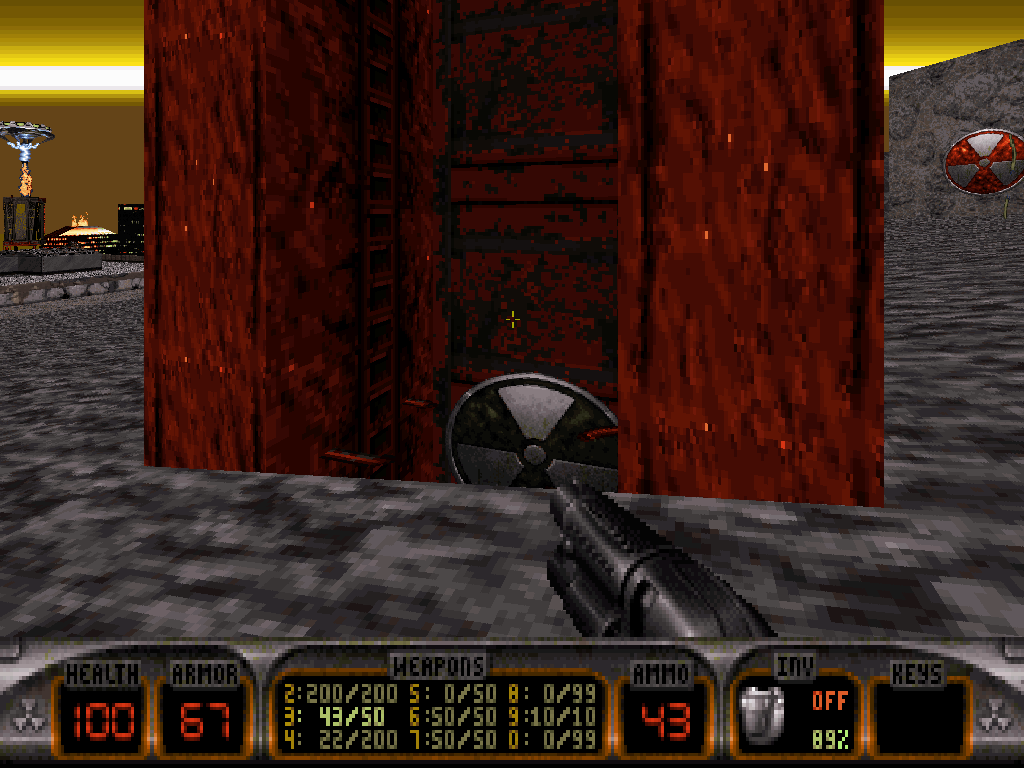
"Lights, Camera, Revolution" features the hidden Nuke Button to Blast Radius' secret level, "Duke Du Quatrain", which is set in the nearby town of Blois, France and experiments with a form of Metroidvania-styled progression based on use and abuse of most of Duke Nukem 3D's inventory items.
In contrast, the next level in the normal rotation: "Norilsk No-Reward" essentially is raw, fast-paced action from start to finish with only the exceptional breather to stop and think.
Important technical reminder: Blast Radius doesn't support the Polymost renderer (which EDuke32 sometimes selects by default) and wasn't just designed, but really is only compatible with the classic/software renderer (which can be switched to any given time in the in-game menu, usually under Video Mode). While the resulting issues from insisting with Polymost usually are benign and, most of the time, cosmetic, both "Duke Du Quatrain" and "Norilsk No-Reward" in particular will be straight up unstable in that mode, then possibly generating very unique glitches and/or causing game crashes.
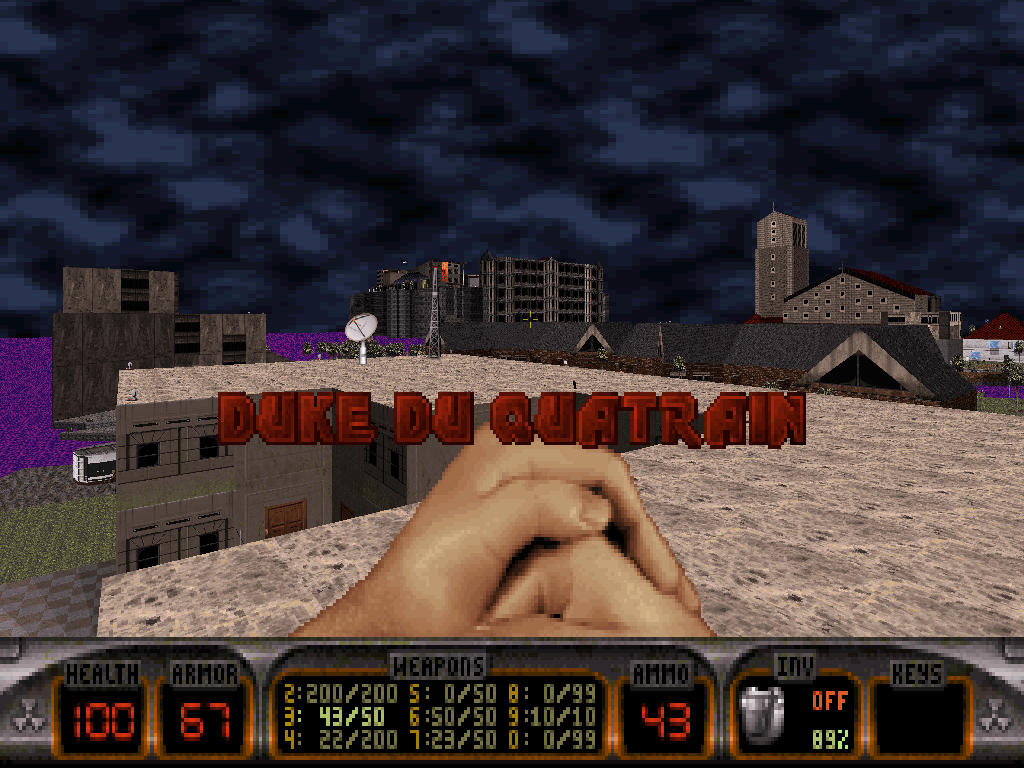
A proper secret room to host the Nuke Button to "Duke Du Quatrain" is one more of those earliest ideas for "Lights, Camera, Revolution" the eventual implementation of which had to be simplified upon progressive completion of the actual level design process, in order to remain within the present limits of the Build engine.
Originally, Duke would have blasted a hole into a wall somewhere underground (either from the eventually non-existent subway system or, later, that one odd, dark corner with the pillars in the catacombs), then our hero would have crept his way through and into an entire surprise train station just to find the green Nuke Button there. Then as the level and project altogether progressed, it became not just apparent but also evident how those original ambitions now really needed reevaluation, and plans for the secret exit location kept changing and changing (for a hot minute almost crash landing for good inside the collapsed wing of Palais Galliera) before finally finding solace in the K.I.S.S. ('Keep It Simple, Stupid') approach, and fully embracing conceptual symbolism instead.
Sitting just there in plain sight, right next to the normal exit but just around a simple corner is in itself quite the straightforward representation of Blast Radius' general attempt to reflect their own habits back to the player who then might or might not realize how, depending on one's particular angle of approach to the game and the differently developed dimensions of their respective play styles, the exact same basic task can either be completed effortlessly - even by accident - or turn out to be the most impossible struggle in the world.

Soundtrack:
"Love Me, Please Love Me" by Michel Polnareff / "Michel Polnareff" / Disc'AZ, 1966 (MIDI version)
This choice actually came up quite late in development and is one of my personal favorites out of all the .mid tracks featured in Blast Radius.
Original plan (prior to even starting building the level) was to use a MIDI rendition of "Le Poinçonneur des Lilas" by Serge Gainsbourg, the lyrics of which continuously revolve around the Parisian subway system as a central allegory all the while comprising a chorus about "ripping new holes", and relying on a simple, fast, strong bass loop bound to fit Duke Nukem 3D-styled rapid action just right.
Once the actual map finally complete, however, upon testing, it became evident how the level was too long and varied to comfortably accomodate such a short, upbeat and straightforward song - which itself would start suffering, then, from the progressively overwhelming redundancy of the repeated loopings.
In order to avoid such negative audiovisual feedback, the Serge Gainsbourg got, first, relegated to Blast Radius' secret level, "Duke Du Quatrain" where even there it eventually was replaced last minute by a Daniel Balavoine track, then canned from the project entirely. The decision also was motivated by the eventual absence of a subway system (to match Gainsbourg's topic) from "Lights, Camera, Revolution", which had been part of the original plans but finally contradicted by two factors: technically, running out of available Build engine walls and, conceptually, an effort at restraint so that the MTA in "Big Apple Smoke Toke" would feel all the more unique.
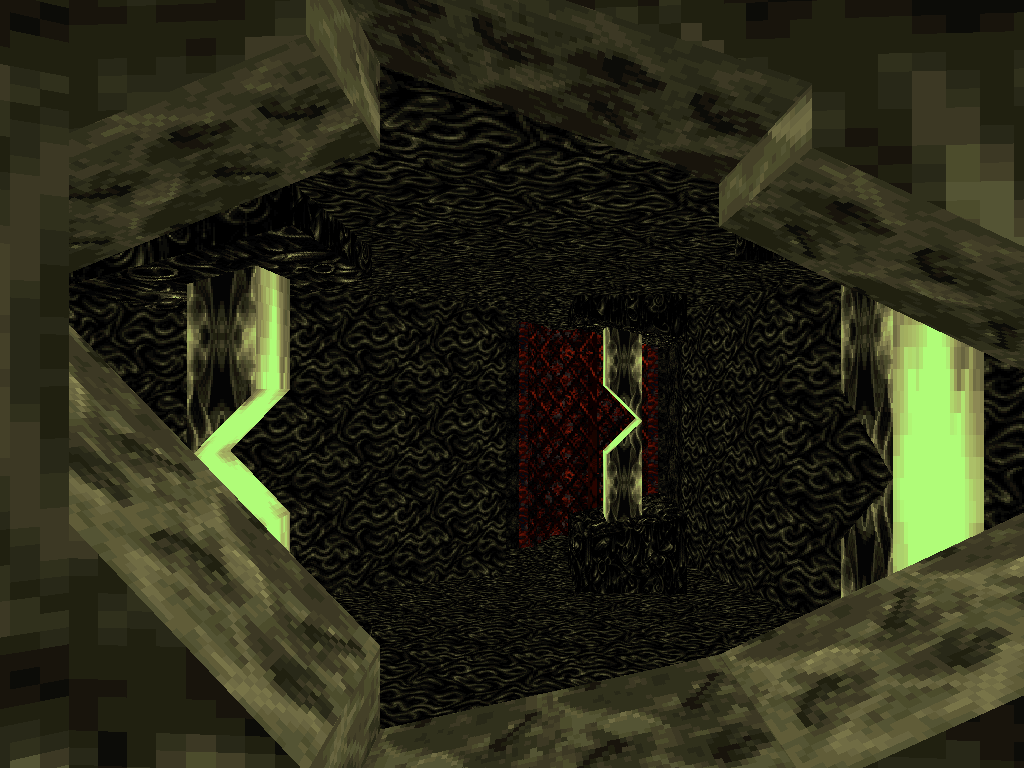
In search of something which would be just as deeply rooted in French pop culture, but maybe more contemplative and uplifting in tone as to also match the 'illuminated' European thematics (inspired by the 17th and 18th century Age of Enlightenment but also reflecting, titularly, Jonathan Safran Foer's 2002 novel: "Everything Is Illuminated"), I started looking in an alternative direction and my next immediate idea would be something out of Michel Polnareff's crazy repertoire.
The thought of associating the tunes of his first ever hit song: "Love Me, Please Love Me" to a Duke Nukem 3D level felt just as daring, until I tried it and decided it would be a match as soon as the first piano loop. Walking around "Lights, Camera, Revolution" to this new music, instead of gritty, now felt like traversing an interactive collage of extremes with personality shining through and through, as cast directly and all the way from both eccentric universes - now united by circumstance.
In spite of its relatively giddy musicality (especially to the untrained French ear) and upbeat arrangement, "Love Me, Please Love Me" really is a profoundly heartbroken song with plentiful interrogations to fate and fatality in and of themselves.
On the absolute contrary, Duke Nukem 3D is a notoriously gloomy, sometimes dark, almost dystopian game and yet one which, at the end of the day, really is full of hope (represented by the protagonist and player's actions) and very colorful, borderline cartoonish (but always artful) environments and 2D sprites.
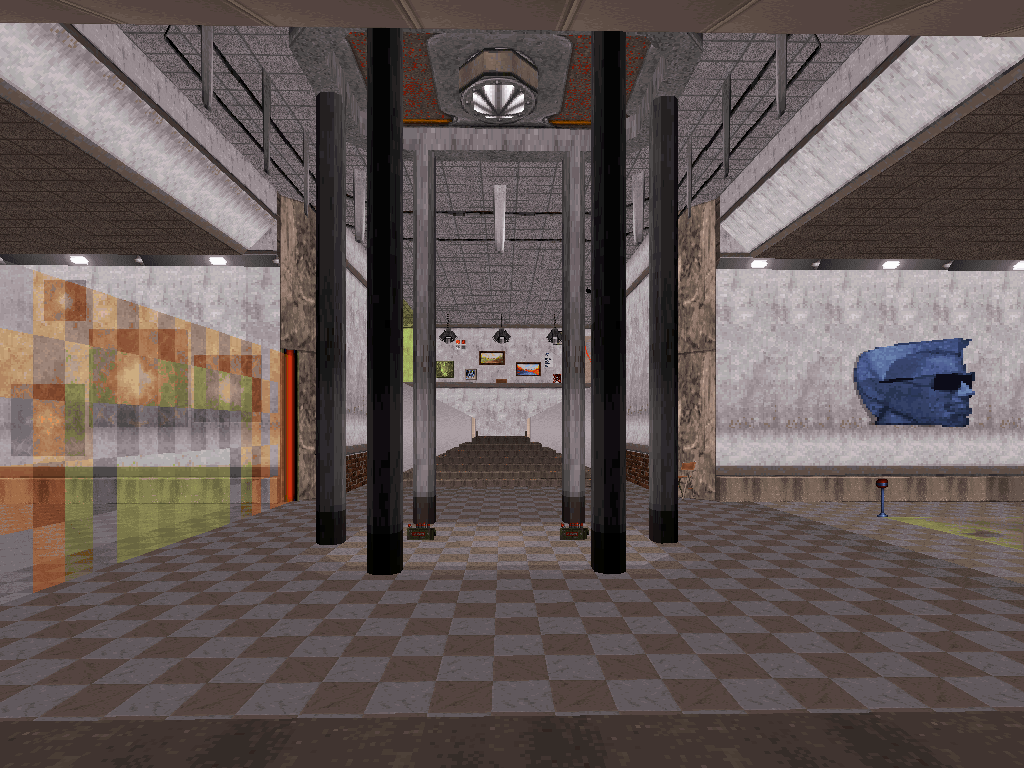
Both elements of the ensemble never contrast nor confuse any more than they originally may for a minute, upon discovery of the unexpected association.
As the level actually starts, doubt starts diluting as both worlds progressively confirm that they do intend to merge in unison around an agreement of two connected cores: the French level thematics, complete with the occasional, relative raunchiness that is a common trademark of both Duke's and France's respective reputations despite an actual duality with more of a torn side than meets the eye; and, almost by extension, Duke's ego: "Love Me, Please Love Me" sounding like one of his most sincere drives, be it when it comes to the lengths he will go to save humanity or when the moment comes to write a book and so, his most personal possible plea.
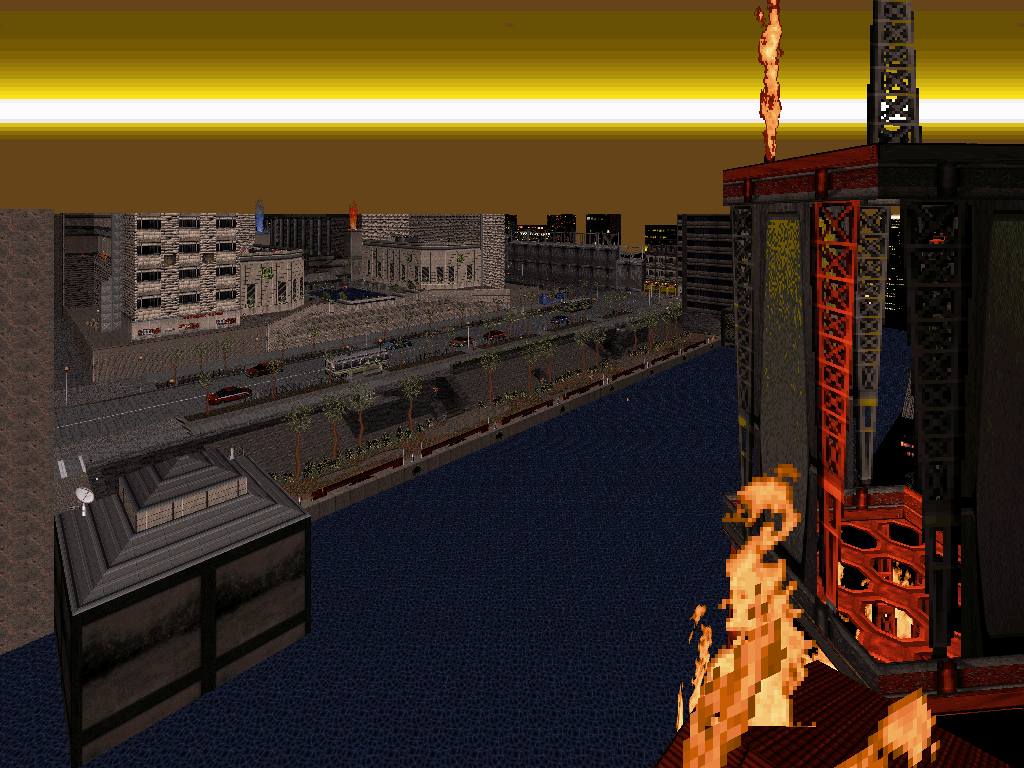
Spoiler alert: albeit still mostly unexplored thus far at this point of the episode, Duke's ego really will later be revealed as absolutely fundamental in all the Blast Radius story events. Therefore, the opportunity to subtly fluff the concept exactly halfway through his progression for the span of the central level was impassable.
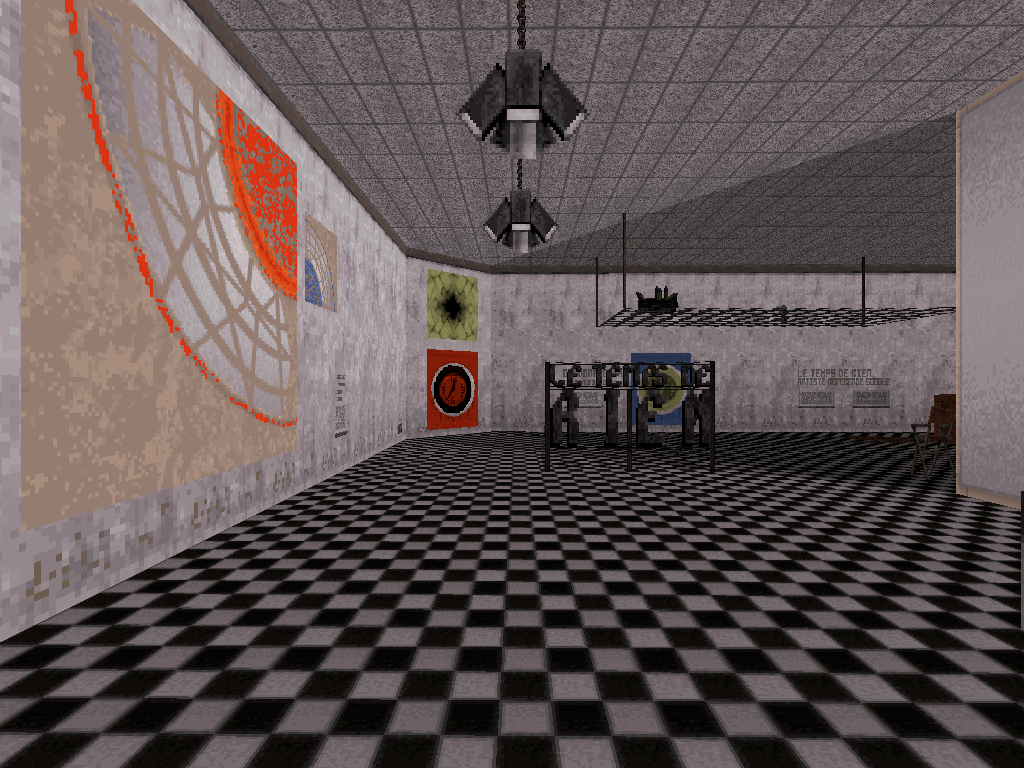
Last but not least - sometimes and only sometimes, whenever the portion of the song loop that is presently playing happens to slightly miss the beat of the current in-game action, the coherence of the established facade might start cracking again for a few seconds, reminding the player of the supposed mismatch; whilst such breakages in immersion are undesired usually, here in order to complement the intended 'stage play', composed and orchestrated feel of "Lights, Camera, Revolution" might in fact function really well.

Automap:
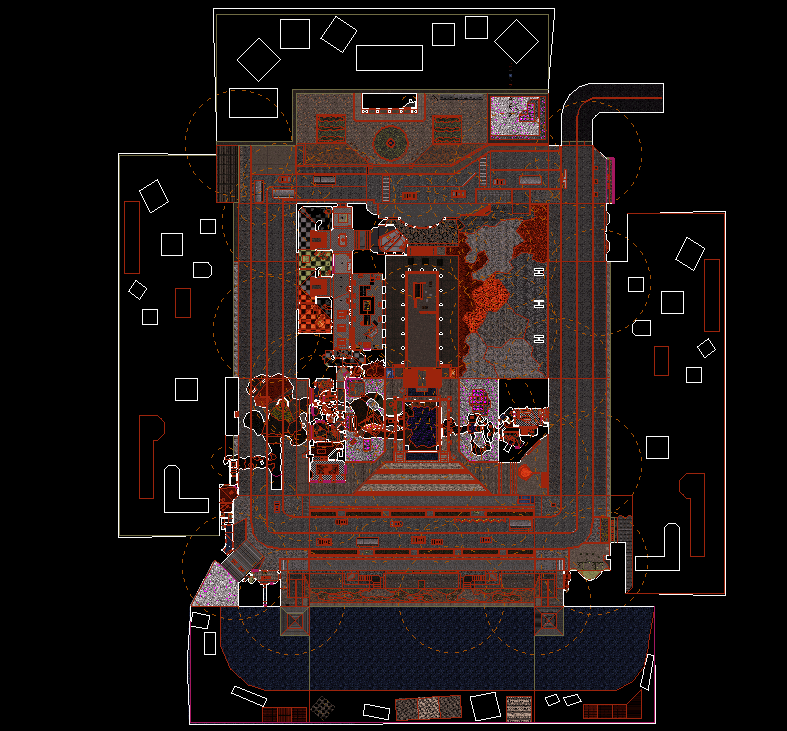
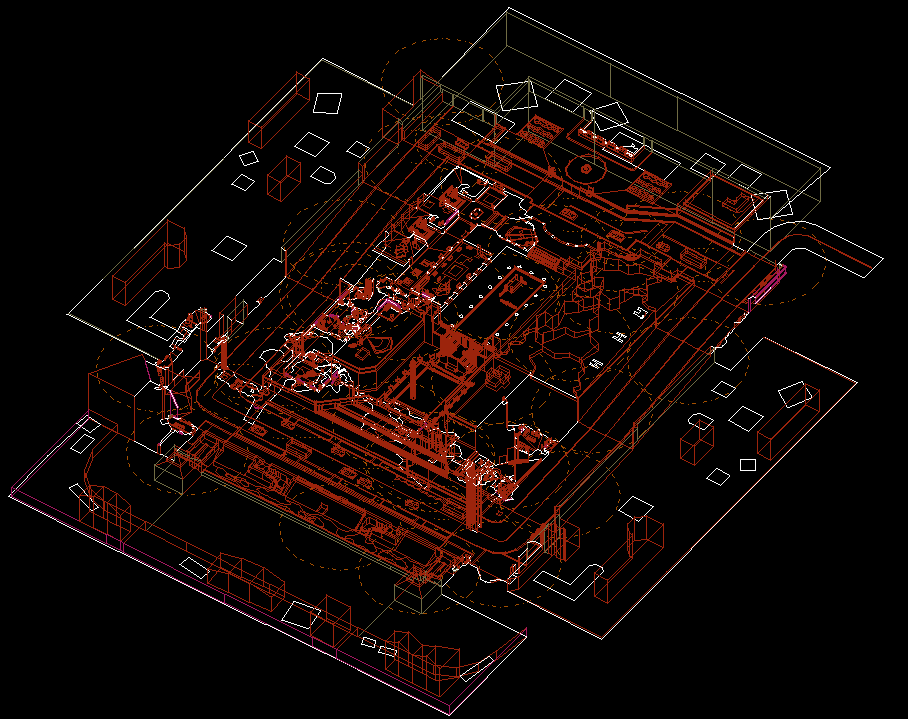
Map stats (as of v. 1.0.12): 2030/4096 sectors, 16383/16384 walls, 9267/16384 sprites.

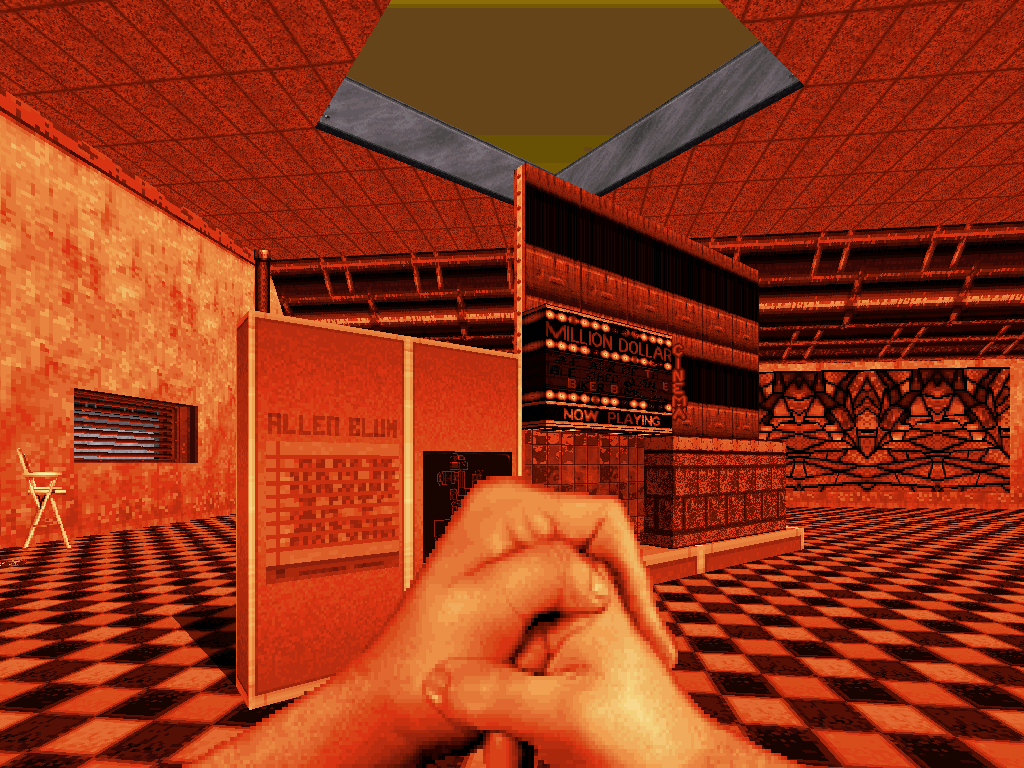
Download Duke Nukem 3D: Blast Radius (last update: 03/04/2024; v. 5.0.2)

